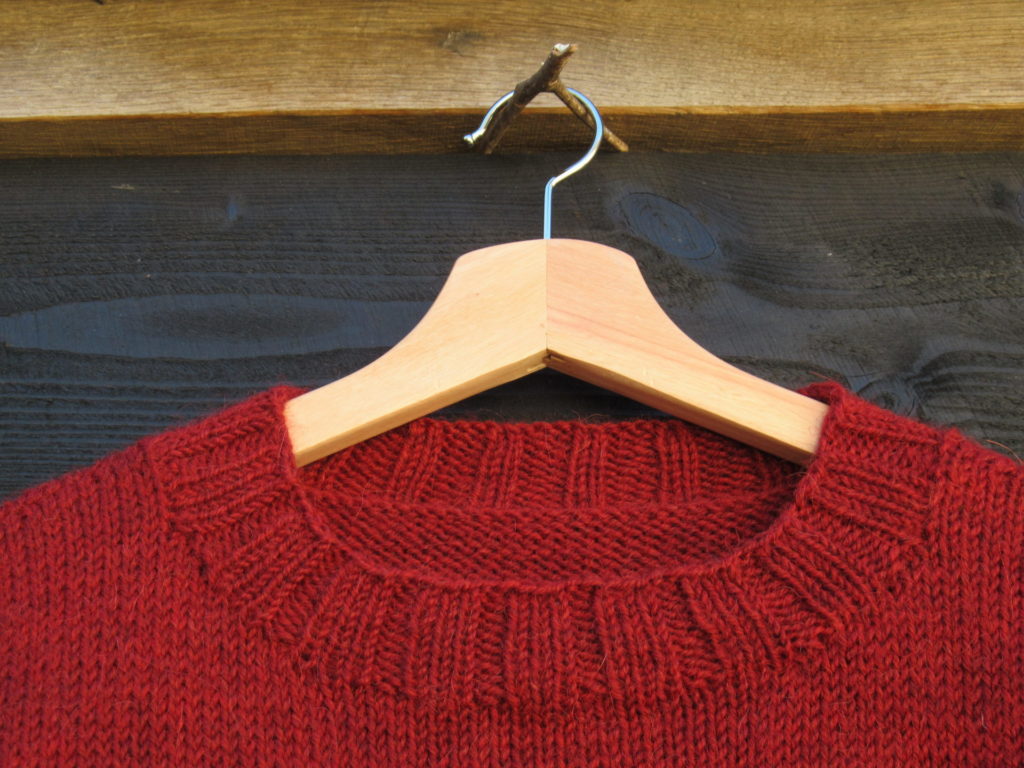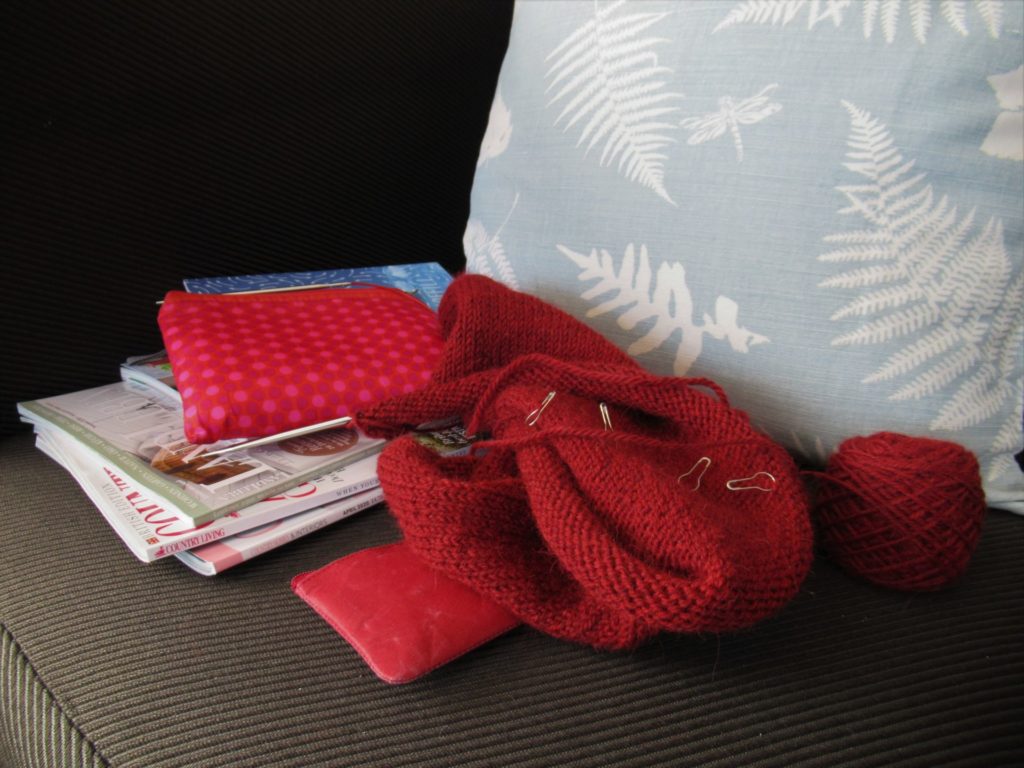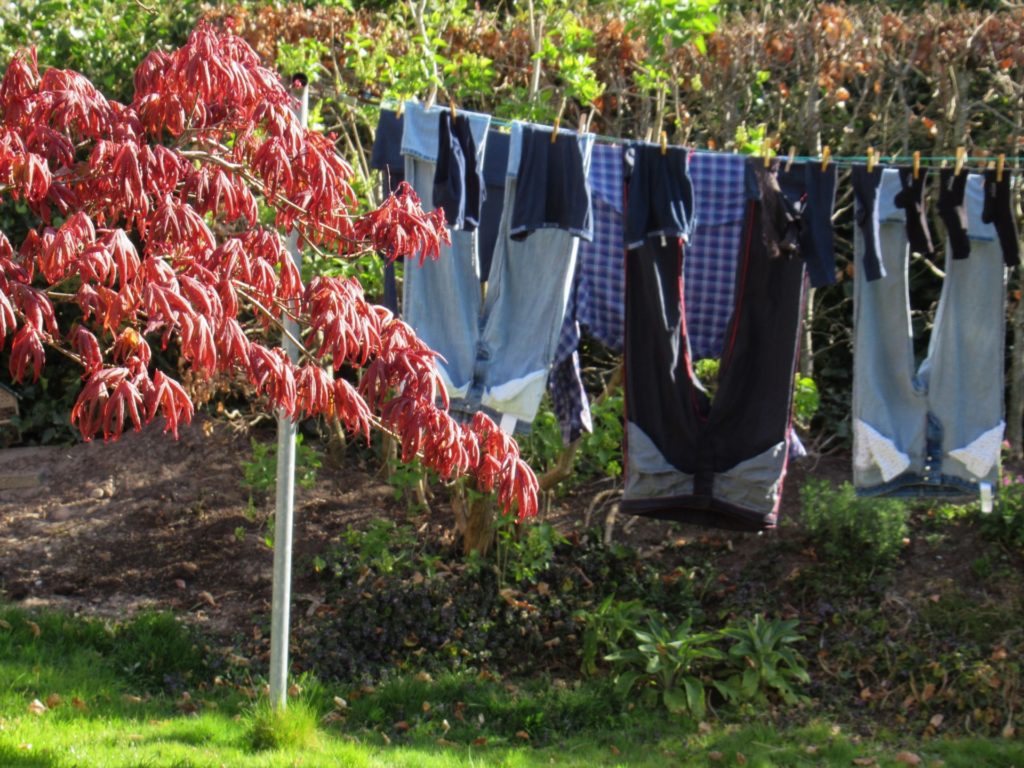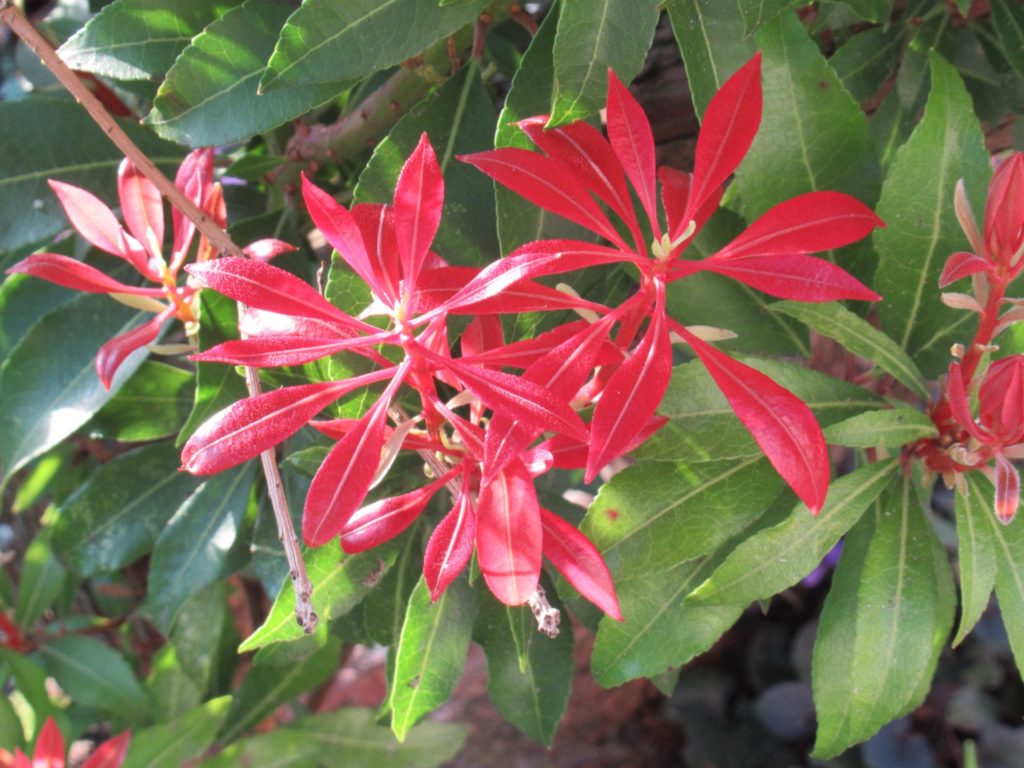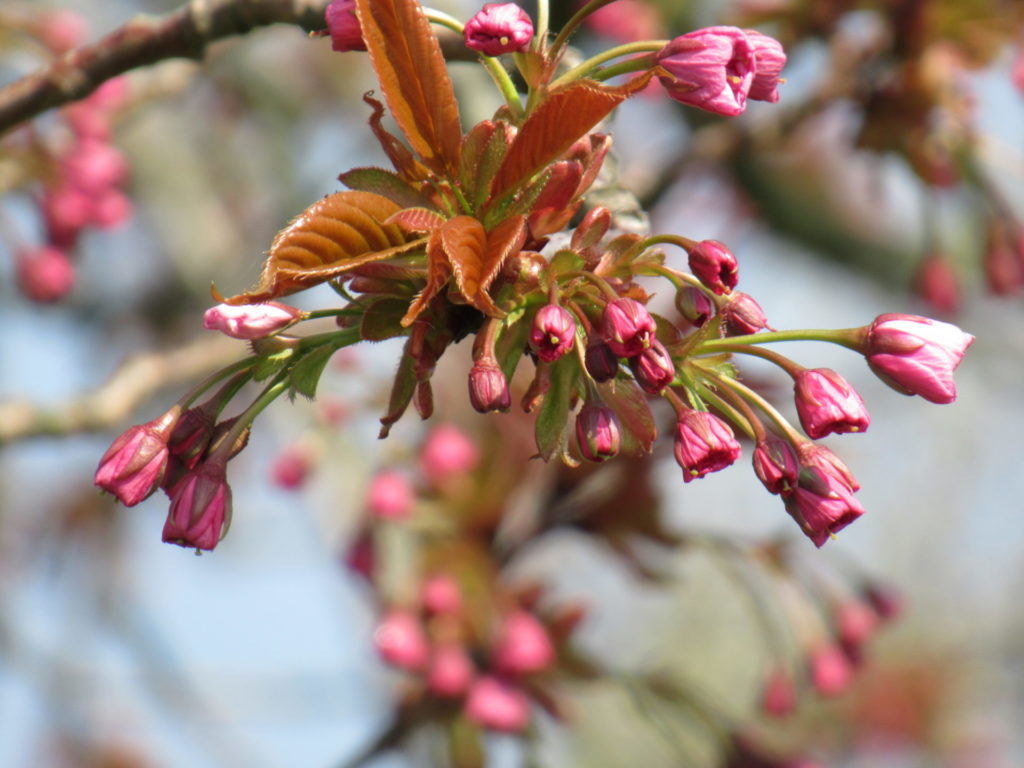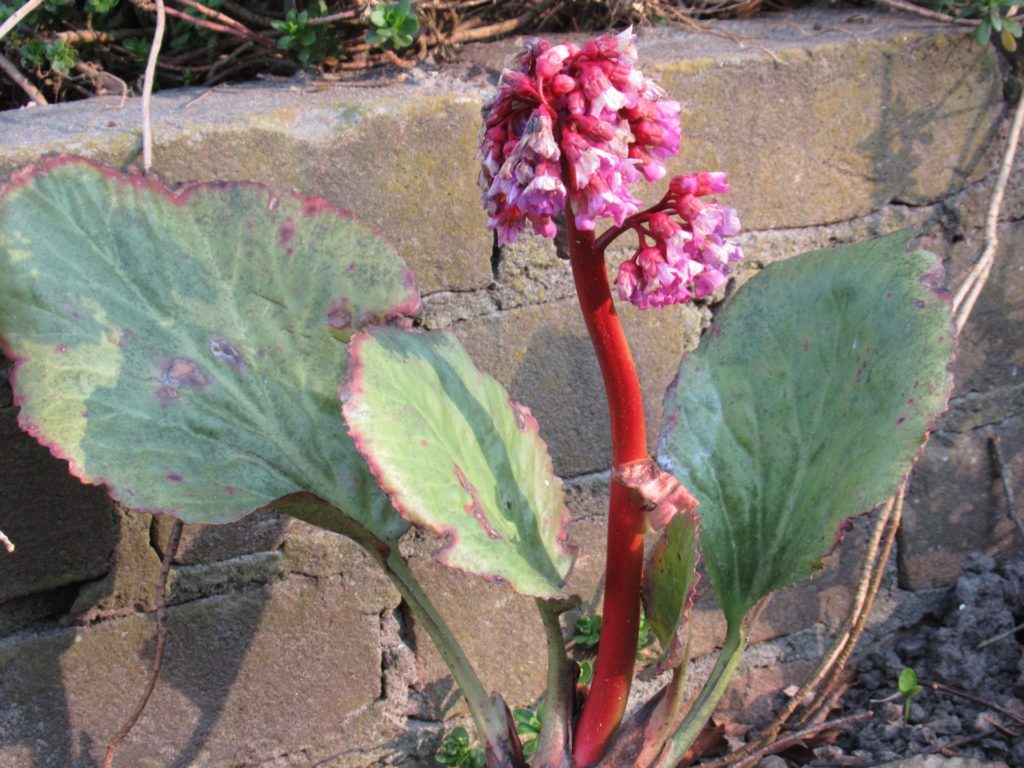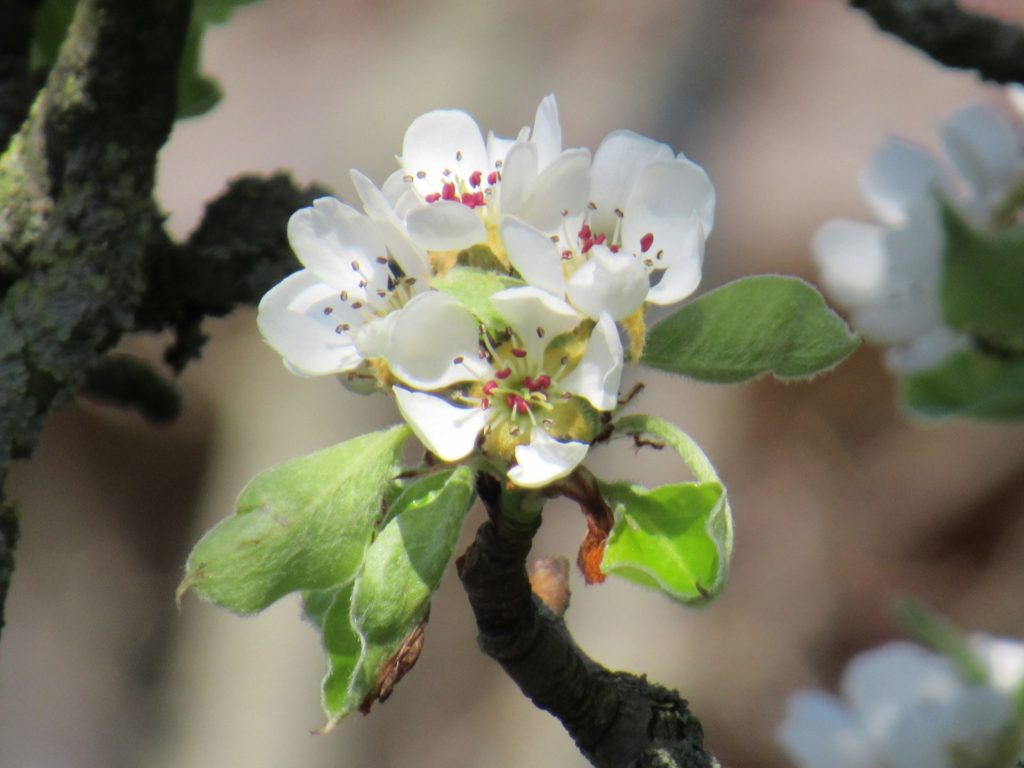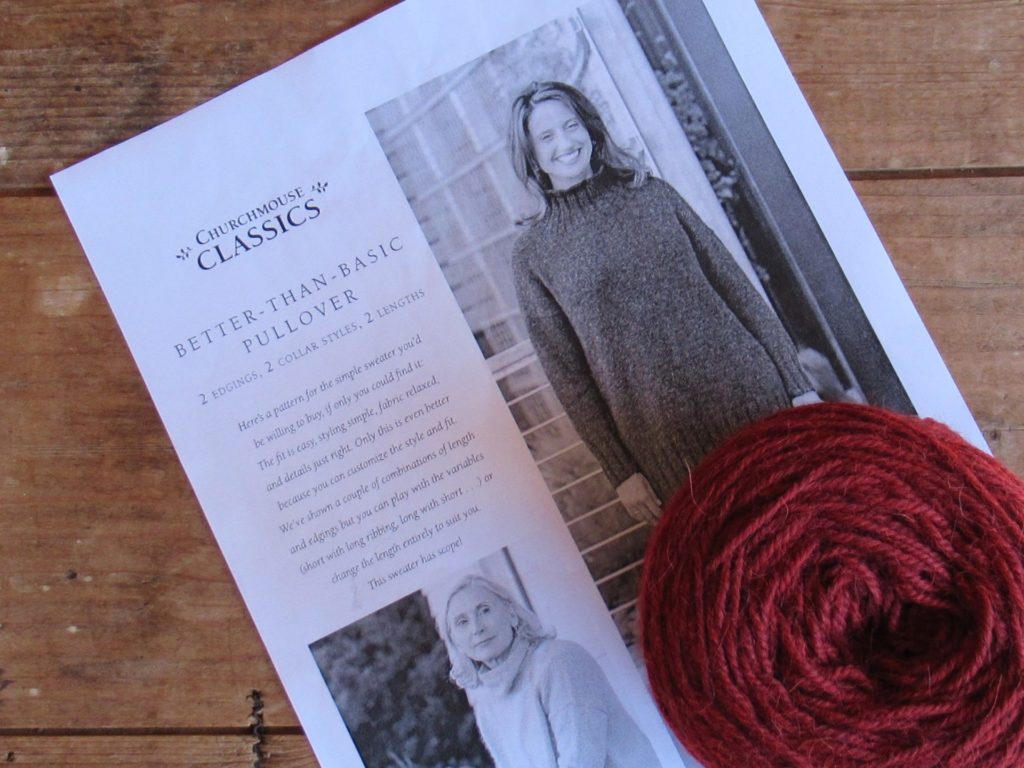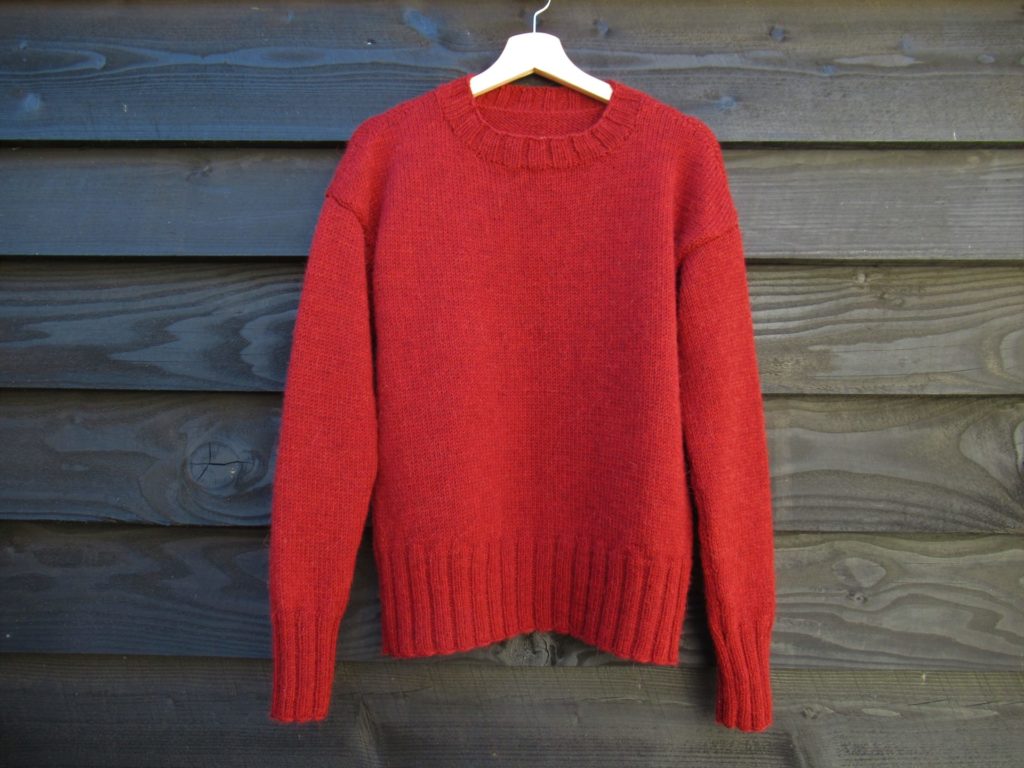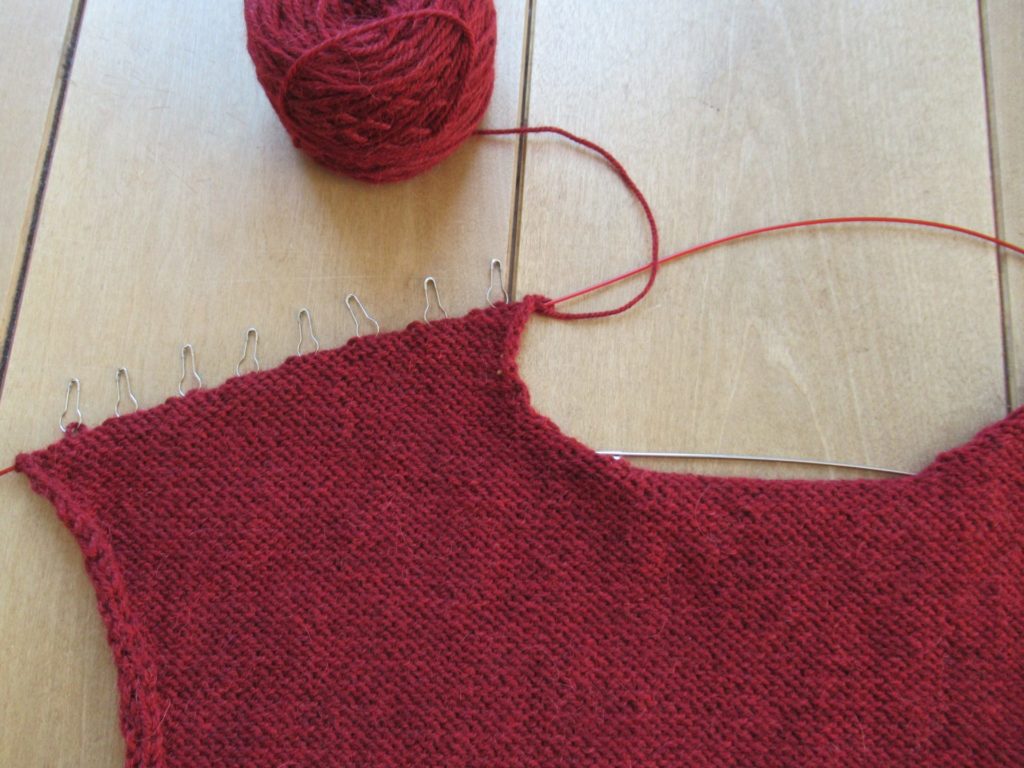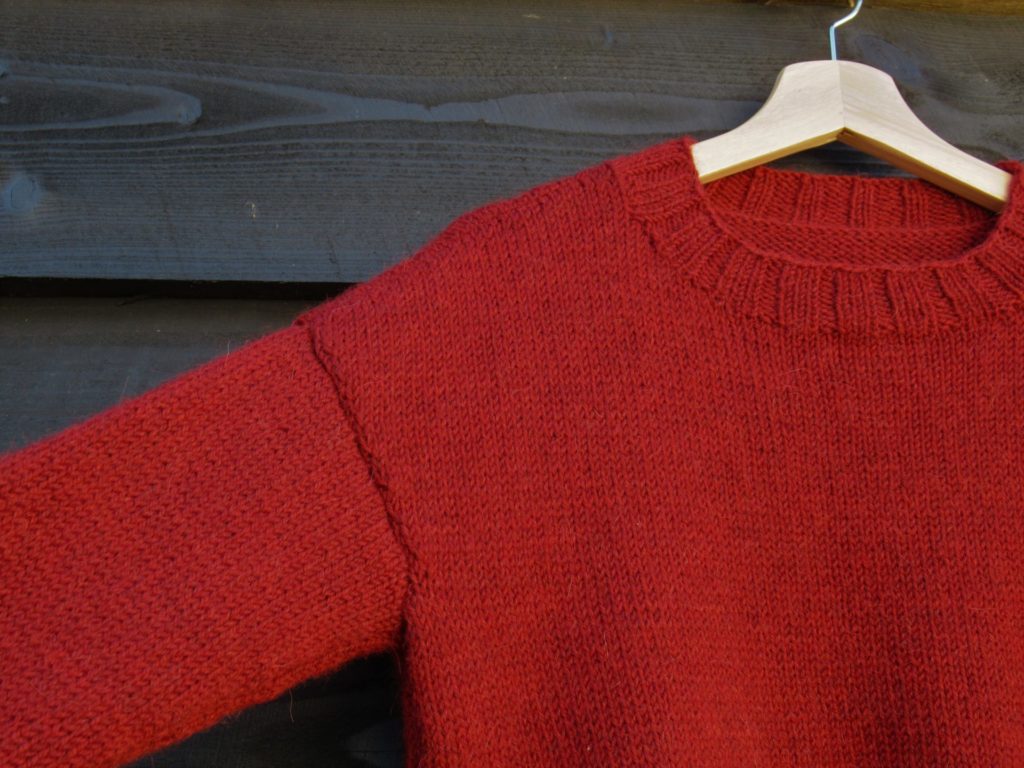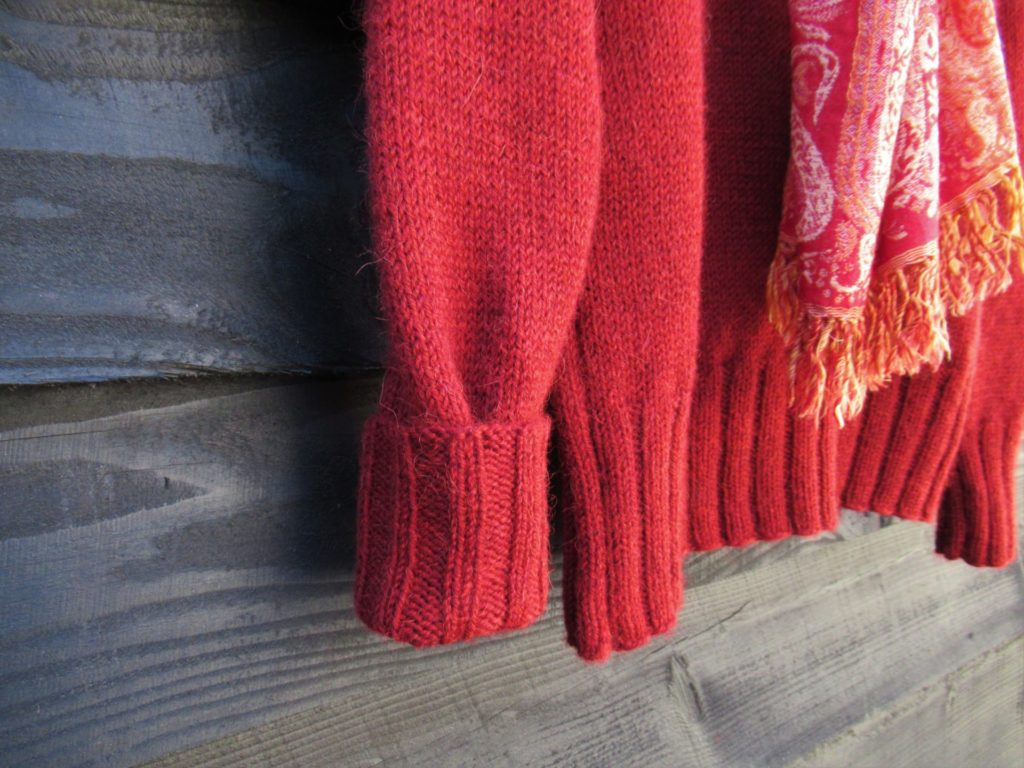 admin
admin
Novels for Knitters
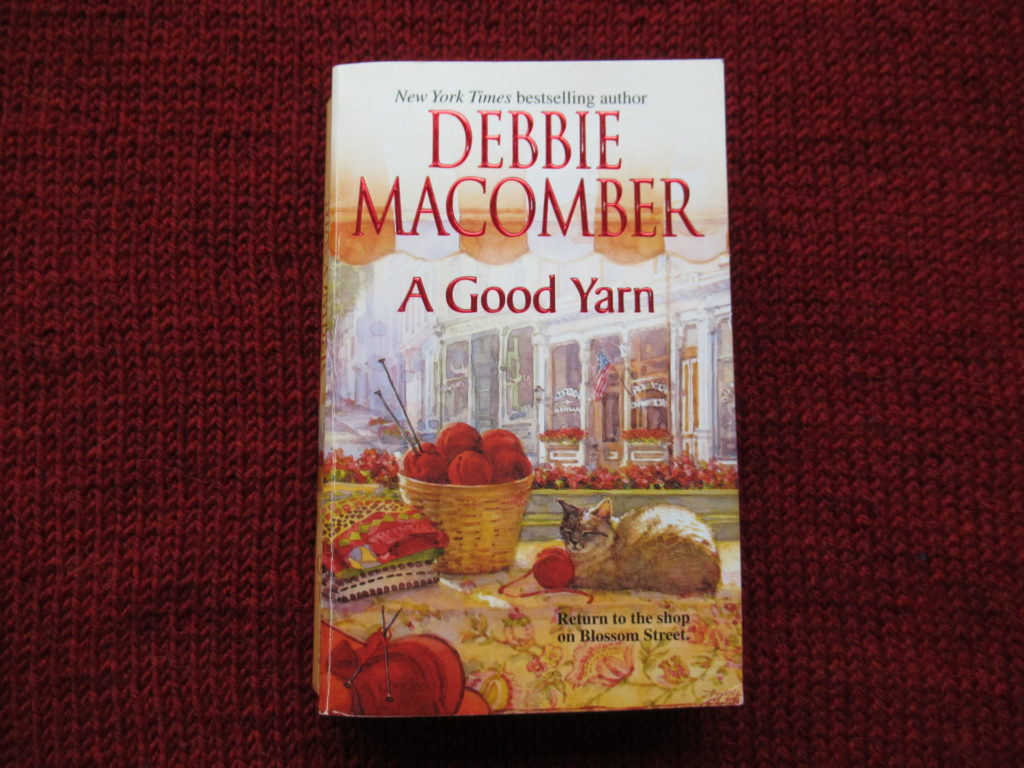
That I’ve called this blogpost ‘Novels for Knitters’ doesn’t mean that I think knitters are a separate species that can’t read ‘ordinary’ novels. Not at all! All it means is that I’ve pulled a selection of novels from my bookcases in which knitting (wool, yarn, etc.) plays a central role. I’ve had a fun time looking through them and photographing them against a backdrop of some of my knits, and hope you’ll enjoy reading about them.
Let’s start with the one in the picture above. A cosy scene, isn’t it? A cat snoozing in a spot of sunlight, flowers along a windowsill, a stack of knitted sweaters, a basket filled with yarn, and a knitting project on the needles.
The basket looks like my basket of yarn, and the knitting looks like what I have on my needles at the moment, but it isn’t. You can see my knitting in the background. The cosy scene on the book cover is the window of A Good Yarn, a fictitious shop on Blossom Street in Seattle.
A Good Yarn (Dutch e-book title De Wolwinkel) is the second book in a series of thirteen (so far) by Debbie Macomber. I don’t own the entire series, but here are the eight that grace my bookshelves (in reading order from left to right and top to bottom):
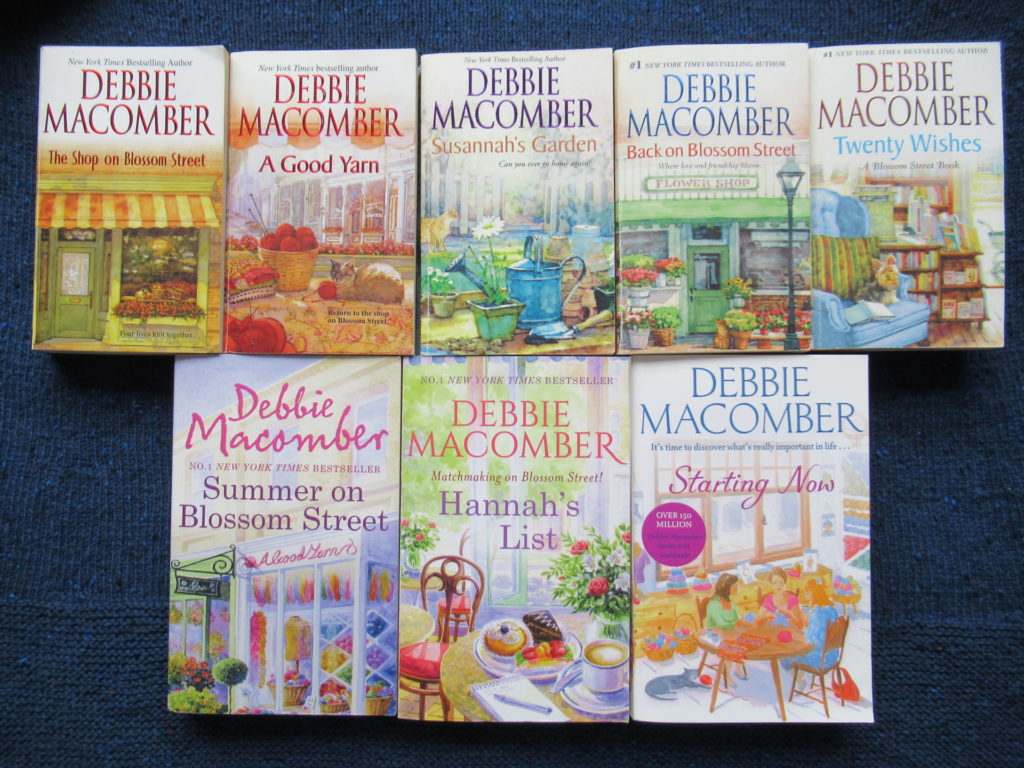
In the first book, The Shop on Blossom Street (translated into Dutch as Breibabes), the shop and its sympathetic owner Lydia are introduced. Lydia hosts a knitting class for beginners, with a baby blanket as an easy first project. While the blankets grow, the story about the lives of the people taking part in the class unfolds.
The thread that binds these novels together is the setting, Blossom Street. Lydia is the main character in some, but not all of the books. The variation in protagonists, all with their own stories, makes for lively reading. They struggle with all kinds of things, but on the whole this is a feel-good series.
A nice bonus of these novels is that some of them contain a knitting pattern connected with the story. There are patterns for a baby blanket, a pair of socks, a lace shawl, and a cable scarf. The patterns get more difficult as the series progresses.
And here’s another novel centred around a yarn shop – The Friday Night Knitting Club (Dutch title De Vrijdagavond Vriendinnenclub).
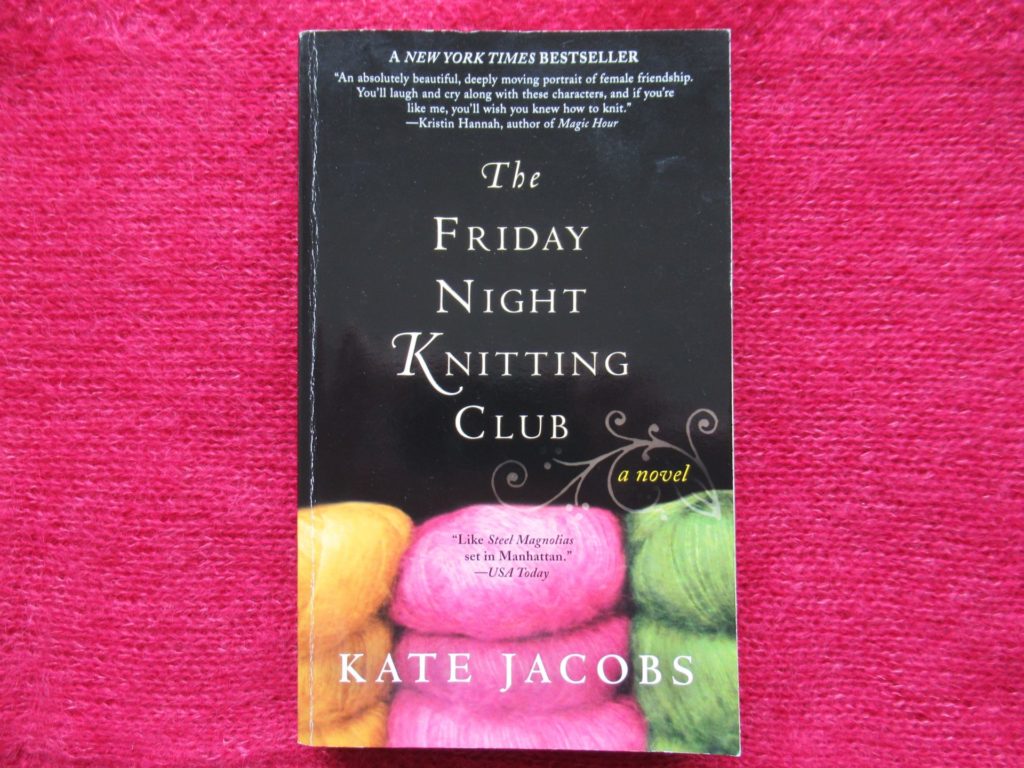
This time it’s a shop in New York City, and the main character is a single mum with a teenage daughter. Again we read about a group of people knitting together. They start out as strangers and gradually become friends (a phenomenon I’ve experienced in my own life again and again.) Again a feel-good novel, although I secretly wiped away a tear or two as well. I know that there is a sequel, but haven’t read it. Have you? Is it worth reading?
The novels I’m writing about here, are all fairly light-hearted, but the next one’s the fluffiest of all – The Great Christmas Knit Off:
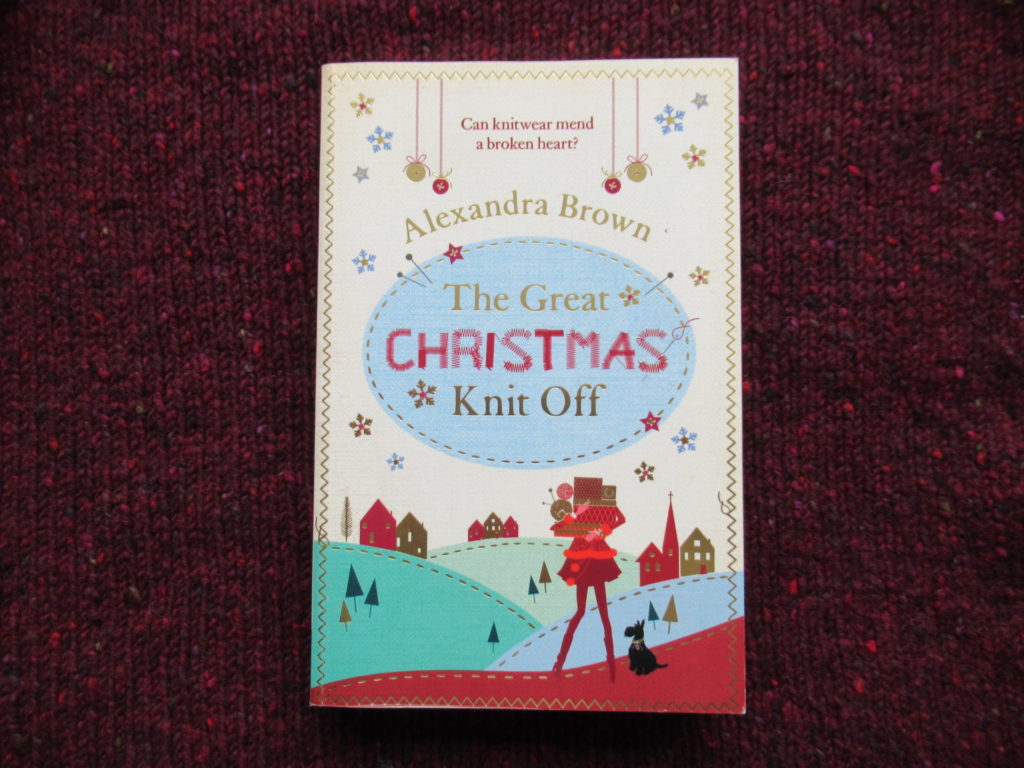
When her fiancé decides that he actually prefers her twin sister and, to make matters even worse, something goes terribly wrong at work, Sybil escapes to the countryside. Here a totally unrealistic story (seventy-five Ho-ho-ho Christmas sweaters to be knit within an incredibly short space of time) unfolds.
Okay, it’s a silly story. But reading a silly love story involving heaps of snow, a picture-postcard English village, lots of yarn and knitting, and the rescue of an ailing haberdashery shop can be very therapeutic.
The next novel, Casting Off, is slightly more serious.
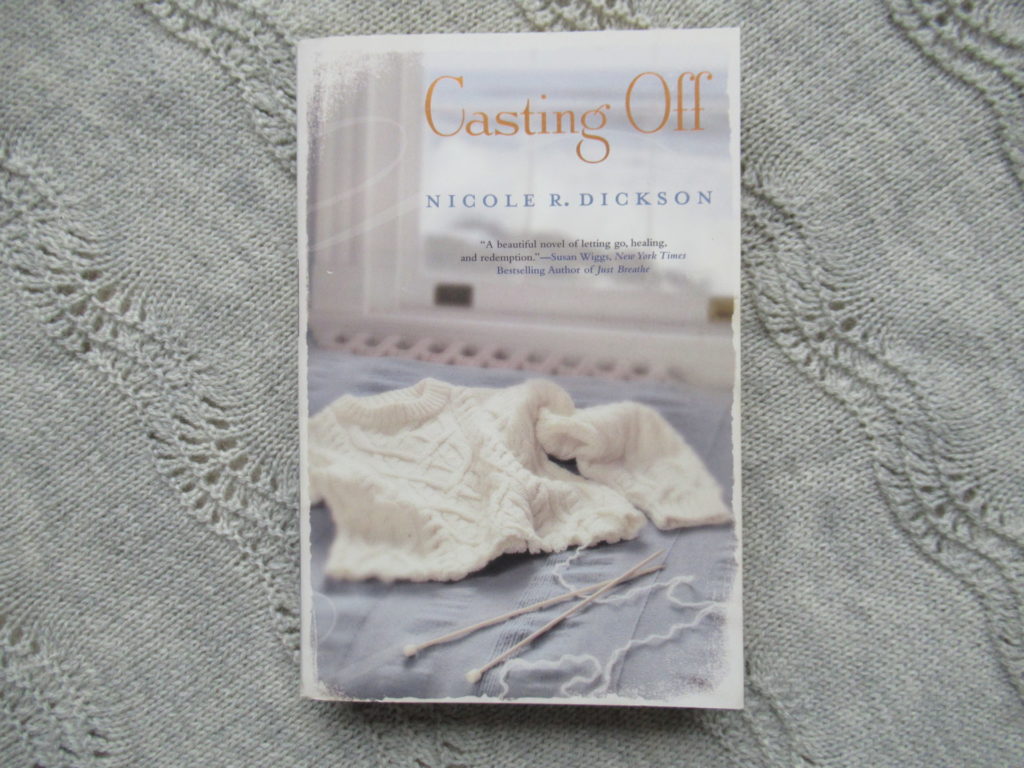
Rebecca Moray travels to an island off the Irish coast, together with her daughter, to do research for a book on Irish knitting. She also hopes to forget her painful past by getting immersed in her research.
I read this novel years ago and don’t remember the story very well, nor whether I liked it or not. Leafing through it now, I notice that the chapter titles are derived from knitting stitches and are followed by a definition. Here’s the definition from the chapter entitled ‘Garter’:
‘Garter. 1. The simplest pattern, created by knitting or purling every row, never mixing the two. 2. Doing the same thing over and over again, making progress in time, but never moving forward in spirit.’
Intriguing. Time for a re-read, methinks.
And here’s a borrowed book that I’ve just started reading, Dying in the Wool:
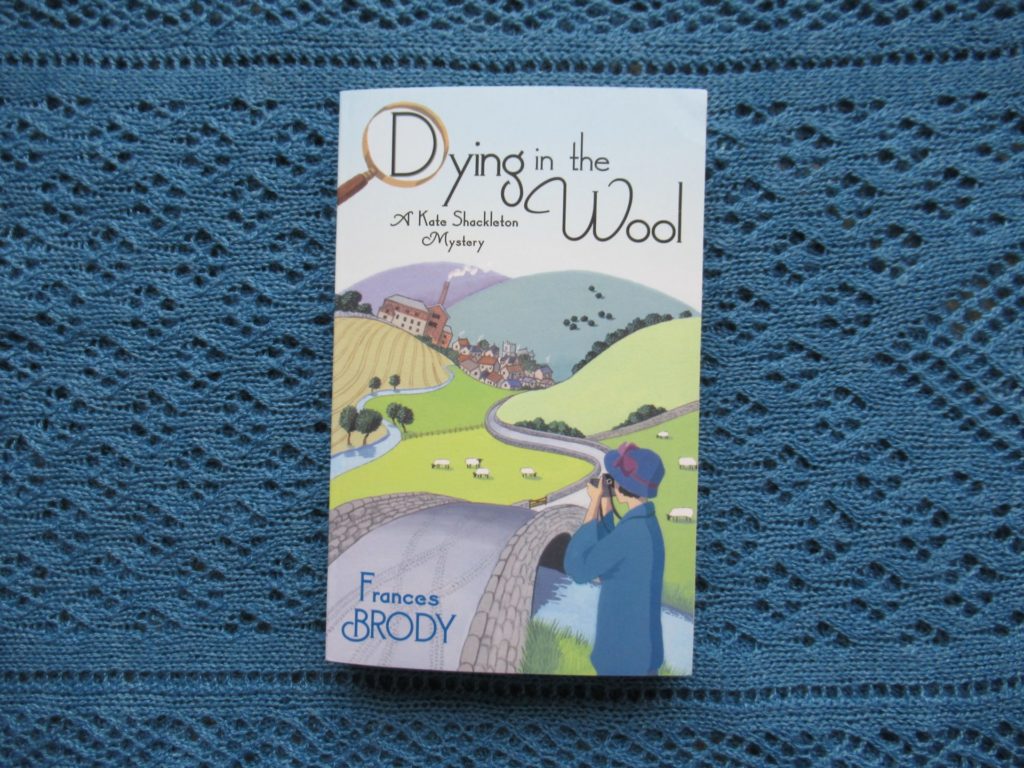
It’s a mystery set in Yorkshire in 1922, about a millionaire gone missing. Kate Shackleton, a young widow with some experience in sleuthing, receives a letter from an old acquaintance asking her to look into this mysterious disappearance. The back cover says that in doing so ‘she opens cracks that some would kill to keep closed.’
I don’t know how wool comes into it yet, but I’m dying to find out!
There must be more knitting-themed novels around. Do you know of any good ones?
A Stroll through our Village
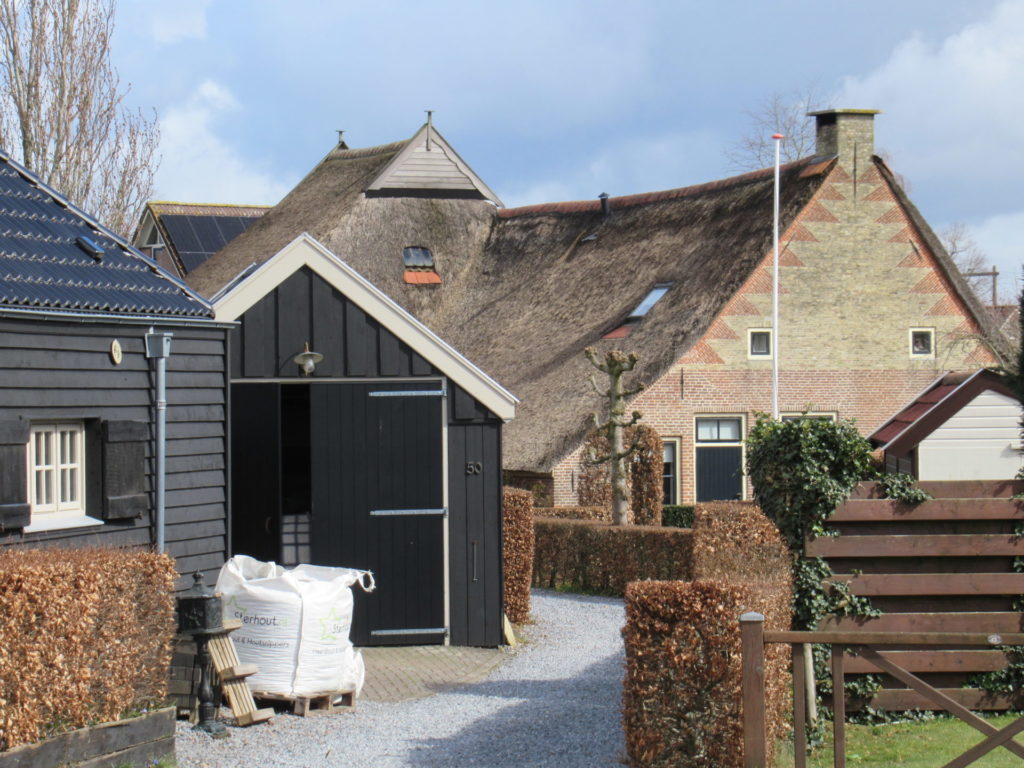
Hello again! Today, I’d like to share some of my thoughts with you while strolling through our village. It isn’t a particularly picturesque village, but I love it because it’s home.
Although the village is already mentioned in 14th century documents, there is little left that reminds us of the distant past. Most of the houses (some more attractive than others) date from the middle of the 20th century, and there’s also a brand new, recently finished housing estate.
But there are several beautiful old reed-roofed houses left, like the one at the top. And here’s the corner of the roof of another one:
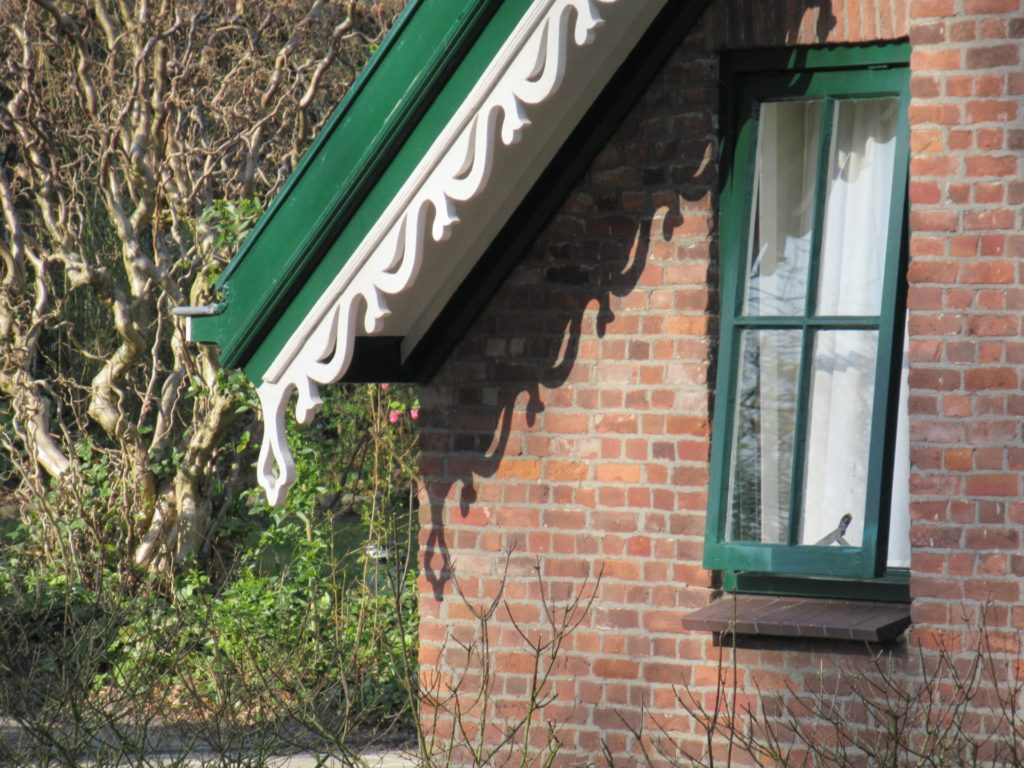
I’d like to translate the lovely scallops into the edging for a knitted shawl someday. My mind is always overflowing with ideas. Right now some of the ideas are crowded out by worries, however.
It’s the end of the third week of our ‘intelligent lockdown’, as our Prime Minister calls it. All events, big and small, have been cancelled until June. Schools, restaurants and cafés, theatres, libraries and other public places will remain closed until at least the end of April. People work from home and stay at home as much as they can. Everything to keep this dratted virus from spreading too fast.
We can still go out for our necessary shopping and also for a walk or a bicycle ride, as long as we keep a safe distance. I’m incredibly grateful for that, as for many other things.
Strolling through the village, I’m grateful for spring, with its birdsong and its flowers. For a garden filled with grape hyacinths…
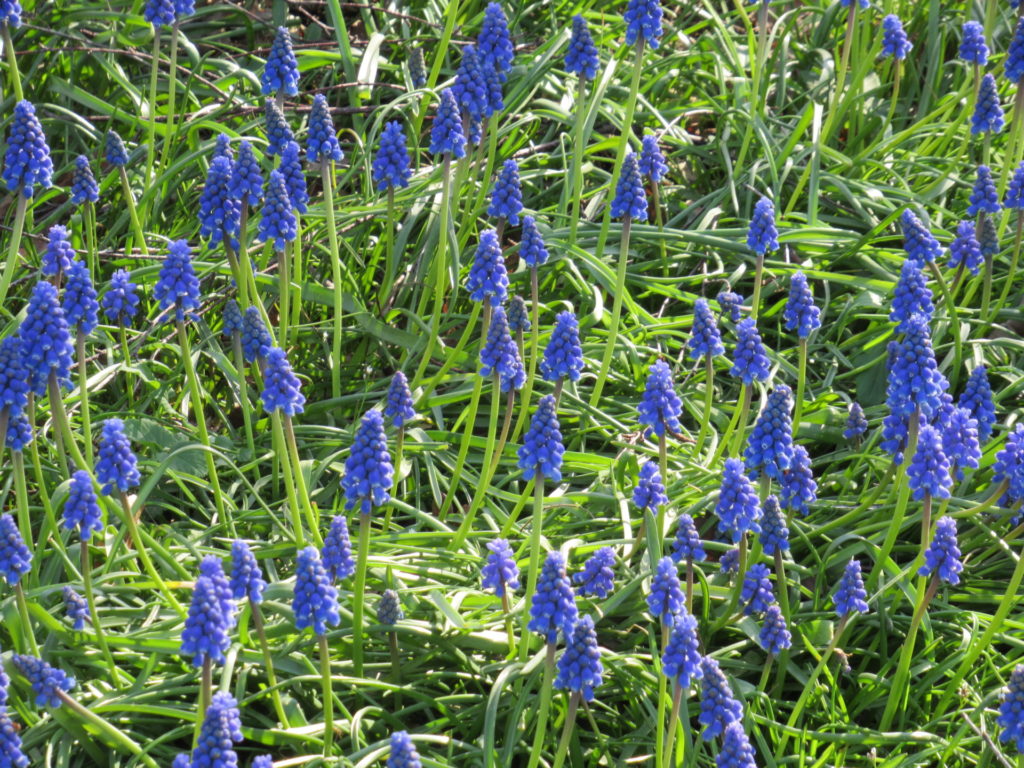
… for flowering magnolia trees…
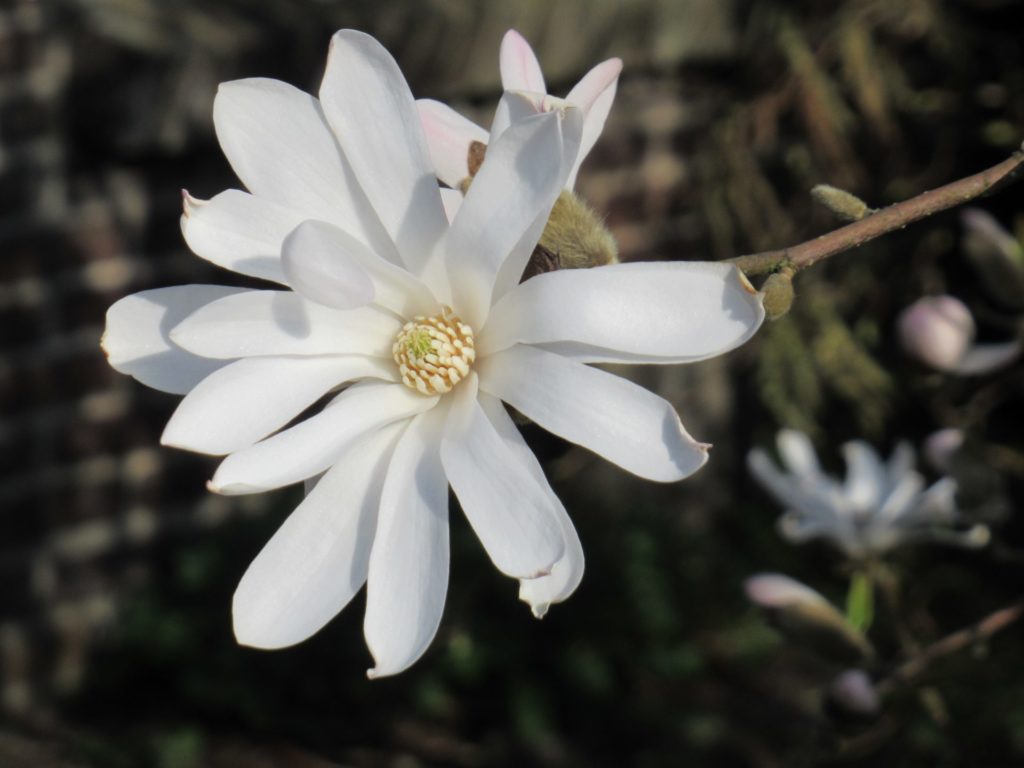
… for the sunlight reflecting off the bell of a cheerful children’s bike…
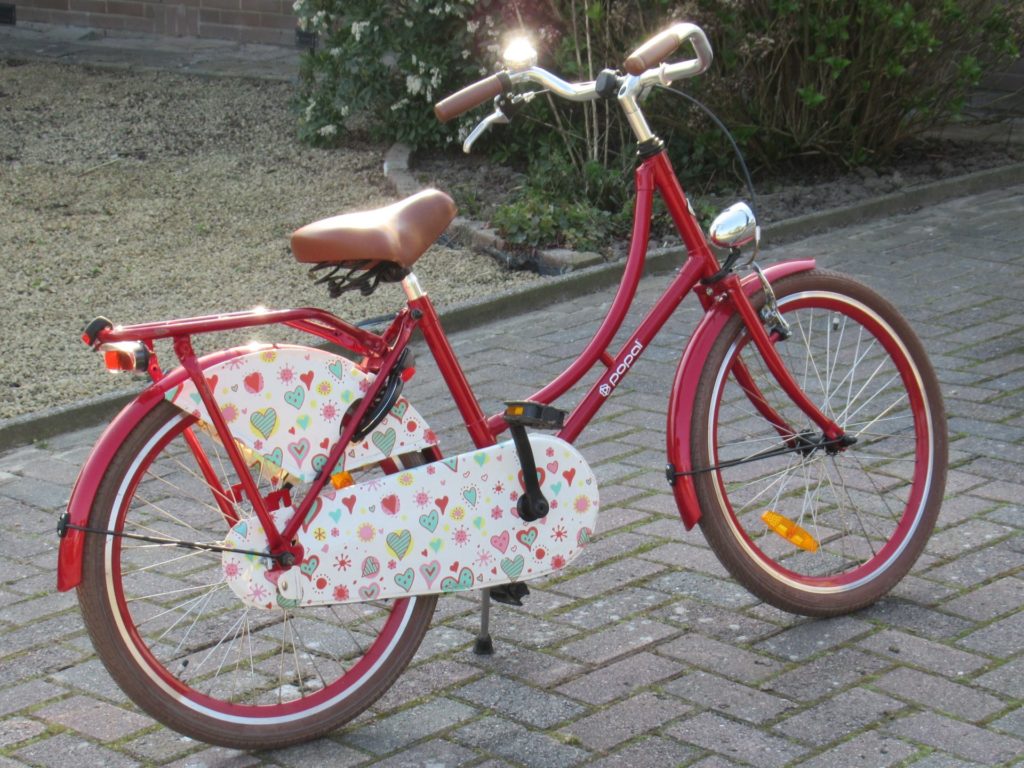
… and for the tiny pavement garden that gives passers-by something different to enjoy every month of the year. This month’s treat is scillas and lesser celandine:
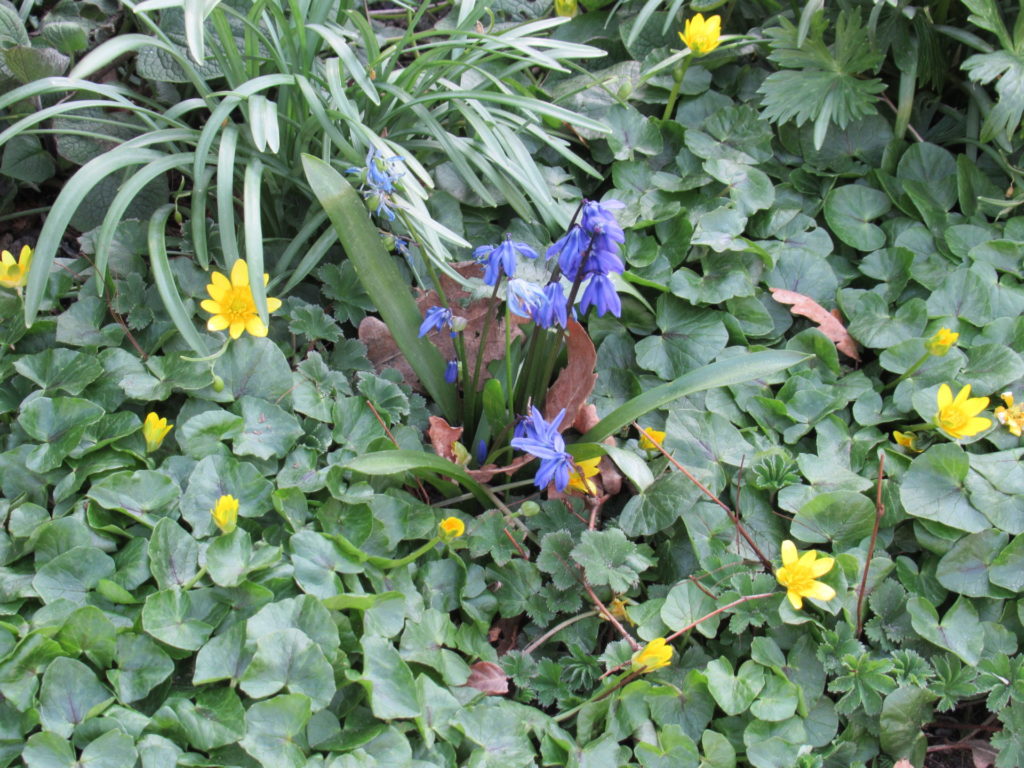
I’m grateful for so much. And I’m worried. Although I have the occasional what-if thought, I’m not so much worried for myself and my family. We’re okay, and we’ll manage.
I am worried for the vulnerable people in our society and in the world at large. For the elderly, for those suffering from anxiety, depression and other mental health problems, for children in unsafe homes, for people losing their jobs, for people making overtime in hospitals, for people unable to stay at home simply because they have no home.
I know that worrying won’t help, but what can I DO?
Strolling along, I see positive signs of other people wanting to do something. Someone placed this chalkboard along the pavement:
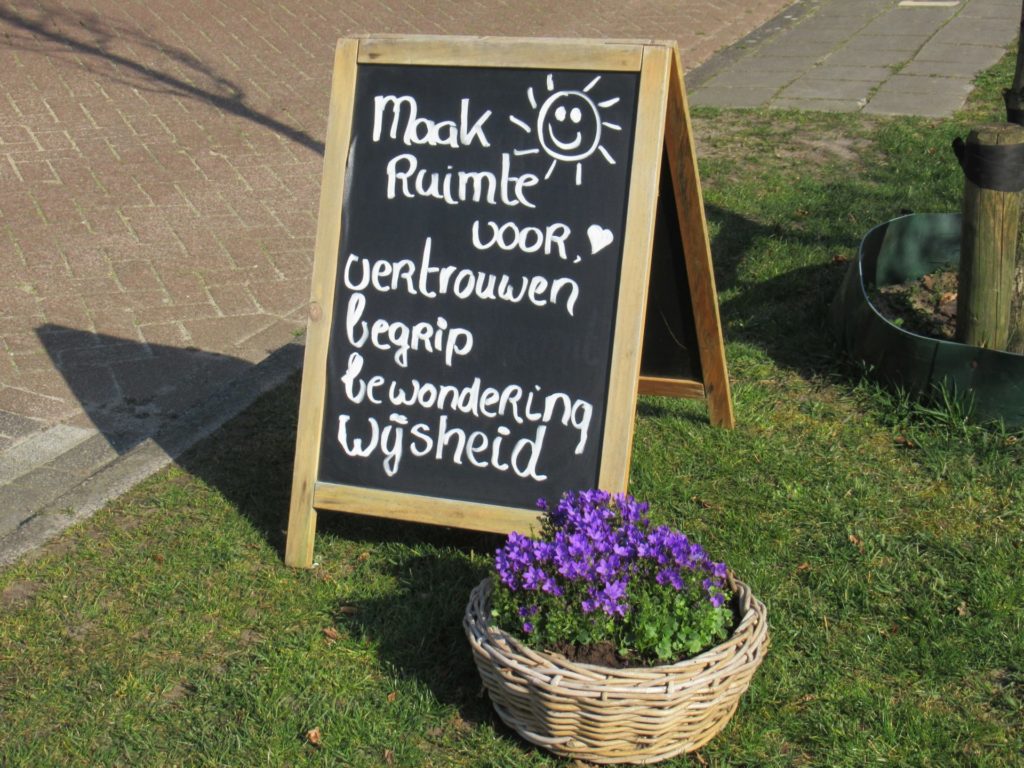
It says, ‘Make room for trust, understanding, wonder, wisdom’.
And I don’t know who it was, but someone somewhere in the world had the idea for a Bear Hunt, meant for small children and their parents, but also very nice for grown-ups. More and more bears are appearing in our village, too. One family crammed their windowsill full of them, and placed two more on their garden table:
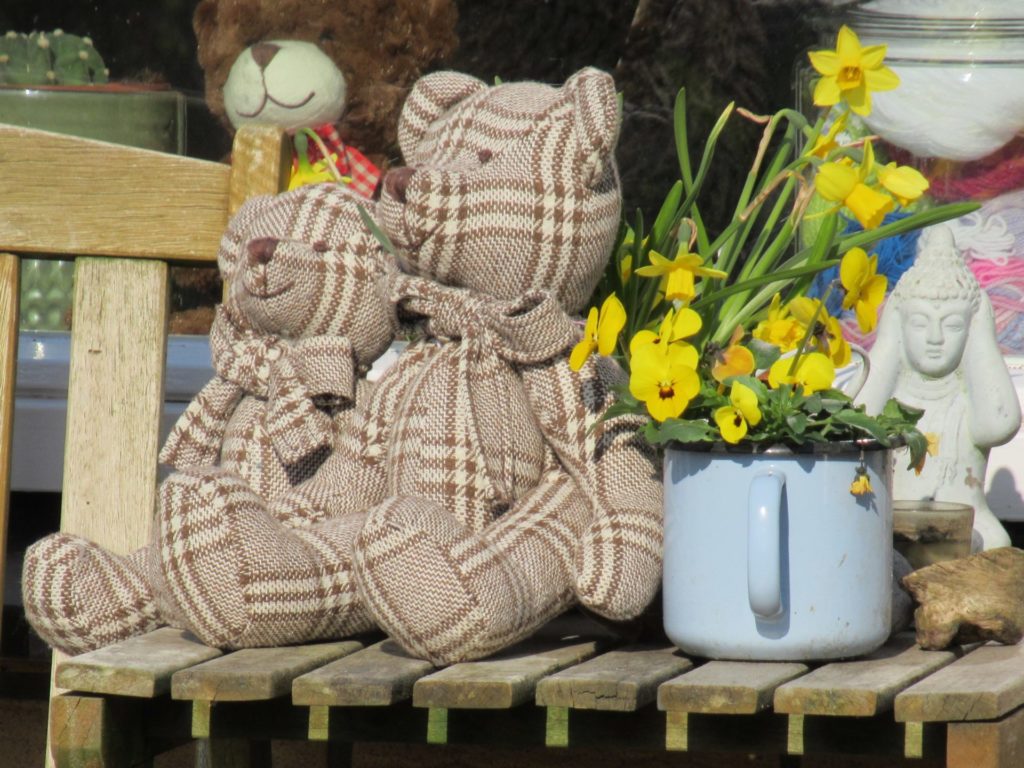
Such a simple and sweet gesture. Whoever it was who came up with this idea, I’m grateful to them for thinking of it. It reminds me that small and simple gestures can help. In this spirit, I made a short list of small things I can do:
- Make phone calls to everybody I can think of who may appreciate some company, even if it is from a distance.
- Listen to people without trying to push or pull them in any direction.
- Send someone an uplifting postcard.
- Donate to organisations supporting people I’m worried about.
- Chat with neighbours (from a safe distance) and ask if they’re okay.
- Keep blogging.
- Keep practising social distancing.
- Try to stay as nice as I can to the guy I’m staying at home with (not hard at all, because he is a VERY nice guy).
- Knit something for someone.
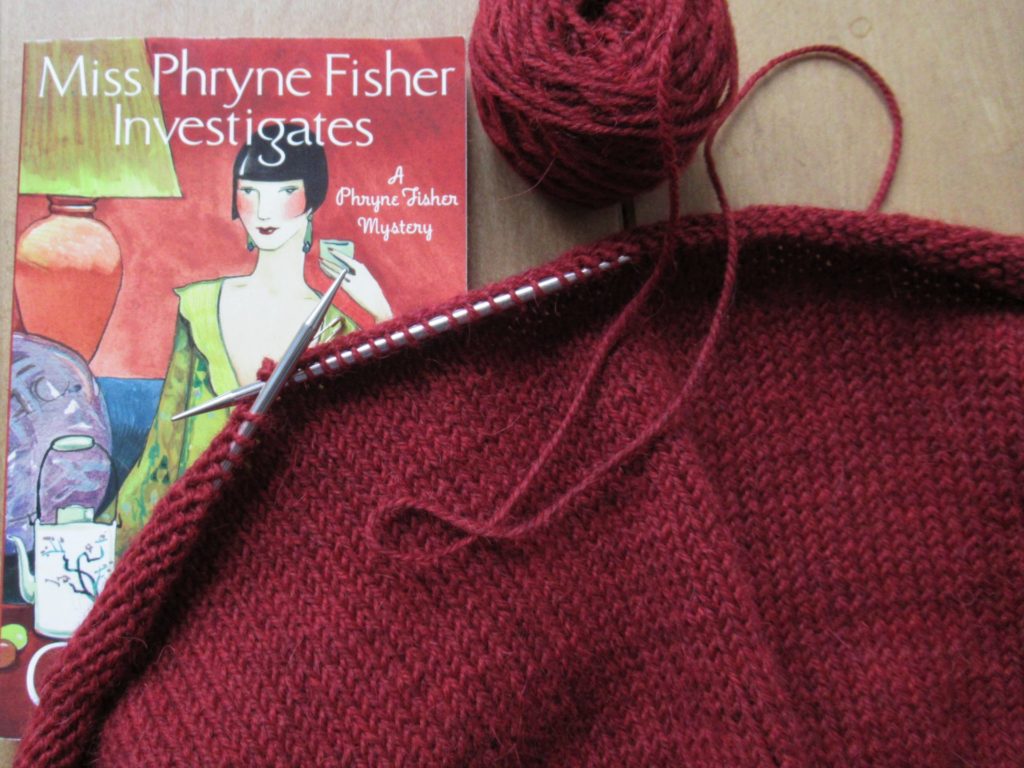
Any ideas for things to add to this list are welcome!
Taking action, no matter how small, is what works for me. I realize that not everybody is the same. I hope that you can find things that work for you. If nothing seems to work, please talk about it to someone you trust.
Thank you for strolling along with me and listening to my thoughts and worries. I hope you are still all right. Here’s a big smile for you from our upstairs window.
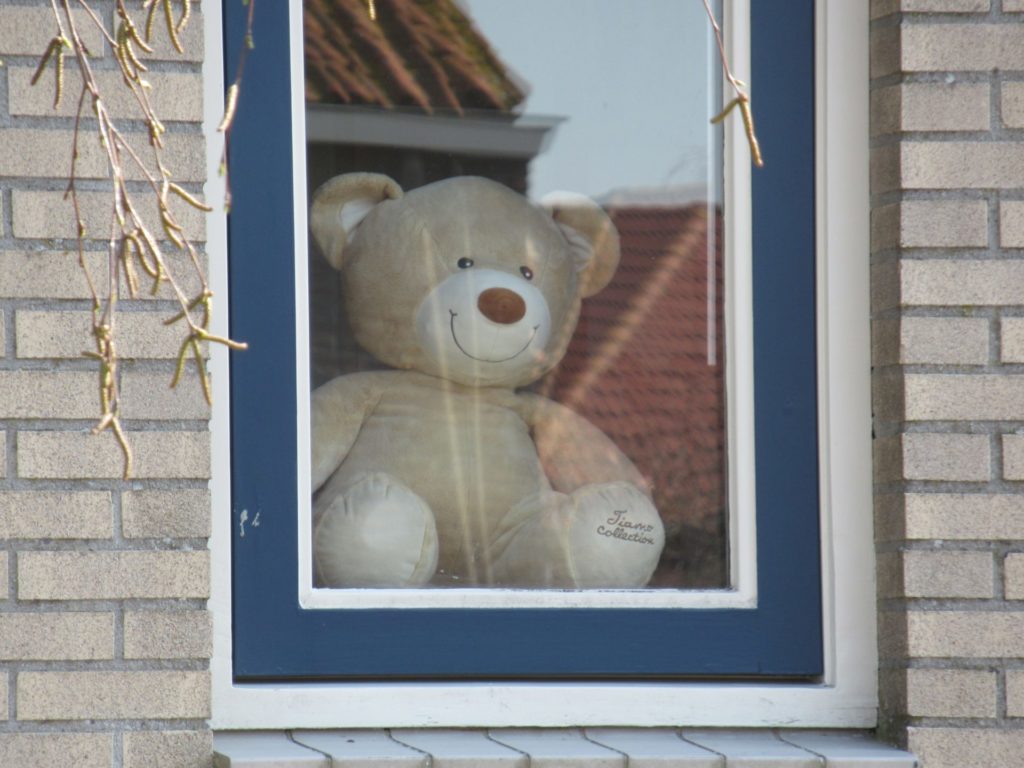
Cygnus Cowl – A Swan-inspired Accessory
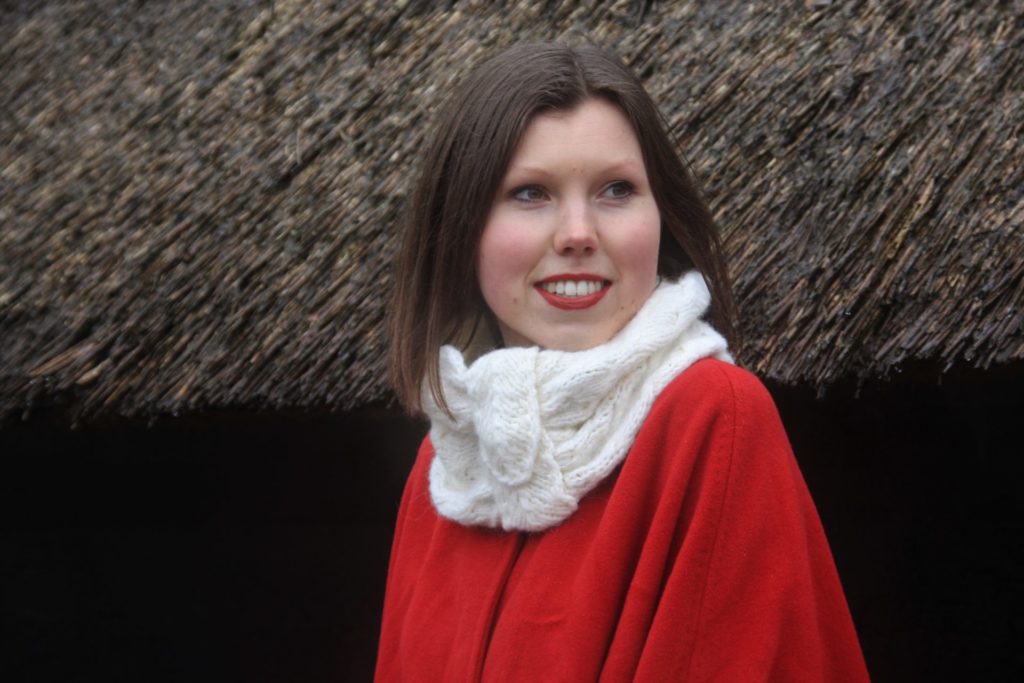
Hello dear fellow knitters, nature lovers and other readers.
Today’s blogpost is again part of my effort to keep at least this little corner of the world as normal and uplifting as possible. So here is my Cygnus Cowl, the new knitting design I’ve been working on for about four months. I’m not a quick designer. I like to sketch & swatch and test & tweak until every detail is just right.
As I told you last week, it was inspired by one of the inhabitants of the reedlands close to our home – Cygnus olor, better known as the mute swan. Here it is, sailing along regally in a still wintry landscape.
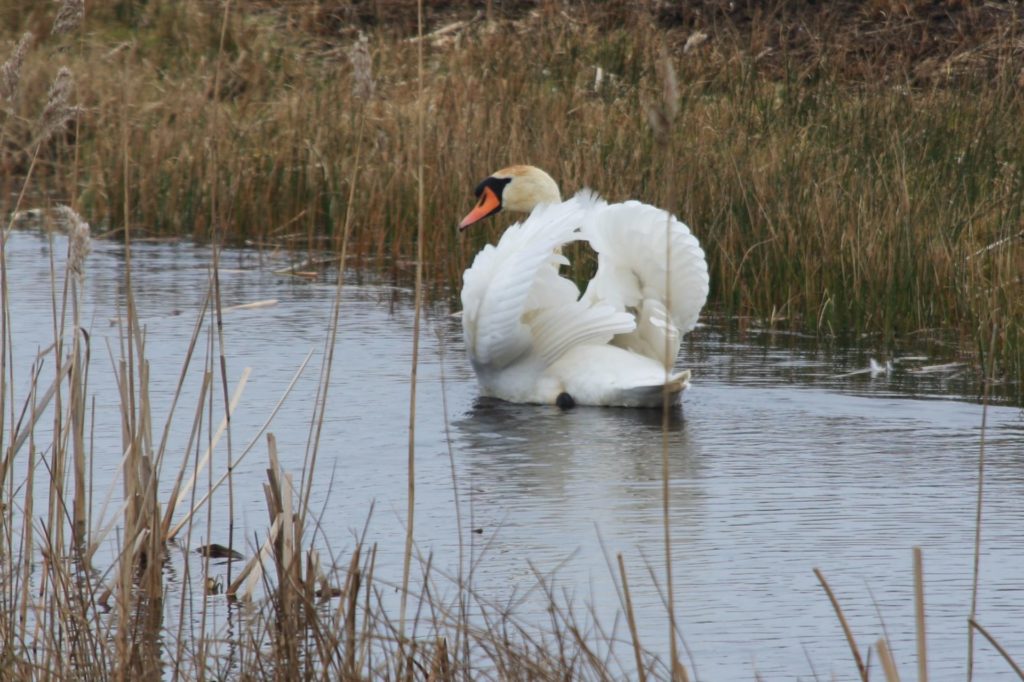
Mute swans can produce a weak trumpeting sound, and hiss when provoked, but are mostly silent. Hence their name. I know that they can be aggressive, but from a safe distance they look like fairy tale creatures.
In Dutch they are called knobbelzwaan, for the black knobbel (knob) at the base of their bill. They are fairly common around here. Do they live in your part of the world too?
I have photographed them in different seasons. In June last year, I spotted a nesting pair through some reeds.
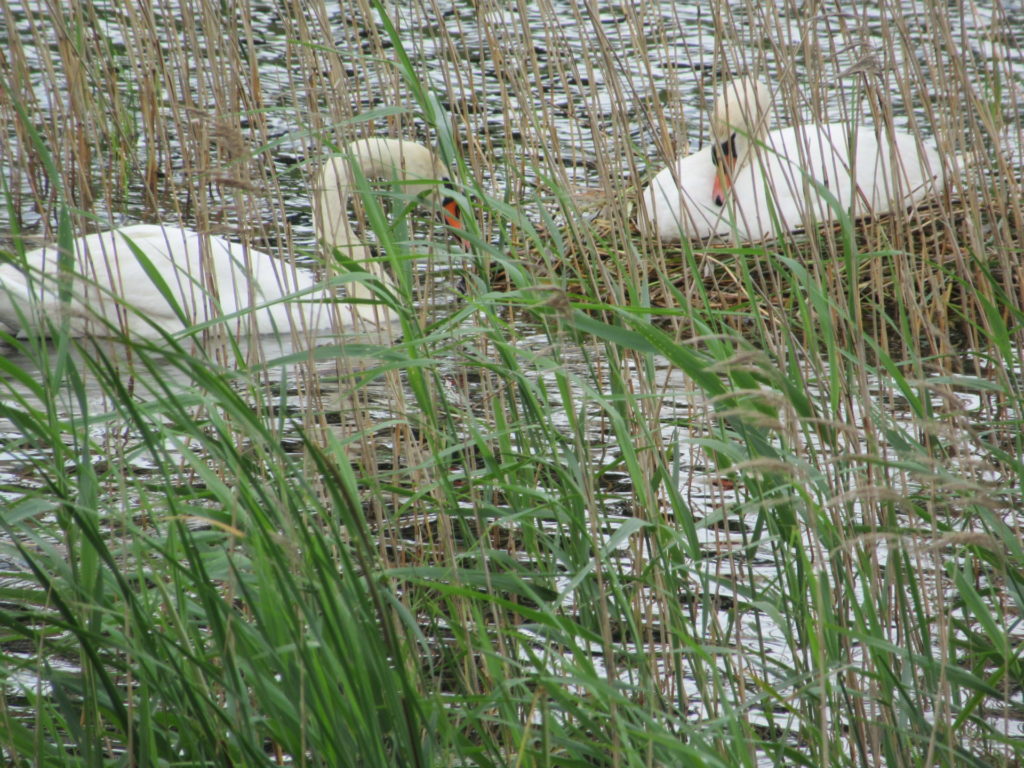
And on a sunny summer’s day, I took this picture:
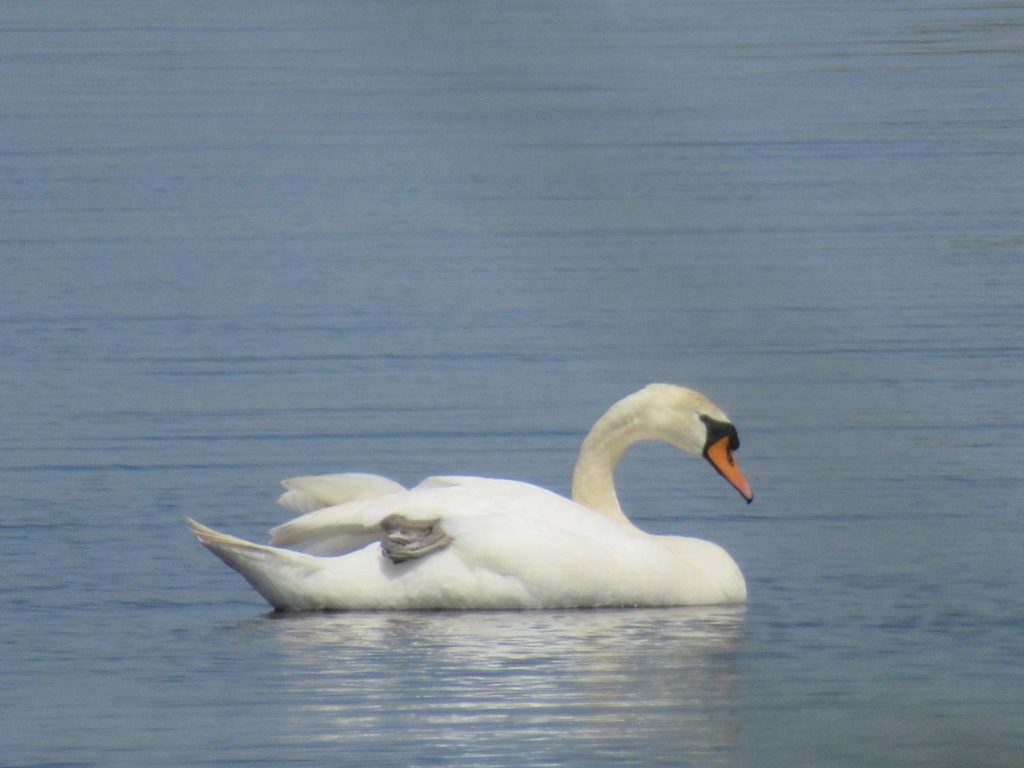
I asked the swan to please pull up its leg, because it looked silly with its foot sticking out from between its feathers. But it refused to oblige.
Now, a little more about the cowl. You’ve already seen it at the top of this post, and here’s another picture, with the model’s hair tucked inside to show it in its entirety:
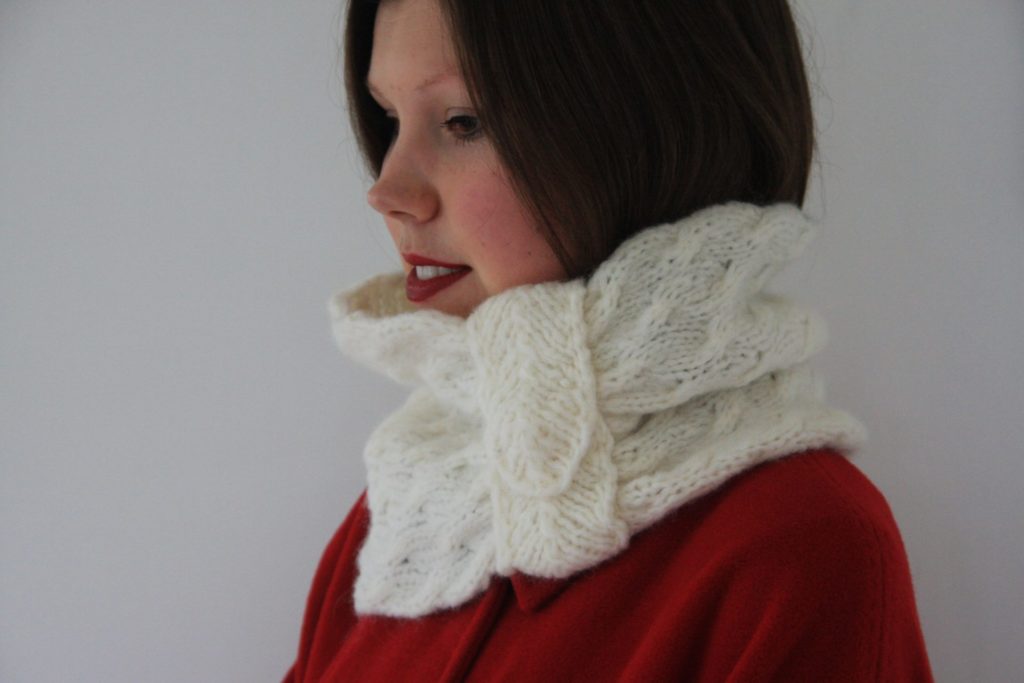
And this is what it looks like from the back:
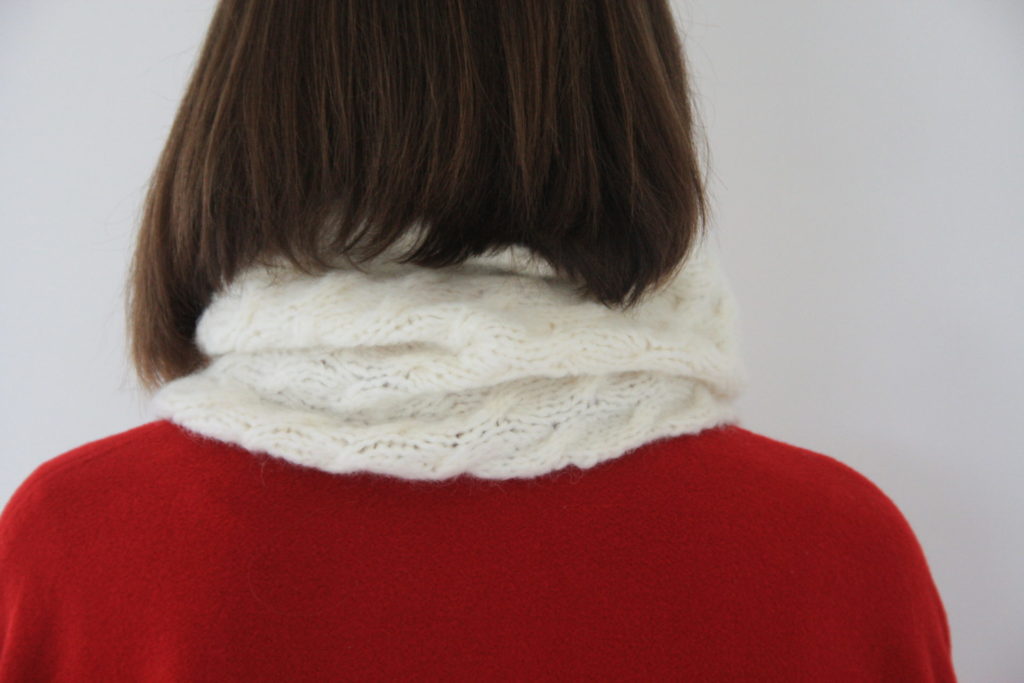
The lovely model is our daughter, and I’ve designed the Cygnus Cowl with her in mind.
The yarn I used is Rowan ‘Brushed Fleece’, a bulky wool and alpaca blend. Two balls of 50 grams each are enough for the cowl and several swatches. It already feels nice on the ball, but after soaking and drying it is as soft as swan’s down.
The cowl consists of two parts. First there is the cowl body, knit in an all-over cable pattern resembling rippling water:
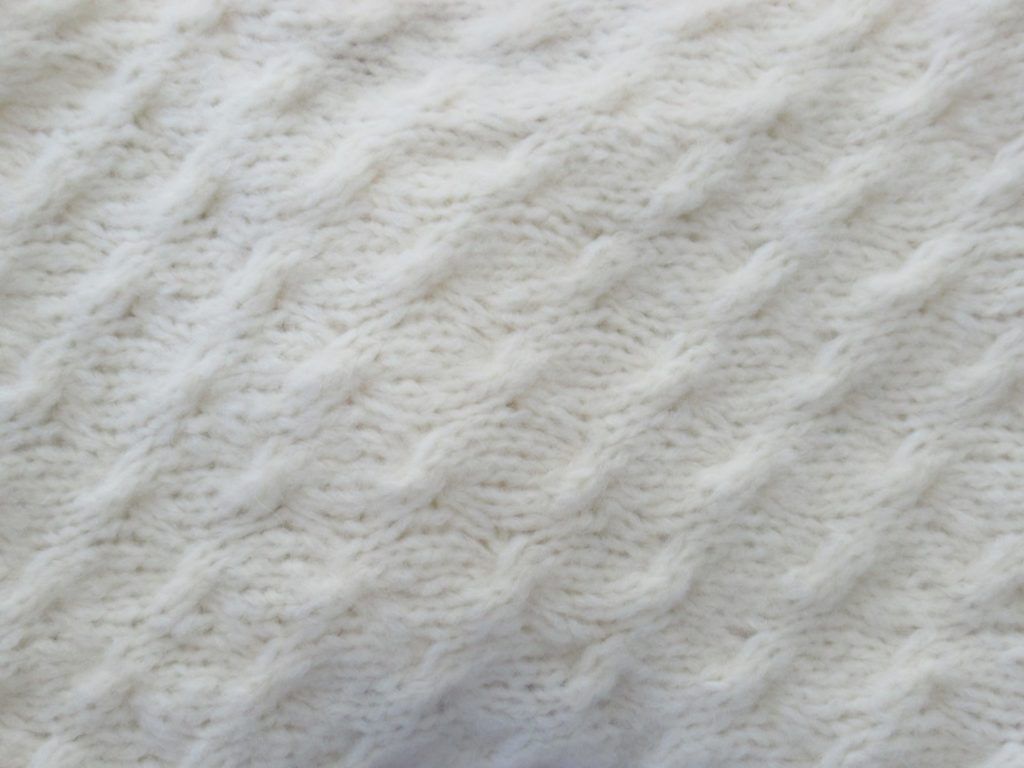
And then there is a long swan’s wing feather, knit separately.
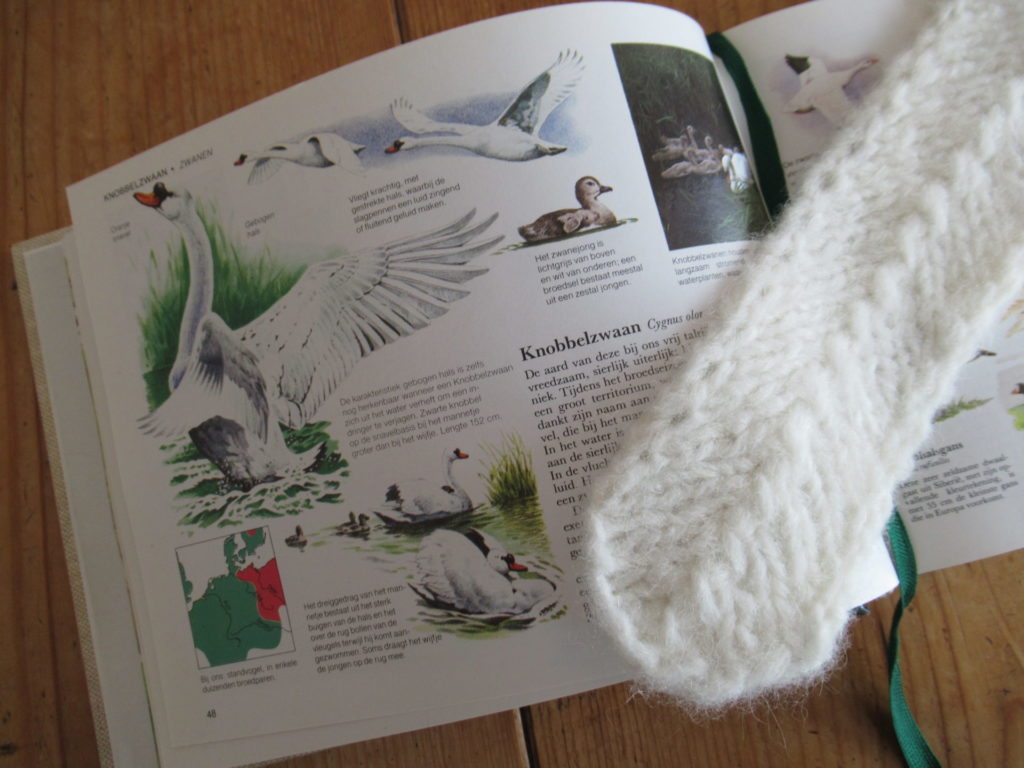
Here the Cygnus Cowl is laid out flat. It has a narrow indentation on one side and the feather is wrapped around it later. White is hard to photograph – I hope you can see the details clearly:
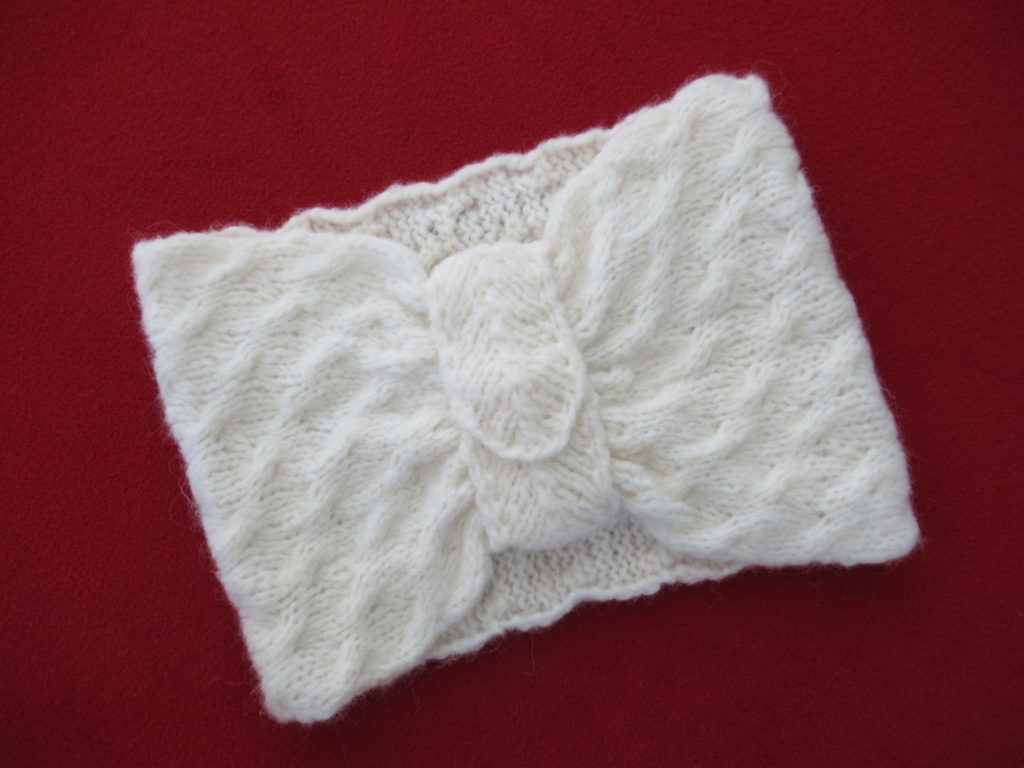
It isn’t a beginner’s knit, but for a slightly more experienced knitter it is totally doable. I’ve explained the cables and several other knitting techniques in the pattern. And the description of how the cowl is finished is accompanied by photos.
The above pictures were taken indoors. It was early March and our plan was to take lots of photos outside, but the weather was uncooperative. It was a cold, blustery, rainy day. Here’s an impression of our outdoor photo shoot.
Raindrops on the lens and icy hands made it hard to take clear pictures. There were puddles everywhere and the ground was muddy. The wind tugged hard at our daughters red cape (a thrift-shop bargain made with cashmere, squeee!)…
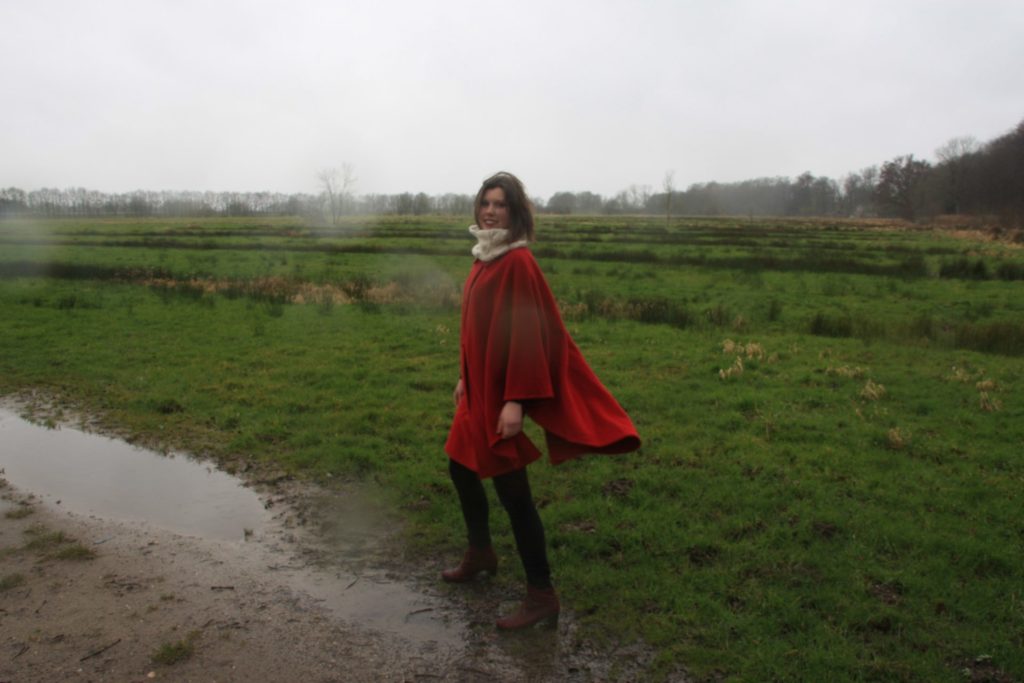
… and made her hair fly all over the place.
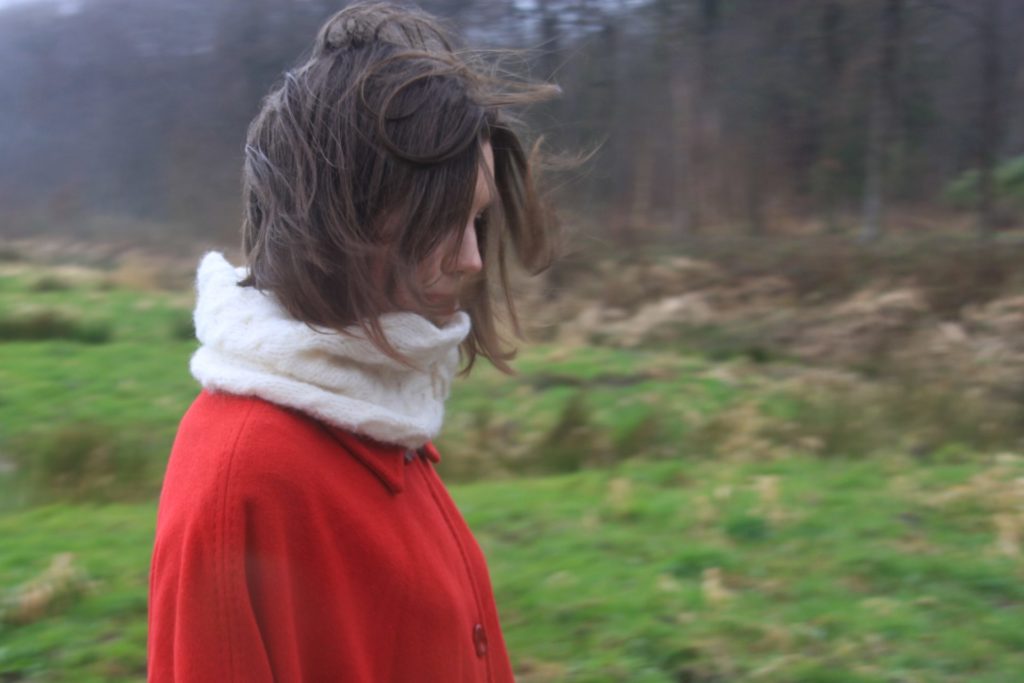
In the end we found a sheltered spot behind a reed-roofed barn, but by that time my model/daughter was chilled to the bone. And how to get onto firmer ground again without sliding into the mud?

We had to work fast, and fortunately ended up with enough usable pictures. And in spite of the unpleasant circumstances we had a lot of fun.
I realize that white isn’t for everybody. If white doesn’t suit you but you like the design, why not make it in the colour of your own favourite bird – flamingo pink, raven black, dove grey, owl brown or teal blue?
You can find the Cygnus Cowl pattern here on Ravelry.
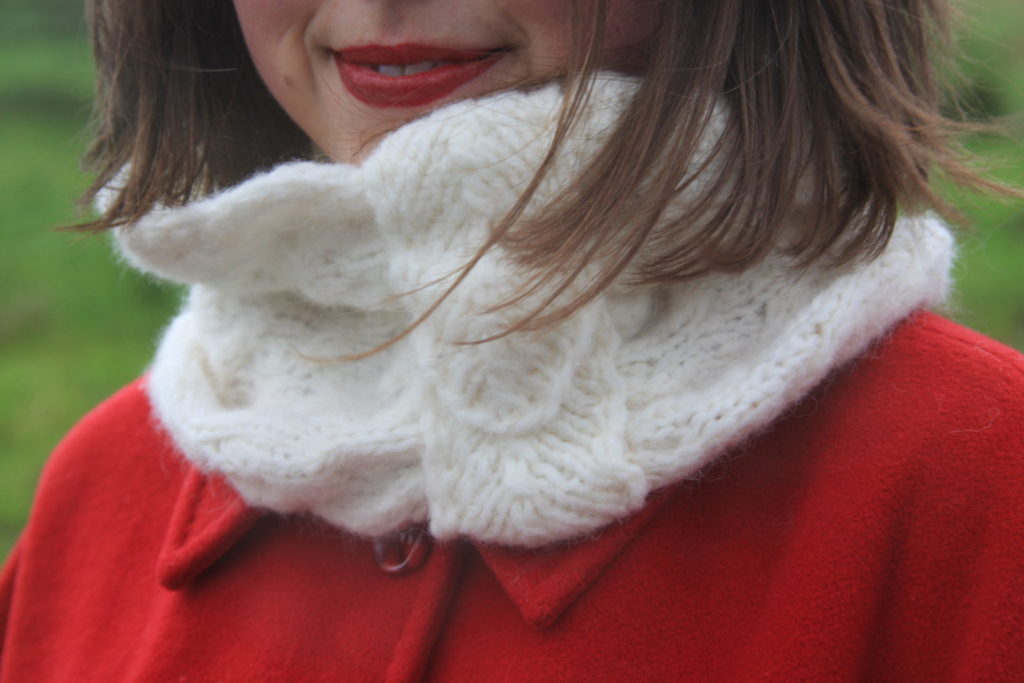
As always, thank you for reading. Please take care and stay healthy!
Reed
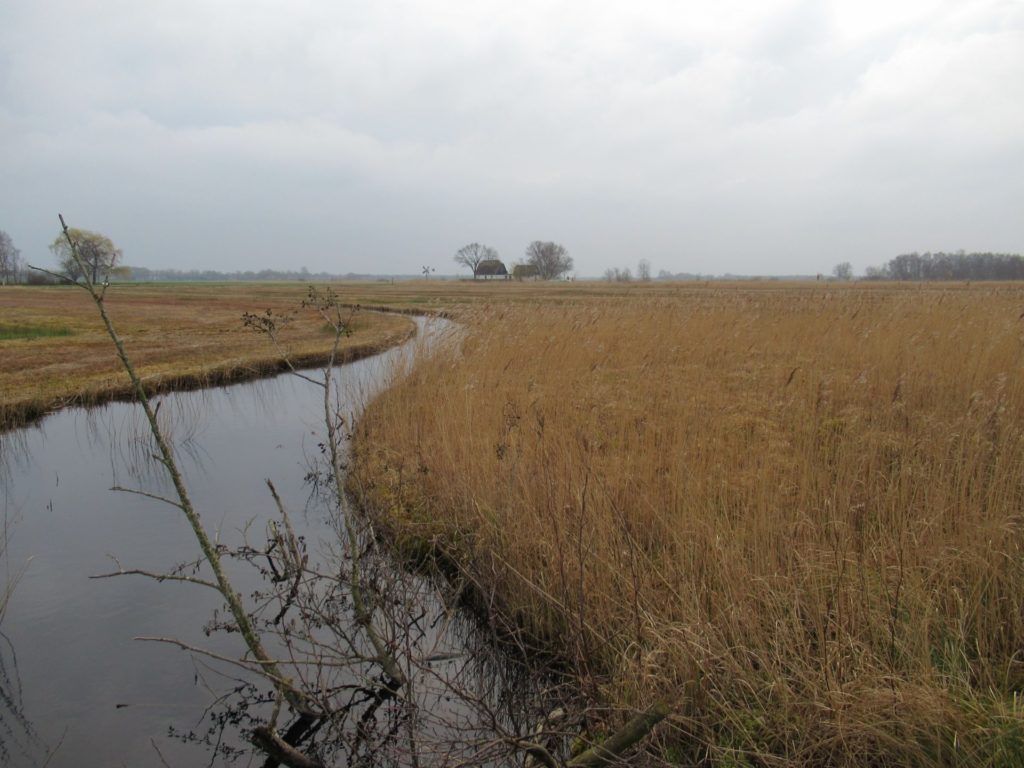
Hello, and an extra warm welcome today! I sincerely hope that you are in good health and able to cope with life’s stresses in this strange and scary world we suddenly find ourselves in. And I also hope that you get all the support you need if you have health problems or are struggling with this new reality in any way.
I’ve been wondering what to do, here on my blog. I had planned to write about the area where I found the inspiration for a new knitting design, but it all felt rather futile under the circumstances. I could write about how the pandemic impacts everyday life here, in the Netherlands, instead. But how would that help?
After giving it some more thought, I’ve decided to stick to my original plan. I’m not a doctor, nurse or other healthcare professional. I can’t help anybody in that way. What I hope I can do, is offer some comfort, inspiration and cheer through my words, pictures and knitting. A breath of fresh air for everybody cooped up at home and something different for worried minds to focus on.
Would you like to join me on a short virtual tour of ‘our’ wetland?
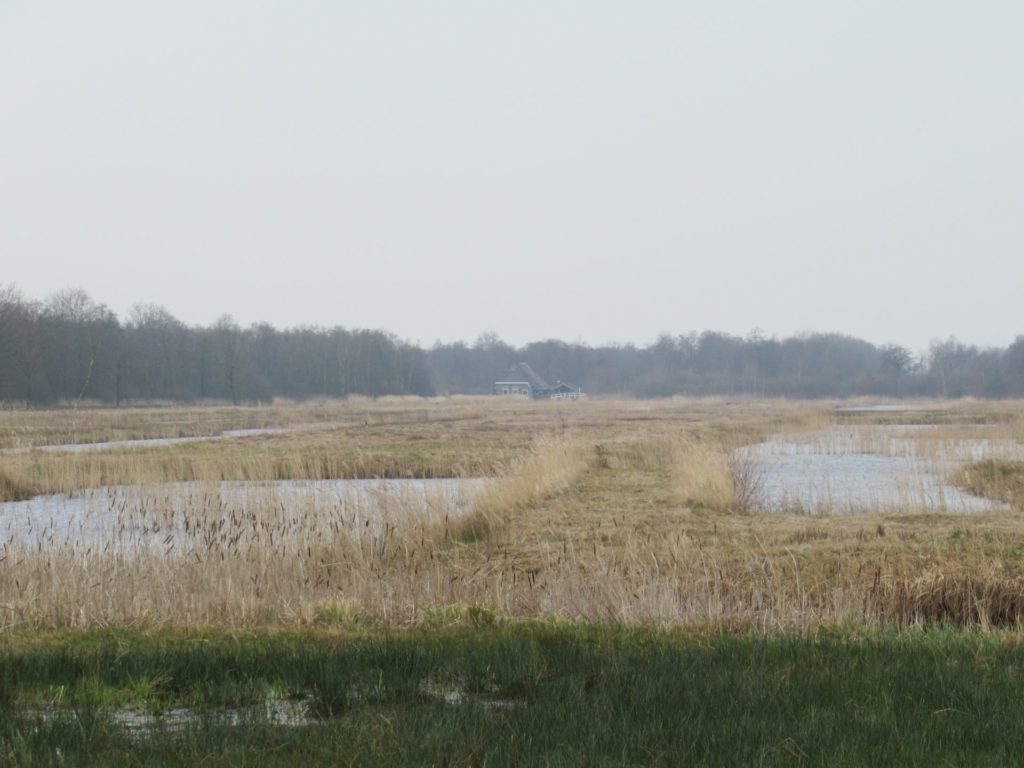
We have the great good fortune to live close to two National Parks. To the North-East there’s a large area of woodland and heath. (For my regular readers: that’s where the flocks of sheep live.) And to the South-West there’s a wetland area.
This is, in fact, the largest lowland bog in Northwest Europe. It is ideal for cycling – there are miles of bicycle tracks and meandering narrow roads.
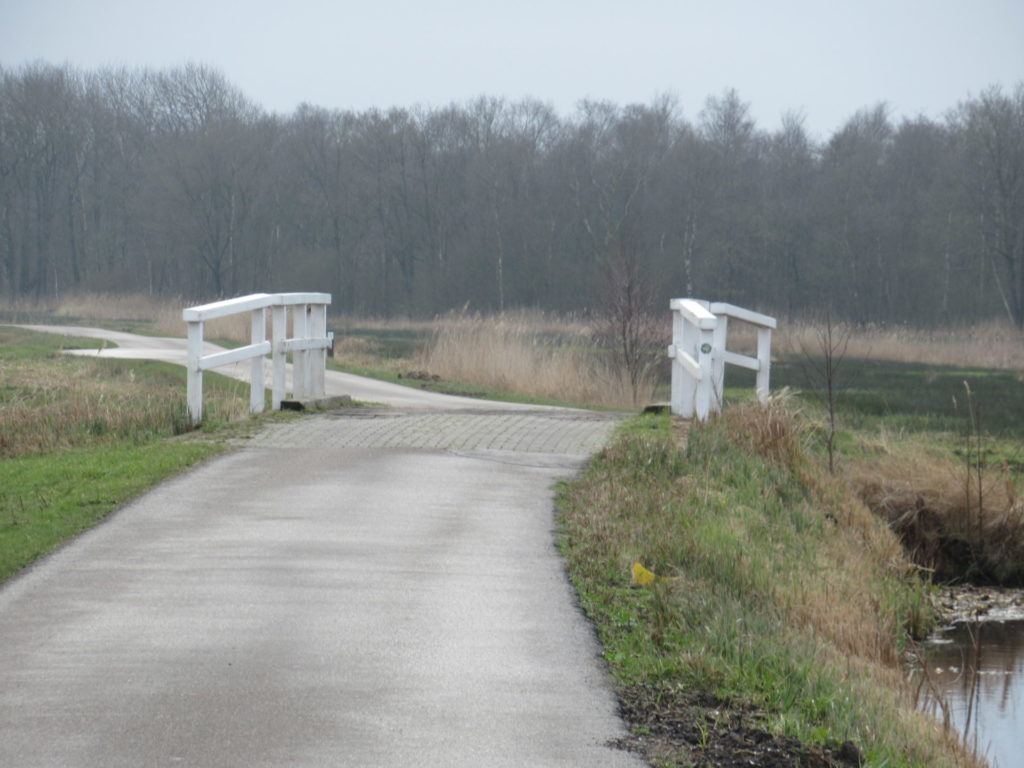
At this time of year, this open landscape can be rather bleak, with chilly winds. But one cloudy and windy day, about a fortnight ago, I braved the elements and took some photographs.
In summer the area is overrun by tourists from all over the world. Normally there would be some shivery visitors around taking selfies even in March, but now, with Covid-19 forcing them to stay at home, it is deserted.
The canoes and the soundless ‘whisperboats’ are waiting for busier times.
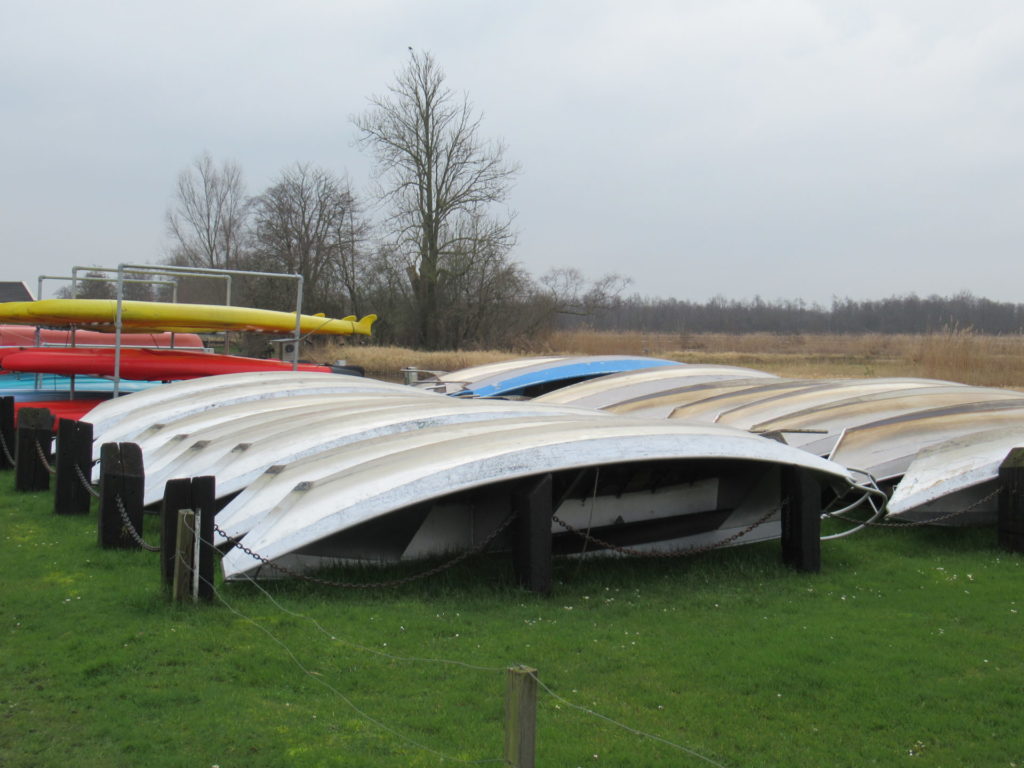
I could tell you about the picturesque villages, the crocheted curtains behind many windows, the various types of windmills, or the birds, flowers and butterflies, but I’m keeping all that for later. Today, I’ll focus on the landscape, and especially on reed.
Apart from lakes, canals and wet grasslands, there are extensive reedlands, often right behind the houses.
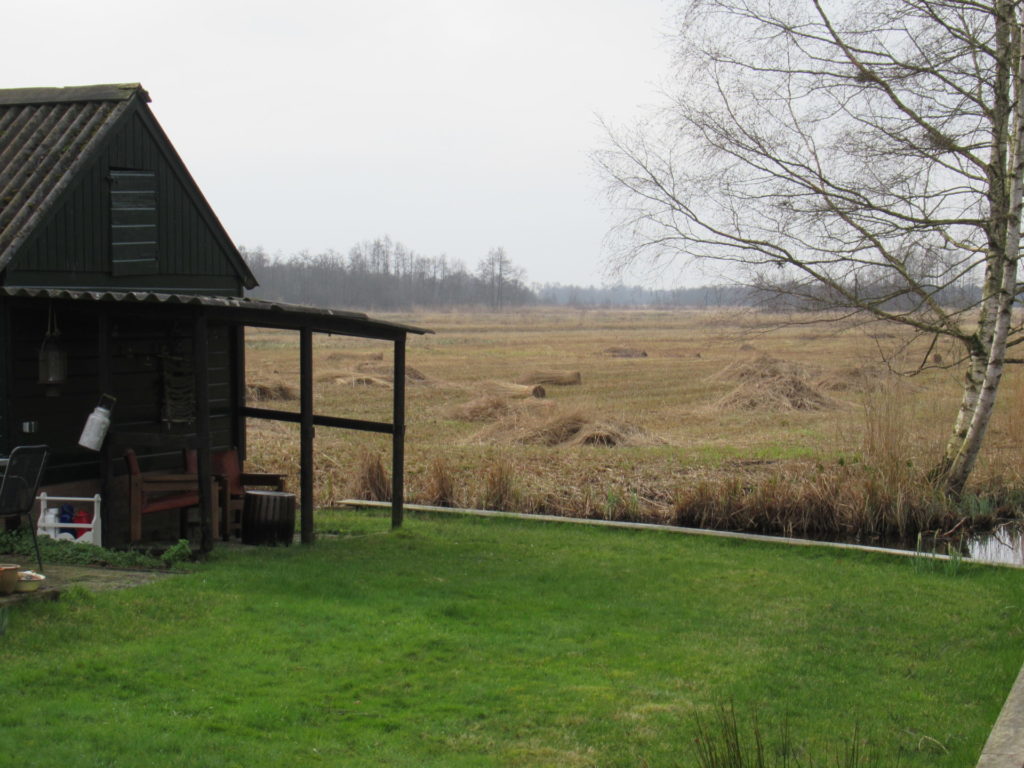
Mowing takes place in winter, and in March much of the reed has already been mown (right half of photo below). The rest will follow soon or is left as it is for the birds and other wildlife.
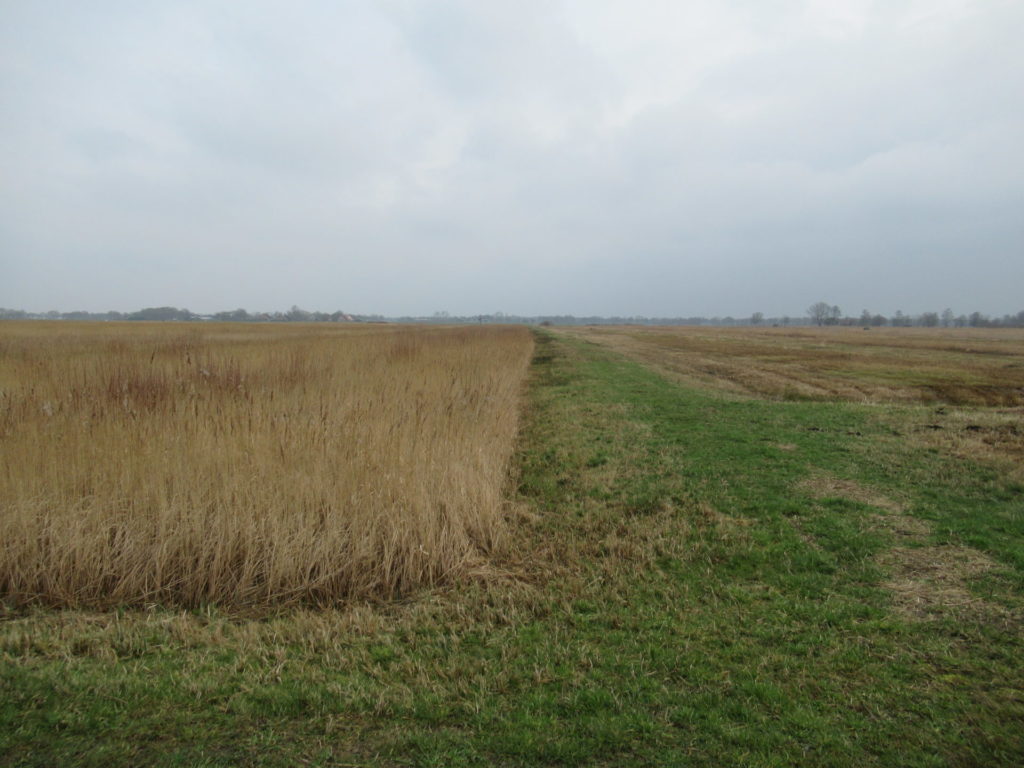
A statue in one of the villages shows a traditional reed worker taking a break.
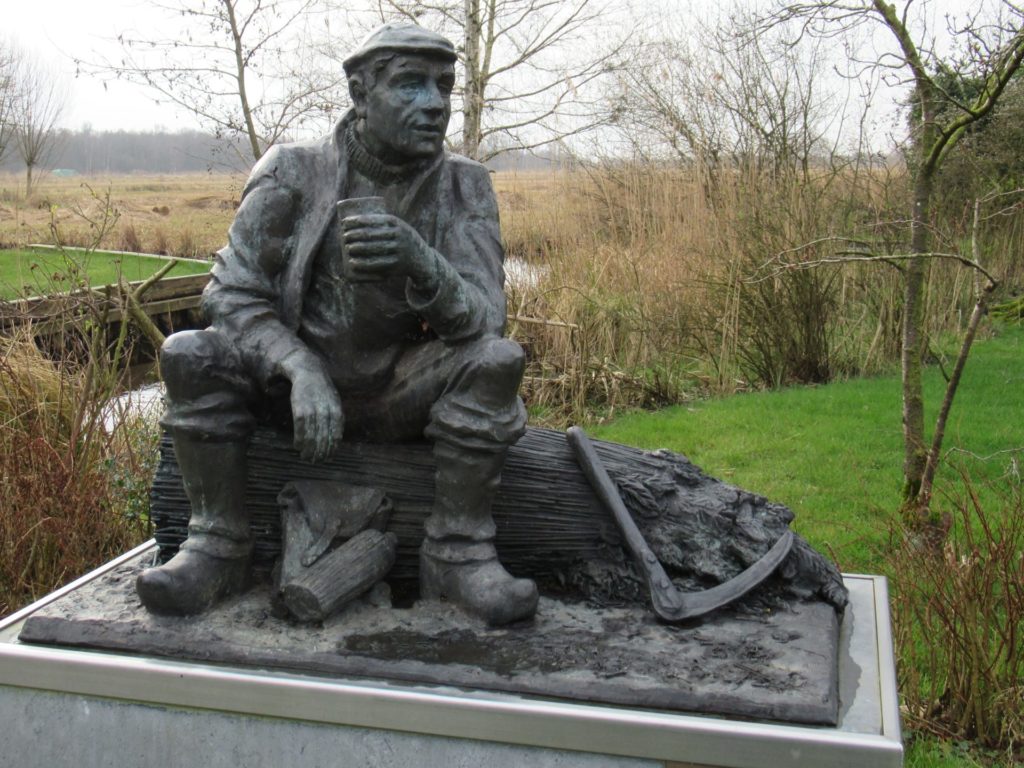
Nowadays, the work is done with modern motor mowers. Then the reed is tied into bundles and stacked along a waterway…
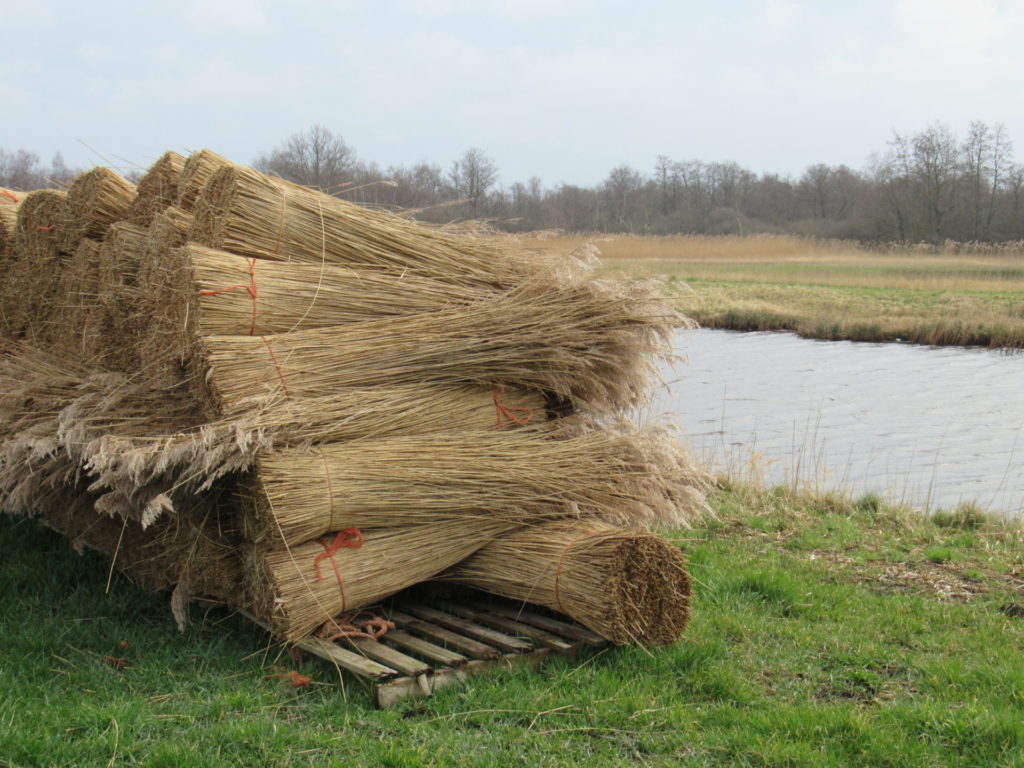
… or in the corner of a field and covered with plastic sheeting…
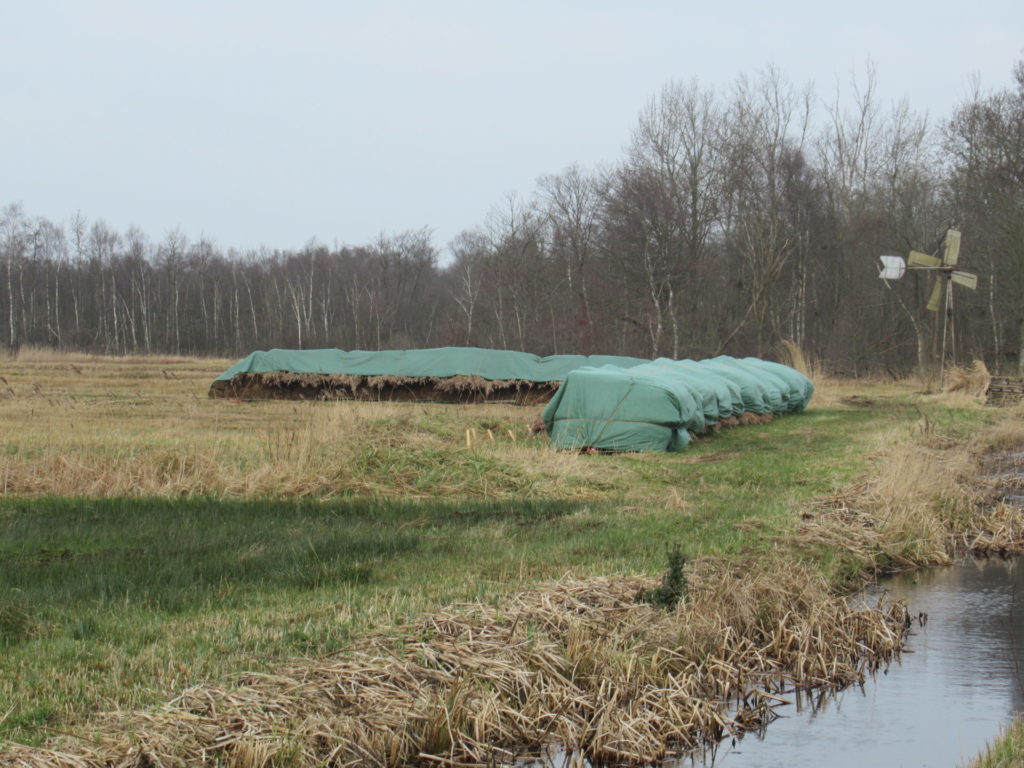
… to be collected with a tractor and trailer or transported over water on a flat boat:
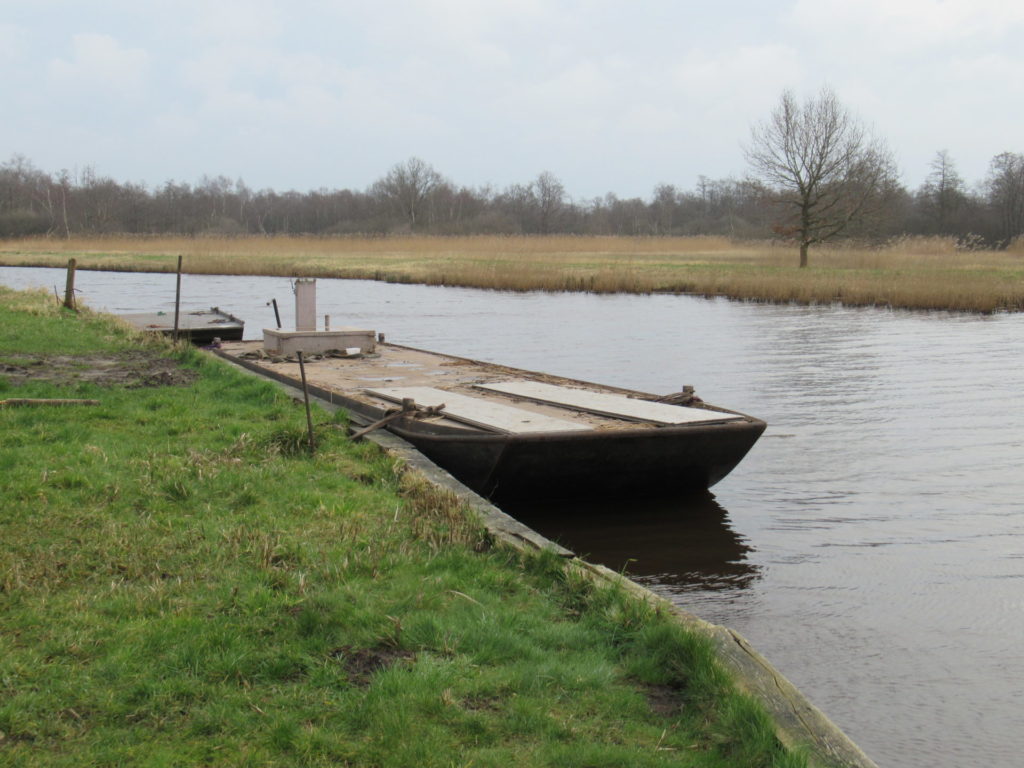
Not surprisingly, many houses around here have reed roofs. The oldest thatched houses are very small – tiny houses avant la lettre.
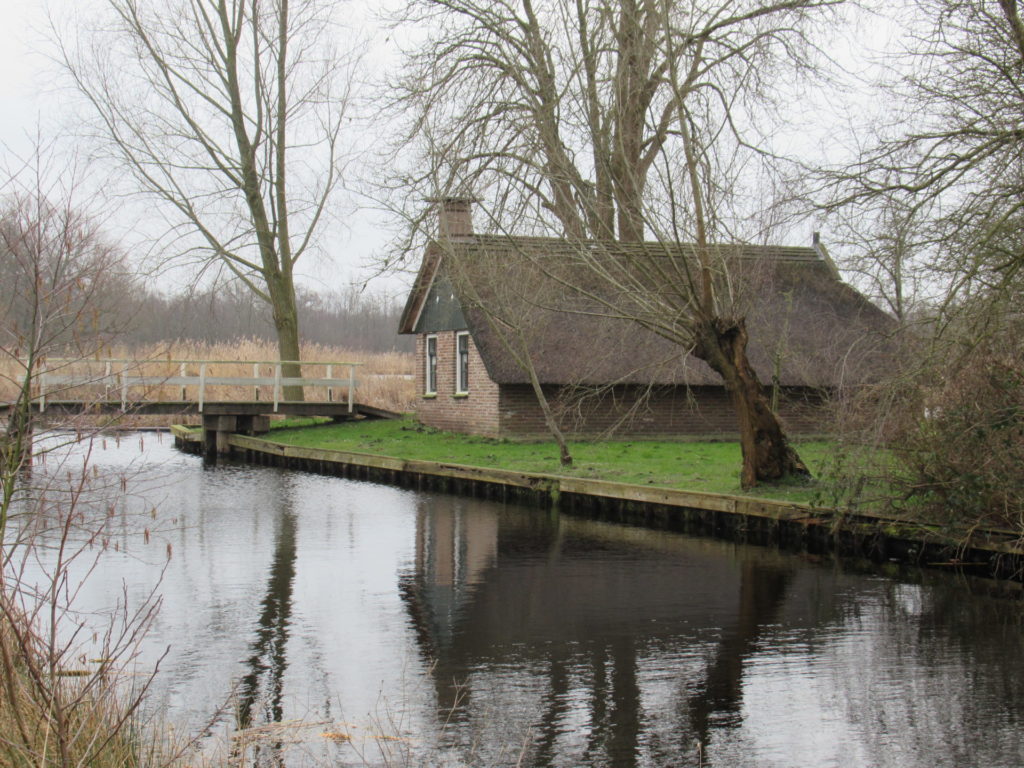
Most of these are now rented out as holiday cottages. On the outside they look exactly like they did 100 years ago, and they do still have an original bedstee (a bed inside a sort of cupboard), but otherwise they have all mod cons.
There are also some fairly modest new houses with reed roofs…
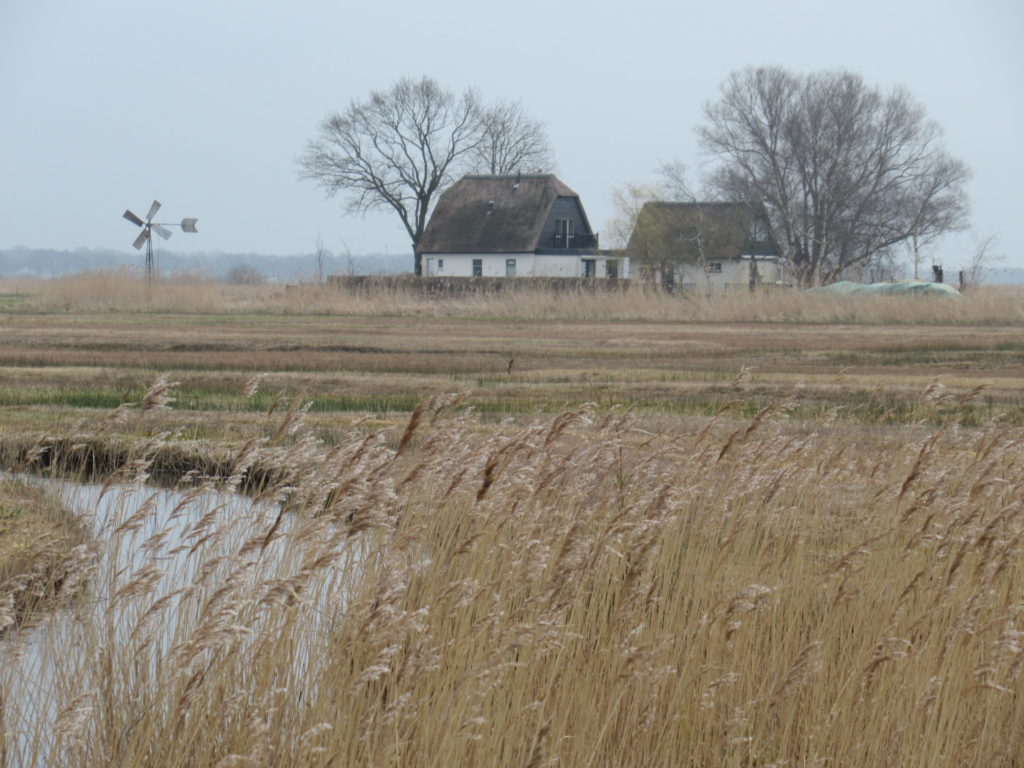
… as well as more luxurious ones:
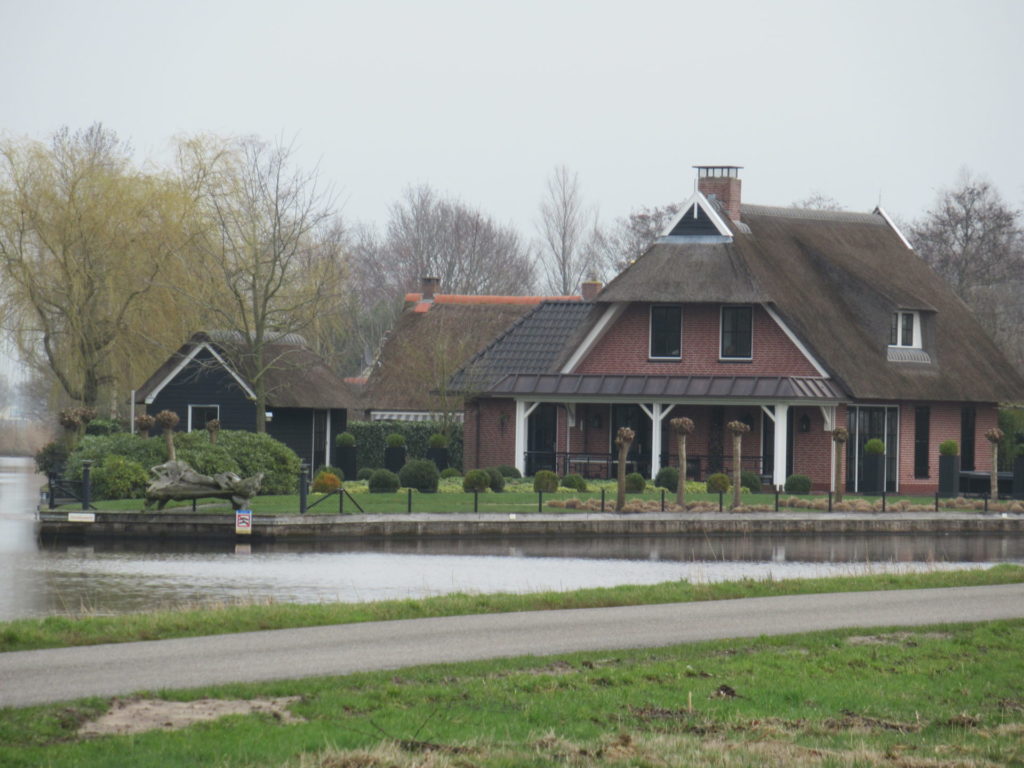
Although I’m happy with our own house, and wouldn’t want to move at all, I always love looking at other people’s houses, especially if they’re as lovely as these.
I did say that I wouldn’t talk about birds today, but I just have to show you these storks I saw on a nest:
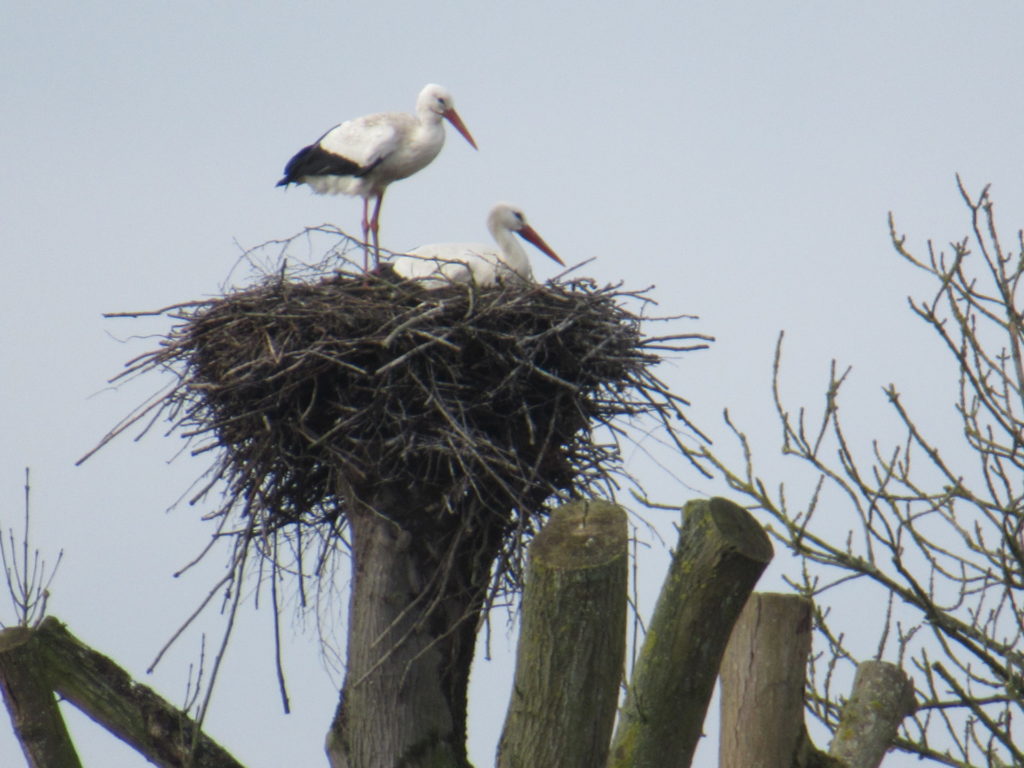
Many people around here provide storks with nesting places in the form of wagon wheels placed on high poles, or on a dead tree as here.
Just as I was heading home, the sun peeked out from behind the clouds. Standing in the nippy wind, looking out over the shimmering water surface, with a couple of graylag geese in the foreground, a cormorant primping its feathers a little further away, and the sound of other water birds in the distance… a moment of bliss.
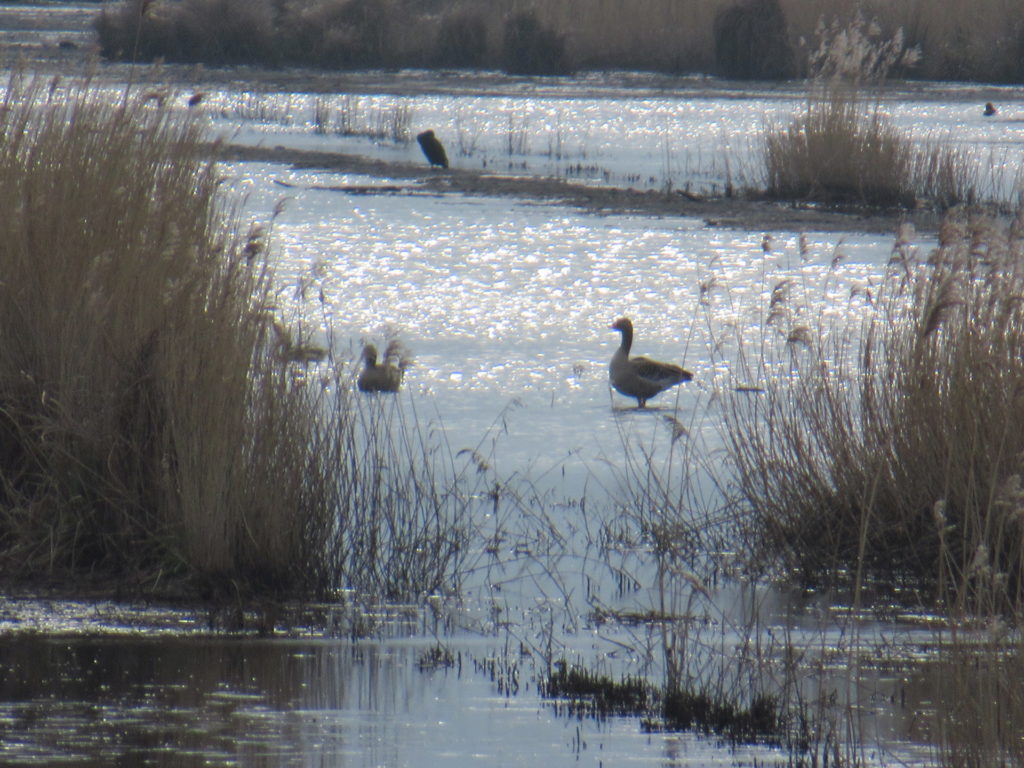
One of the inhabitants of this reedland (not in this photo) formed the inspiration for my new knitting pattern. I’m busy finishing everything and hope to tell you more about it soon. For now, take care and stay well!
Oh, and if you’d like to read more about this National Park, do visit the official website.
Finishing Willapa
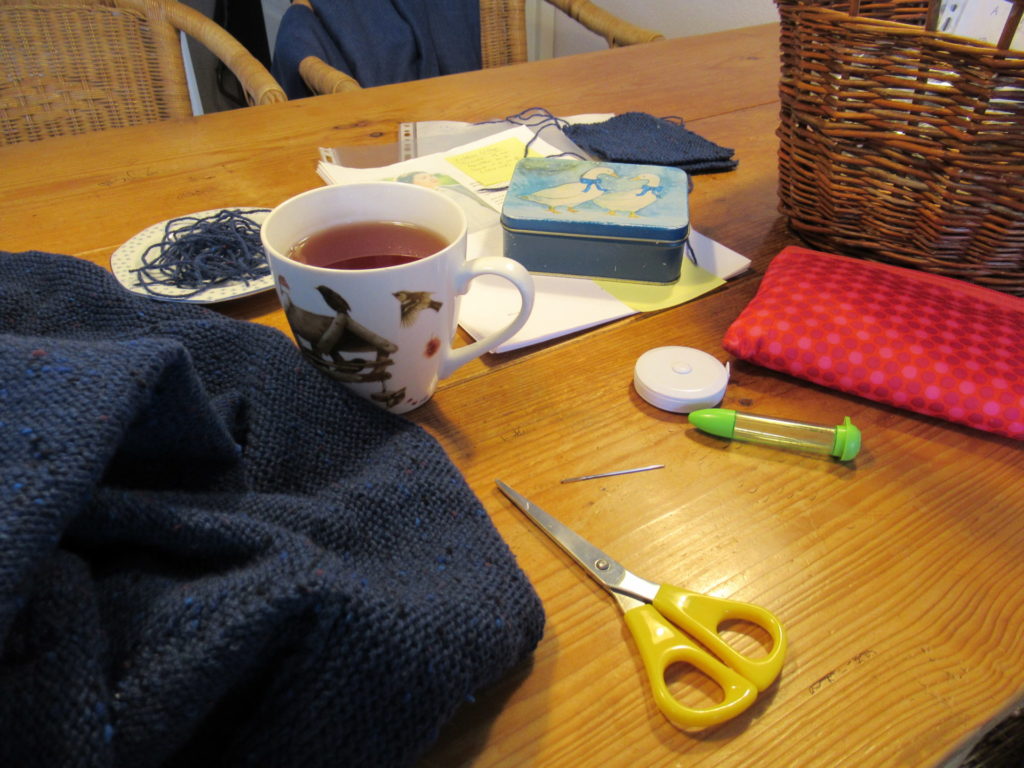
Hello! Today it’s all about knitting (and some music). I’m sorry to disappoint the non-knitters among you – I promise to write about something of more general interest next time.
I had been feeling a bit off-colour for several days, but struggled on until I thought, ‘Enough is enough’ and gave myself an afternoon off. I brewed a pot of tea, put on some music and spread an unfinished knitting project and everything I needed to finish it out on the dining table.
Do you remember me writing about UFOs and my New Year’s resolution to finish (or frog) them all? Well, this the first one. It is a cardigan called Willapa that was designed by Annie Rowden for Brooklyn Tweed. This is the front page of the pattern with a ball of the yarn I used:
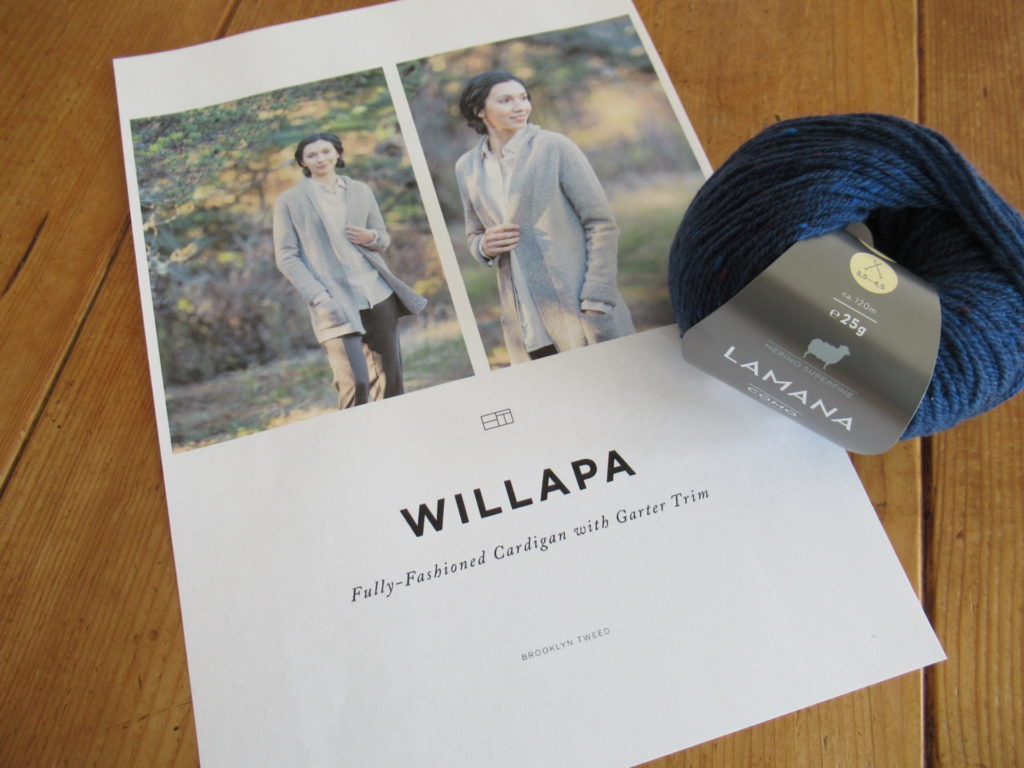
I would have liked to make it from the original yarn, Brooklyn Tweed ‘Loft’, but the only shop in our country stocking that had run out of my colour choices A, B and C. I chose Lamana ‘Como Tweed’ instead. The yarns are similar, but not the same. They are both fingering weights, both tweedy, and both knit up to the same gauge. But Loft is more rustic and has (imho) more interesting colours, while Como Tweed is airier and softer.
So, why did this cardi become a UFO? I’m not entirely sure.
It was almost finished, but very soon after I’d started the front border, the frog chorus started to chant ‘Rip-it, Rip-it’.
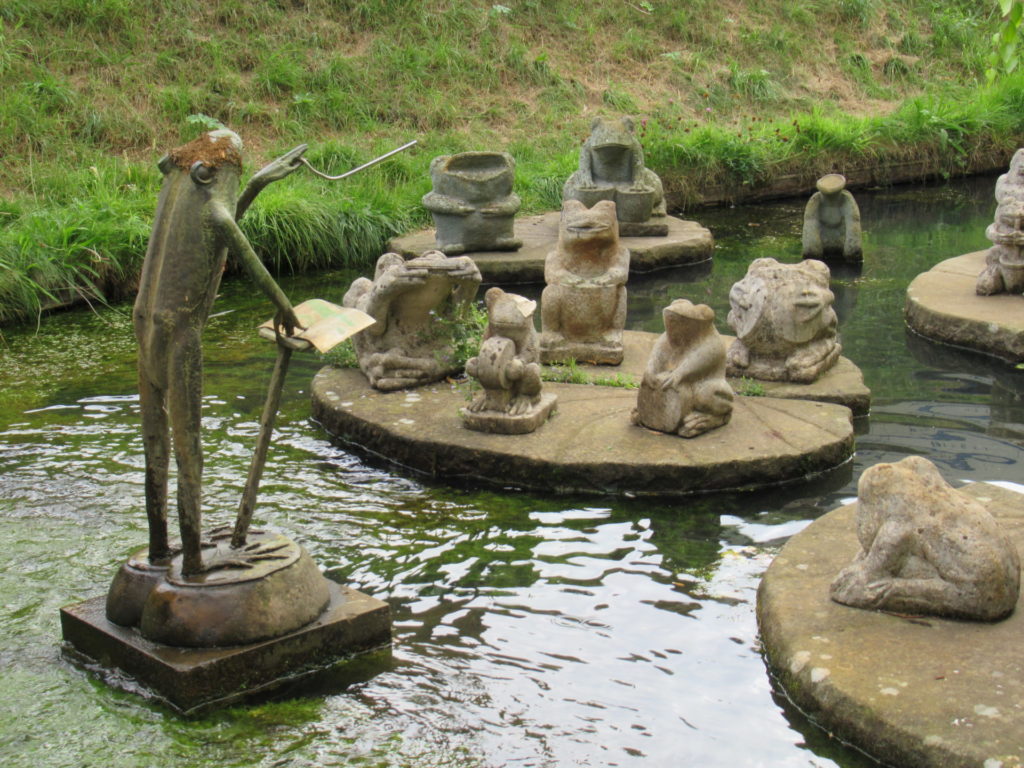
The pattern said ‘slip the first stitch PURLWISE with yarn held in back’, while I would have chosen ‘slip the first stitch KNITWISE with yarn held in back’. I had my doubts, but thought, ‘How much difference can it make whether you slip a stitch purlwise or knitwise?’
So, I ignored the frogs and knit on. And on and on. It wasn’t until it was time to bind off that I decided I wasn’t happy with the edge stitches at all. They were different on the left and right and looked untidy.
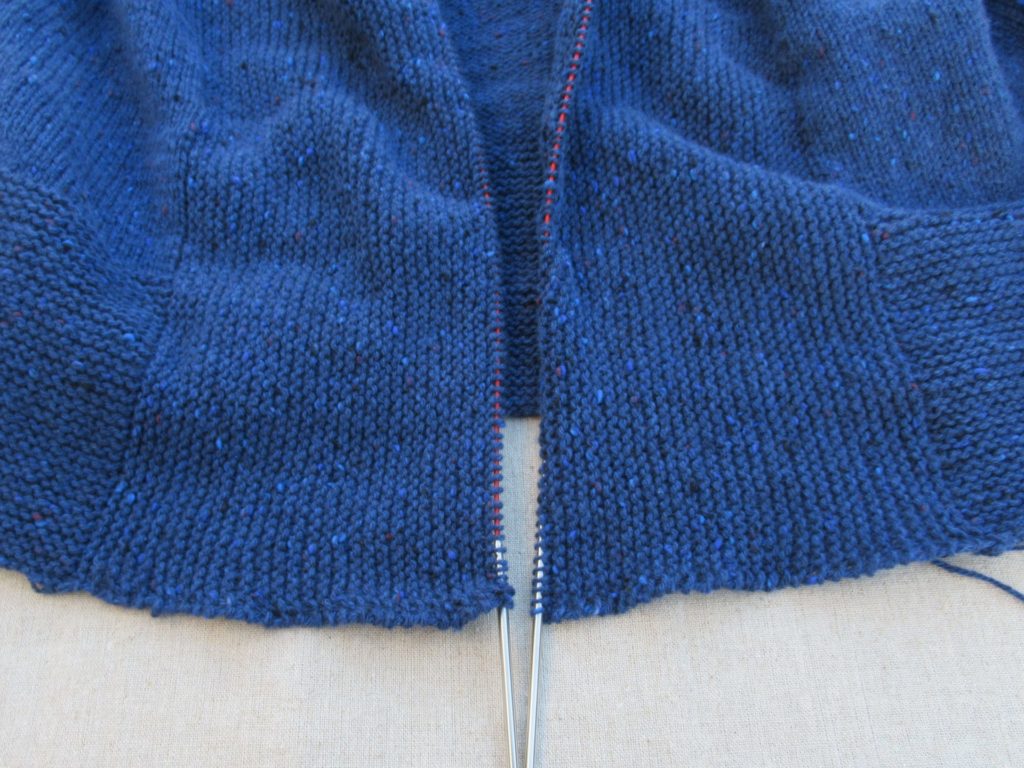
But before I followed the frogs’ advice and ripped out many hours of knitting, I knit a swatch to check if slipping the first stitch knitwise would really be better than to slip it purlwise:
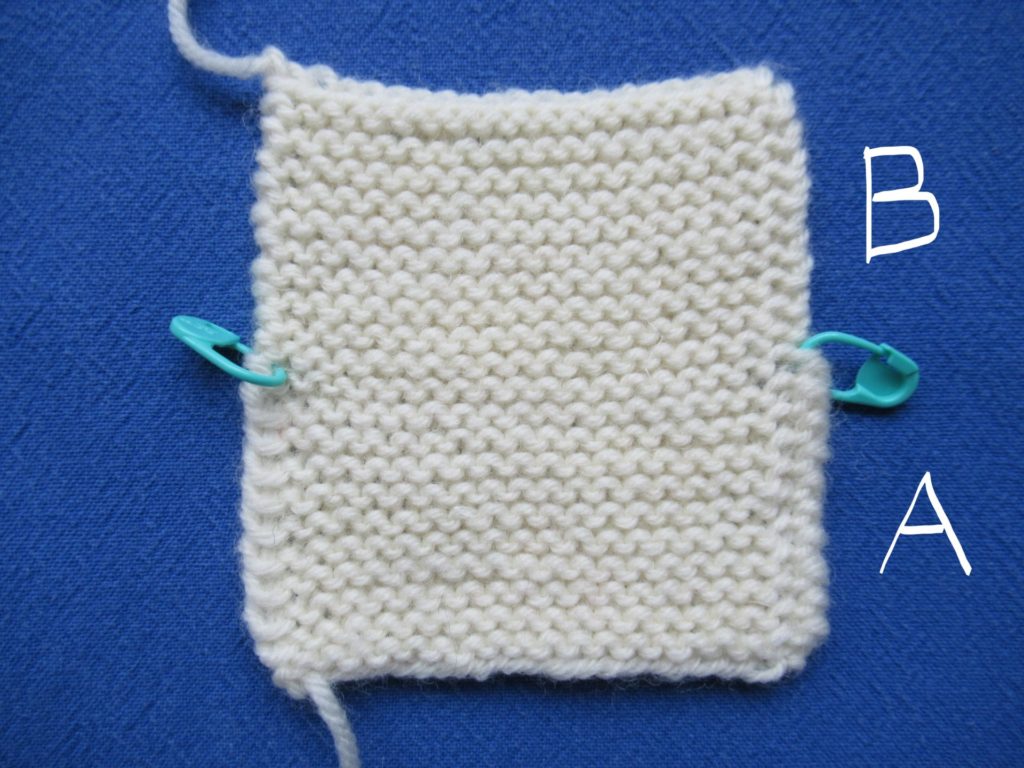
Yes, it did make quite a difference. The bottom half (A) of the swatch was knit slipping the first stitch of every row purlwise, the top half (B) slipping them knitwise.
Slipping the first stitch purlwise gave a stretchy/loose edge with a very different left and right side. Slipping the first stitch knitwise made the edge firmer. There was still a slight difference between left and right, but that was hardly noticeable.
So, I frogged the front border, knit it again, and was glad I’d taken the trouble.
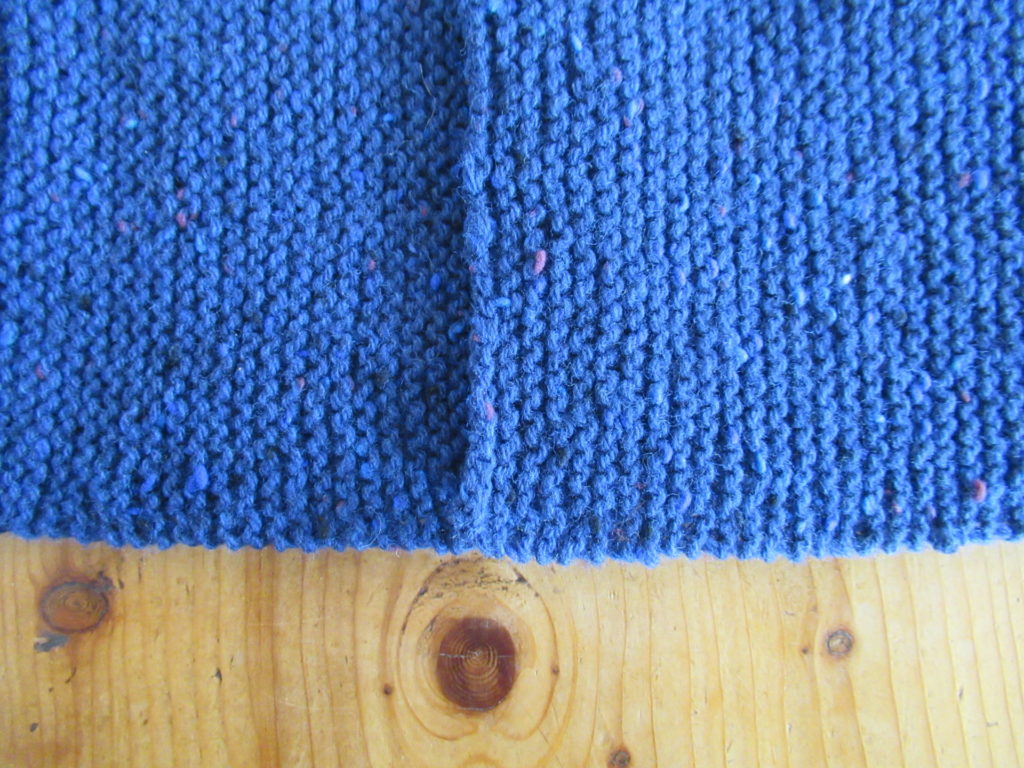
At this stage Willapa was still a WIP. After the front border I knit the pockets and all the knitting was done. It was then that it became a UFO. I suppose it was because it was almost summer by then, and a warm cardi seemed irrelevant. And also because I dreaded weaving in all those ends and wasn’t happy about the pockets.
Well, my afternoon off solved all that. Weaving in the ends took about an hour, but was quite pleasant with some good music on.
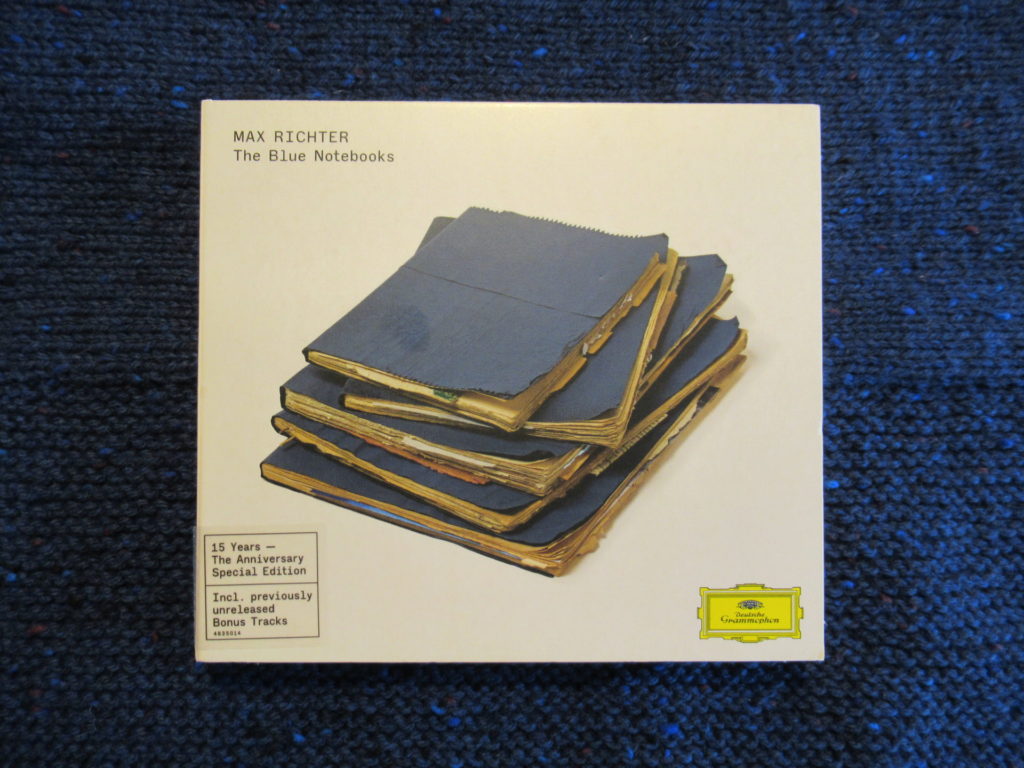
My husband isn’t a big fan, so I only play this music when he’s not there. But I love it, especially On the Nature of Daylight. It is something between classical and minimal music, and the composer’s own website says, ‘The Blue Notebooks is a subtle and peaceful protest against political, social and personal brutality.’
With that peaceful protest in the background, I found the courage to finish my cardigan. Here it is:
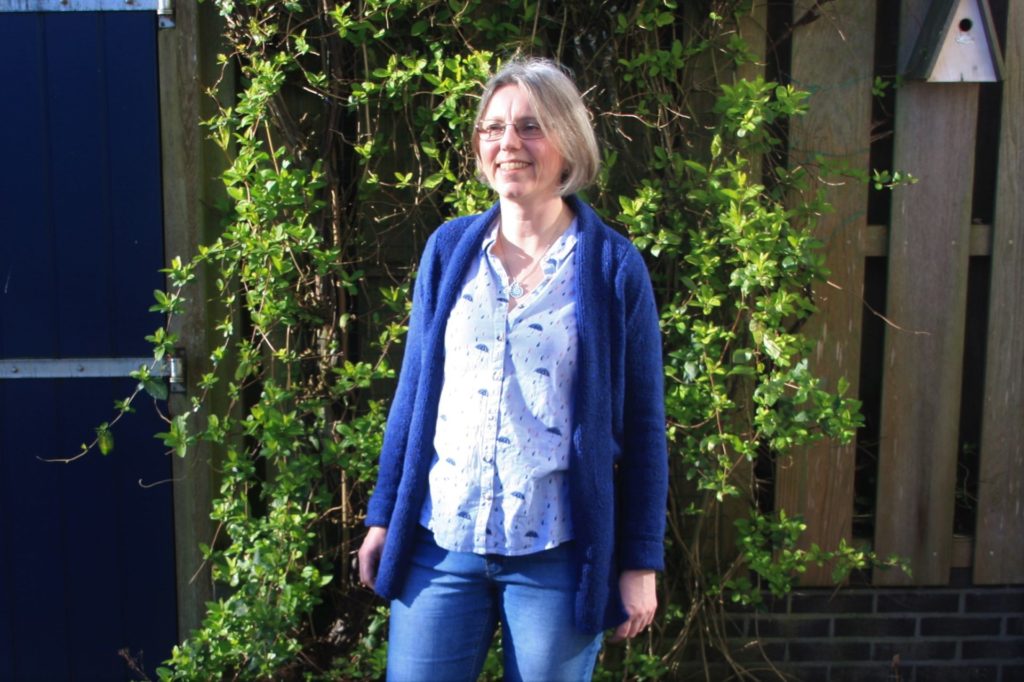
It has a very wide front border, widened at the neck with short rows, that can be turned down to a nice collar.
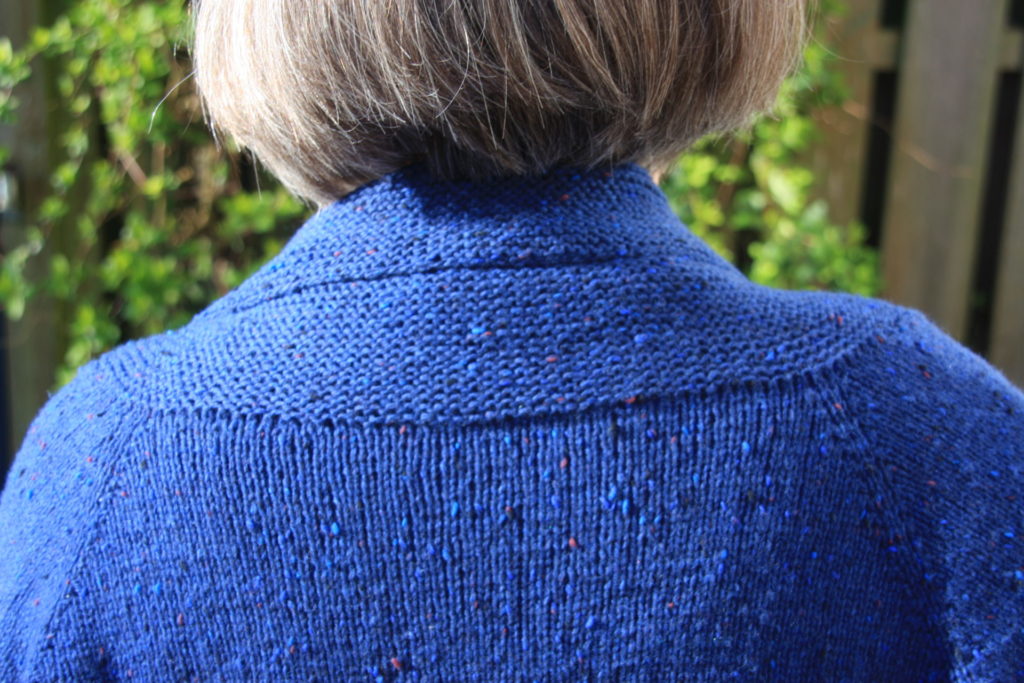
Following the instructions in the pattern, the pockets would have ended up exactly on the sides of my hips. This is already my widest part, and it doesn’t need to be accented by pockets. So I moved the pockets down and forward, where they almost disappeared into the lower border:
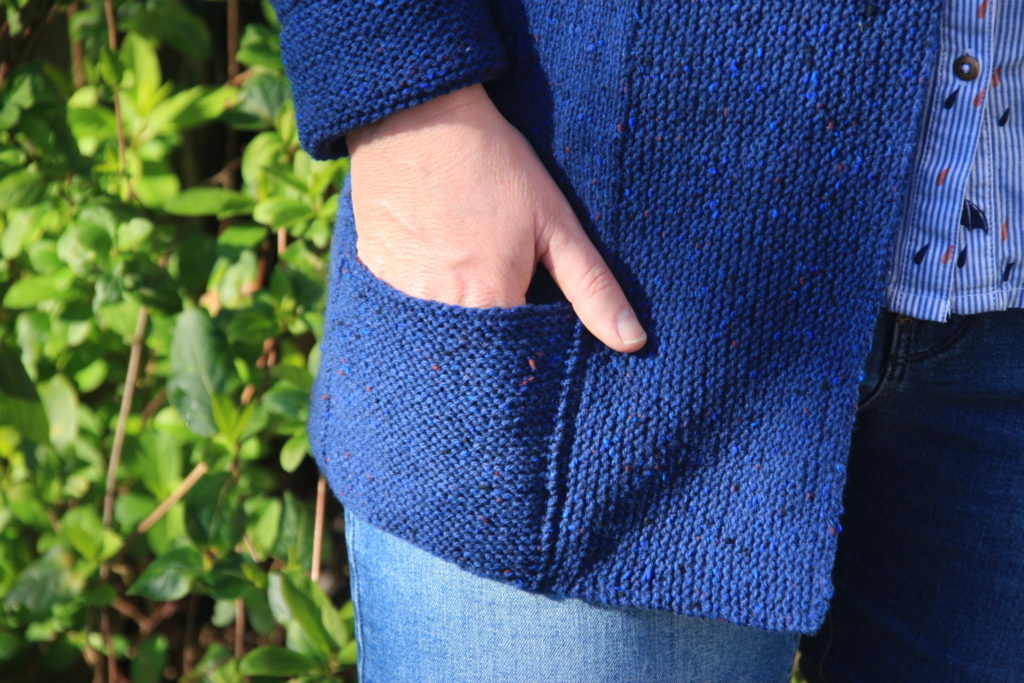
Unlike the pattern, I used the same edge stitch for the pockets as for the front border (slipping the first stitch knitwise). The pattern didn’t say how to sew on the pockets. I tried out several ways, and in the end just used ordinary small back stitches. The pockets are on the small side, but big enough for a hankie or a slip of paper with some notes.
Willapa is knit from the top down, has narrow sleeves with wide cuffs meant to be folded double, and has lovely raglan shoulders.
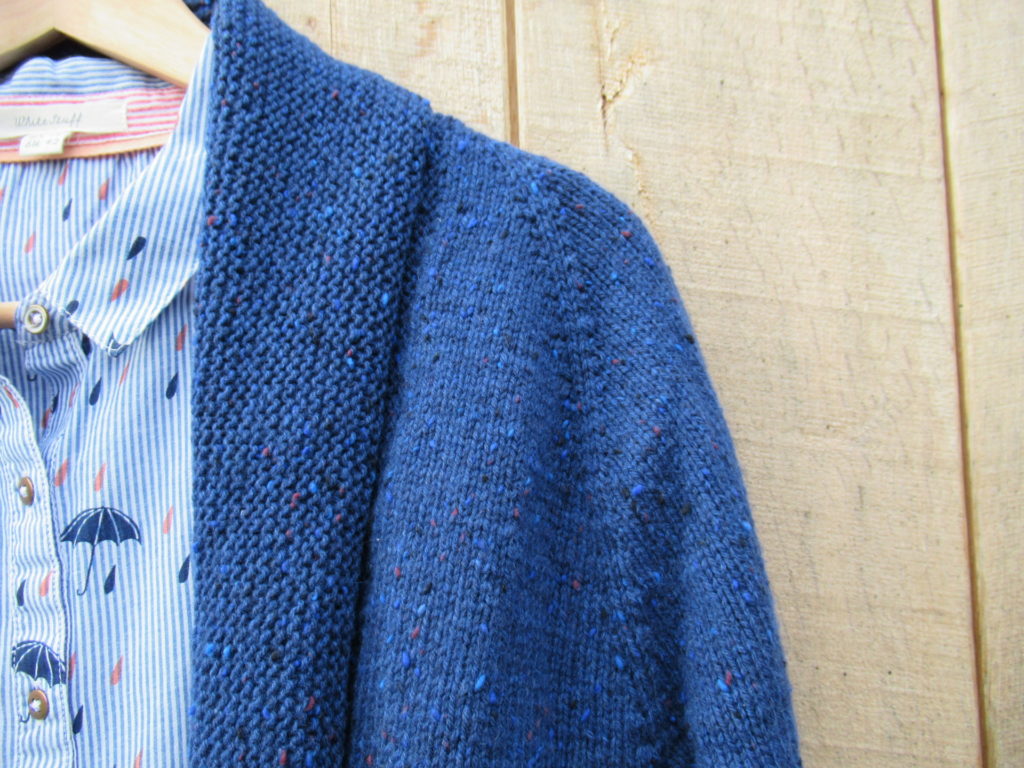
All in all I’m very happy with the pattern, the yarn and the end result. If you’re looking for a simple, but definitely not frumpy looking cardi to knit, I can really recommend Willapa. You can find it on Ravelry and on the Brooklyn Tweed website. It is a well-written pattern and, apart from the edge stitches, there is much to love about it. I hope my notes are helpful for anyone making it.
(I can also recommend taking an afternoon off when you’re not feeling quite well.)
So this was my first UFO turned FO. One down, eight more to go.
March Miscellany 2020
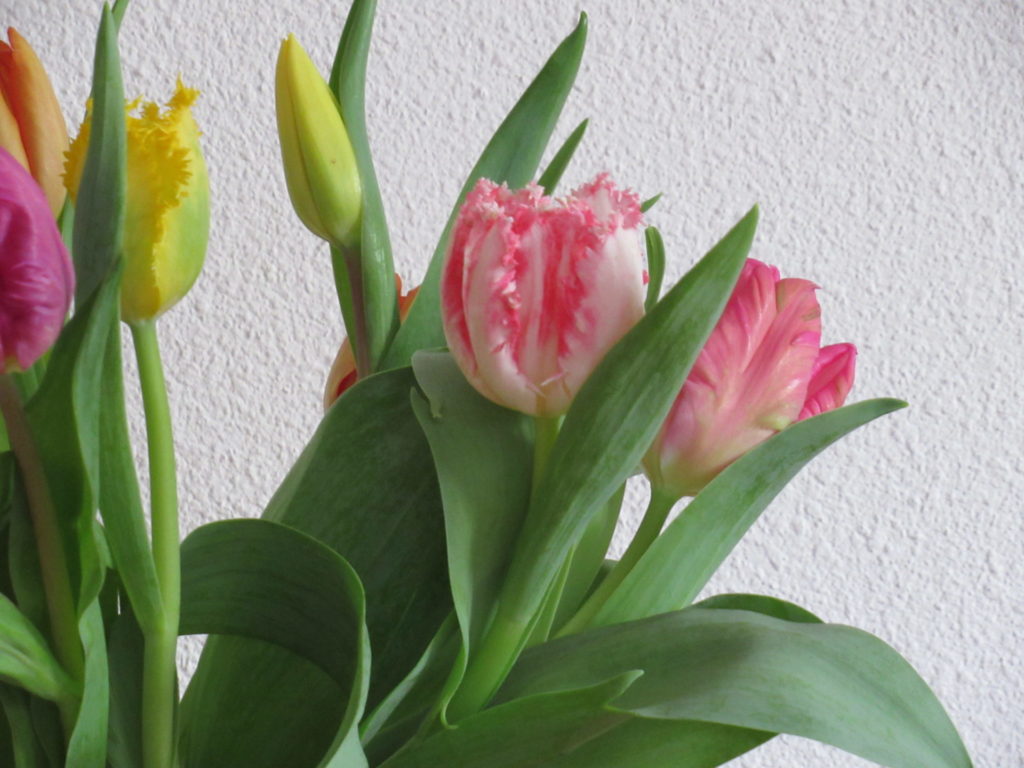
Hello! How are you faring? We’ve had a lot of wet and windy weather here lately. The wettest February on record, our Meteorological Institute tells us. We could use some water after the past two very dry summers, but did we really need as much as this? I hope your feet, like ours, are still dry.
They also tell us that this was the second mildest winter on record, with the average temperature three degrees higher than normal. I can’t see this as anything other than a sign of rapid climate change and it worries me a lot. What can we, insignificant individuals, do?
Flowers never fail to cheer me up on dark and dismal days. I especially love roses, but roses flown in from Africa? Probably not the best idea. Tulips grown locally seem a more sustainable choice. I’m not terribly fond of tulips, but I’ll try to appreciate them more. I do love other indoor bulbs, though, like the magnificent amaryllis.
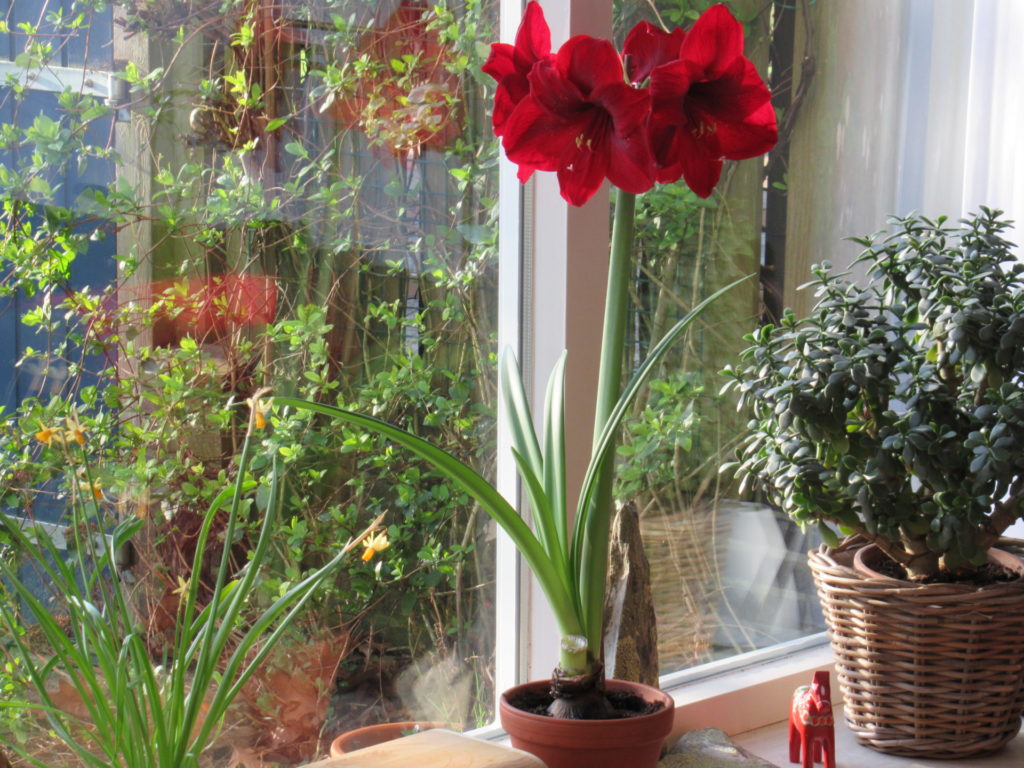
Bought from our neighbours’ boy, who sold them for a school project, I planted it in early December. It took a long time to come into flower, but when it did, wow!
Our front garden is still very bare after last year’s reconstruction, but some of the bulbs we planted are now starting to appear. Thank you, brave little dwarf iris, for your elegant flowers and beautiful colours.
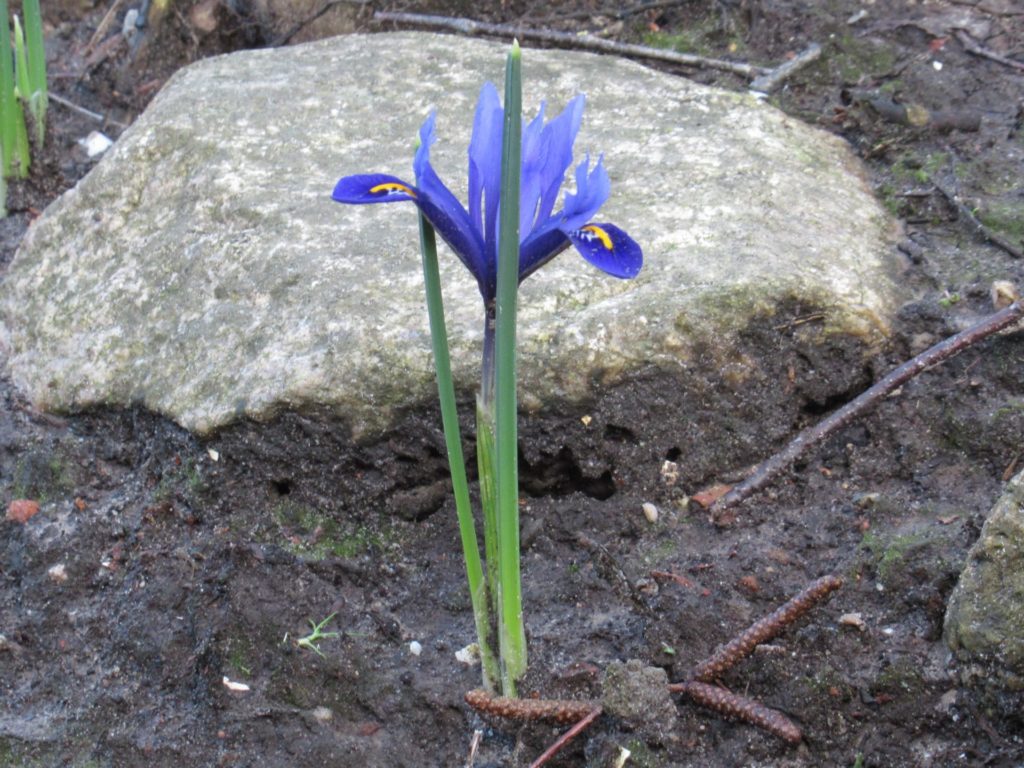
I called this blog post March Miscellany because there are all kinds of things I need to show and tell you. I hope you can spare a few minutes more.
First there is the shawl where I was dithering over whether or not to include the grey. The entire crafts group at our local library and almost everybody else I asked said: ‘Leave out the grey.’ I felt the same. The other colours were harmonious together, the grey was the odd one out. And yet, and yet…
Then I looked at the book I was reading and knew what to do. Two tiny rows of grey stitches at the colour changes, a little like the small stones in the mosaic borders along the fresco from Pompeii on the front cover. That’s what I would do.
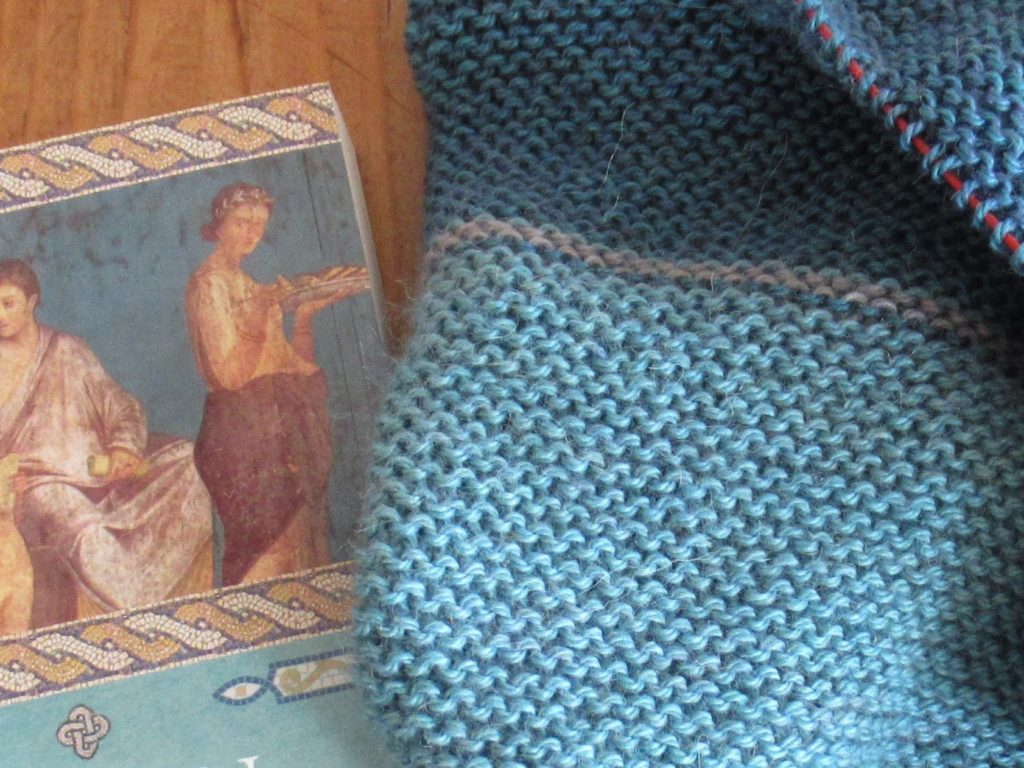
For those of you who’ve given me advice: thank you! Even though I didn’t do exactly as you said, your input really helped. It supported me in my feeling that an entire block of grey would spoil the shawl and made me look for other options.
This is what I was/am still reading:
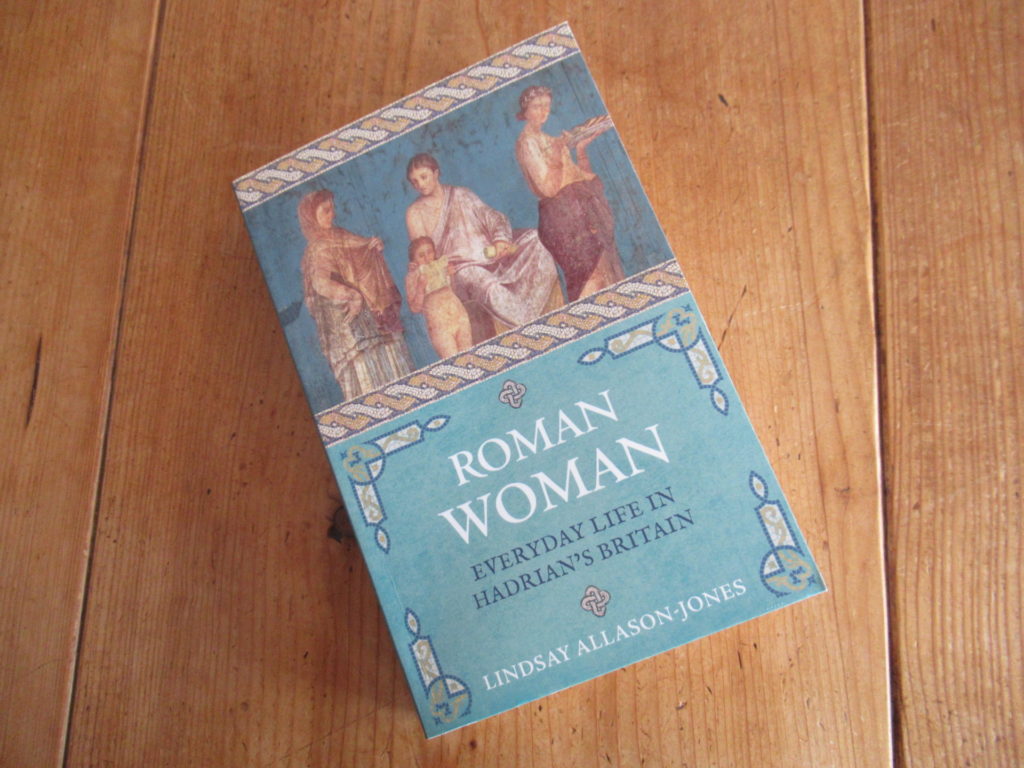
Roman Woman, written by an archaeologist, is about a year in the life of Senovara, a young woman with two children, married to a Roman veteran turned shoemaker. It is AD 133 and the family lives in York, then called Eboracum. The chapters follow the months of the year, from Ianuarius to December.
Allason-Jones has cleverly woven loads of humdrum details of everyday life in Roman Britain into an engaging story. We see Senovara caring for her family, ‘ironing’ her laundry (rubbing the creases out of her linen with a glass ball), doing her shopping, visiting with friends and going to the bathhouse. I had no idea that women at that time already plucked their eyebrows and used depilatory cream!
Senovara is from a local tribe, while her husband is a ‘Roman’ from Germania, and I think it’s particularly interesting to read how different cultures and religions coexisted and merged.
Okay, on to the next subject. THIS IS A WARNING!
In a previous post I wrote about knit blockers. You know, those handy tools like small combs that can be used for blocking knitwork instead of T-pins. Well, recently I used them to block the swatches I knit for a new design of my own, in an airy, bulky wool yarn. This is the back of one of them:
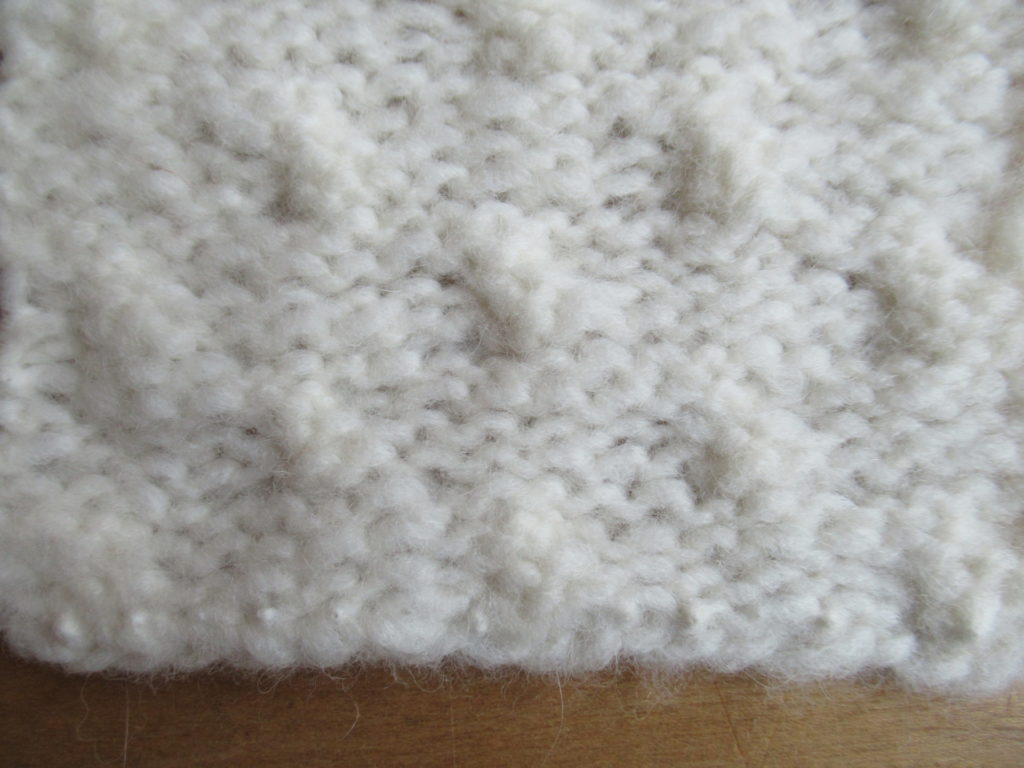
Now look at the bottom, and especially at the left-hand corner. Can you see those tiny little bumps? They are hard spikes that shouldn’t be there. Fortunately it’s just a swatch. Had it been a scarf, those bumps wouldn’t have felt nice against the skin at all. The tines of the knit blockers seem to have worked like felting needles, felting the wool in the places where they went in, and damaging the blocking mat in the process:
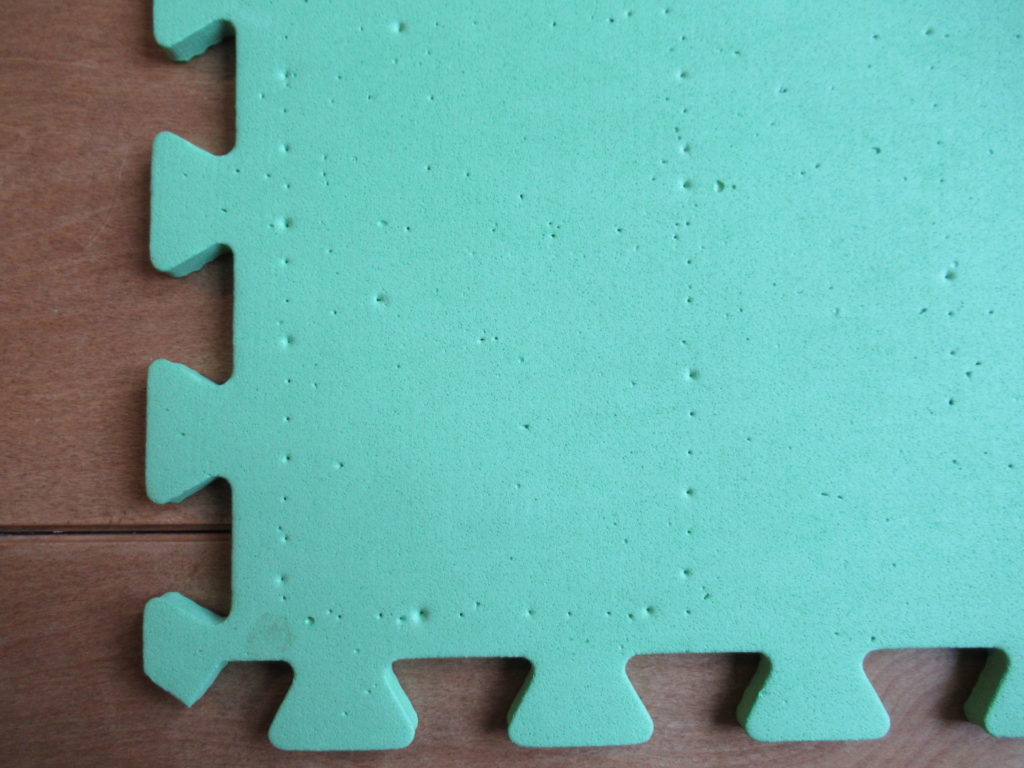
It is the first time this has happened to me. The other times I used the blockers they were fine, but I thought I’d better warn you. I’ll certainly use them again, but will be extra careful not to push through if I feel any resistance at all.
Okay, next subject again.
Finally, finally the yarn for our daughter’s sweater has come. It crossed the Channel several times, as it went back to sender for unknown reasons. And when it finally reached me, one of the skeins was a different dye bath. Grumble, grumble. Was this my punishment for buying yarn overseas instead of locally?
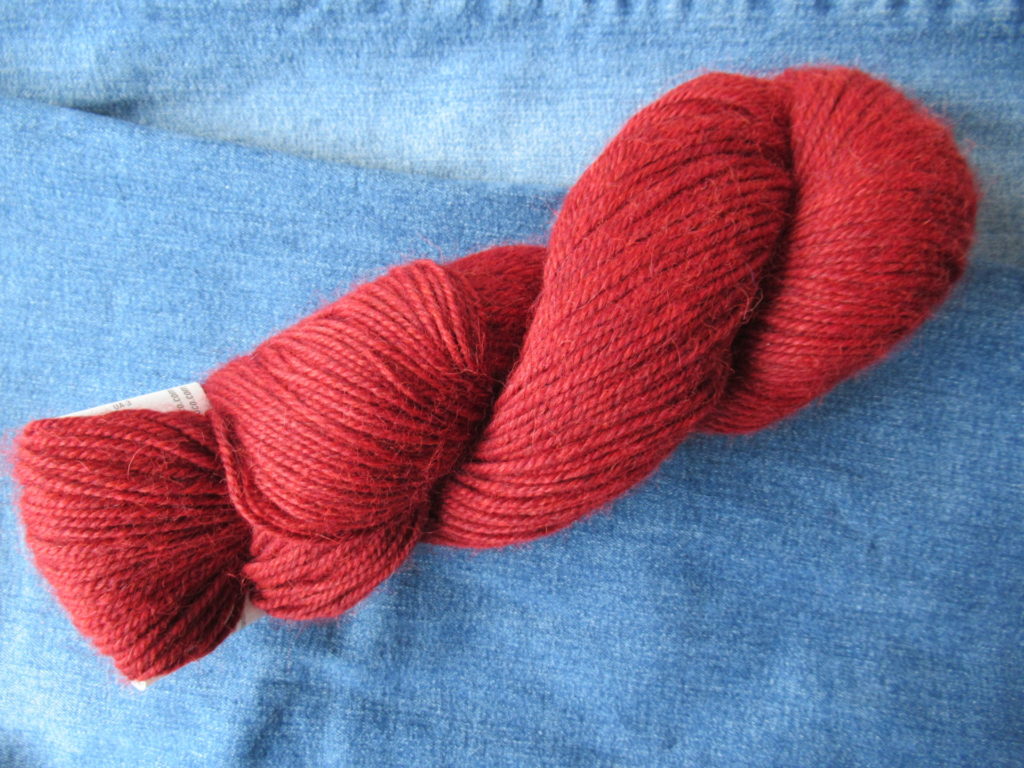
Oh, well, it won’t show if I use the ‘wrong’ skein for the ribbing. The colour our daughter has chosen is a beautiful deep brick red (darker than in the photo). I’m looking forward to starting!
I wish you a lovely weekend, with some nice knitting on your needles or a good book to read. And I hope to see you here again soon!
Funnel Beaker
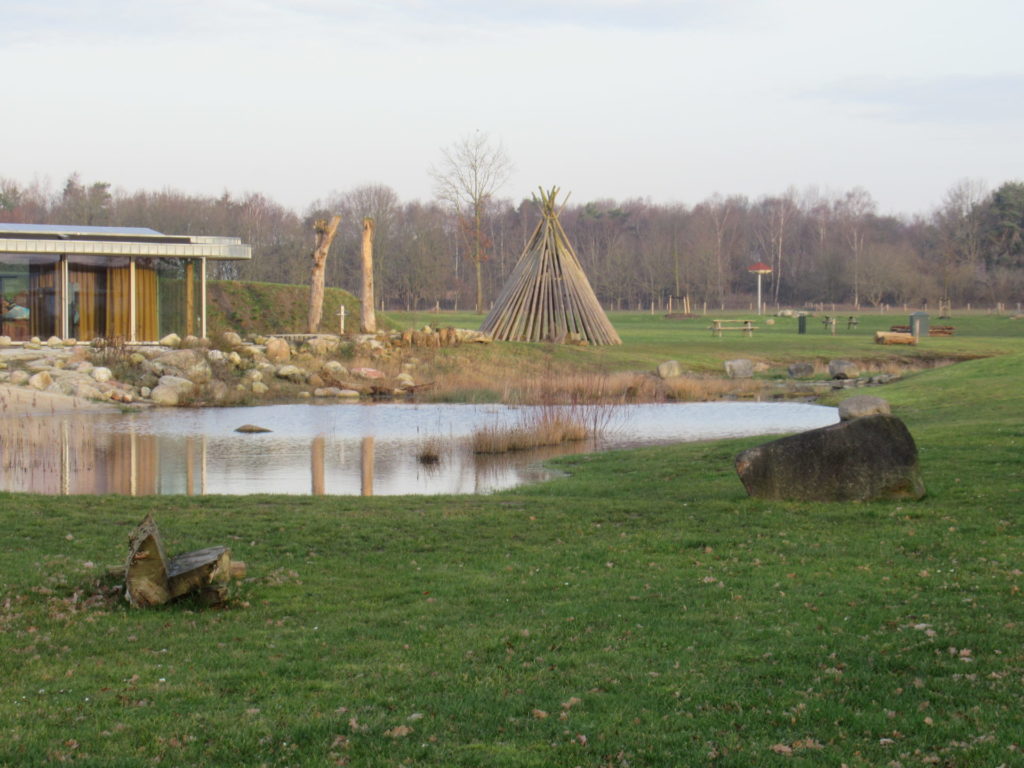
Hello again, and thank you for your ideas, both on and offline, about last week’s grey yarn. More about that project soon, but today’s blog post is about something completely different.
If you’ve been reading my blog for a while, it won’t come as a surprise that making things is an important part of my life. It’s usually something to do with yarn or wool, but I also enjoy excursions into other mediums now and then. Recently I spent a Saturday morning at a nearby visitor centre (above) making something with clay.
The visitor centre is in the same area where I once had an interesting chat with a shepherd. It is, in fact, next to the sheep fold, so I arrived a little early to say hello to the sheep. Good morning!
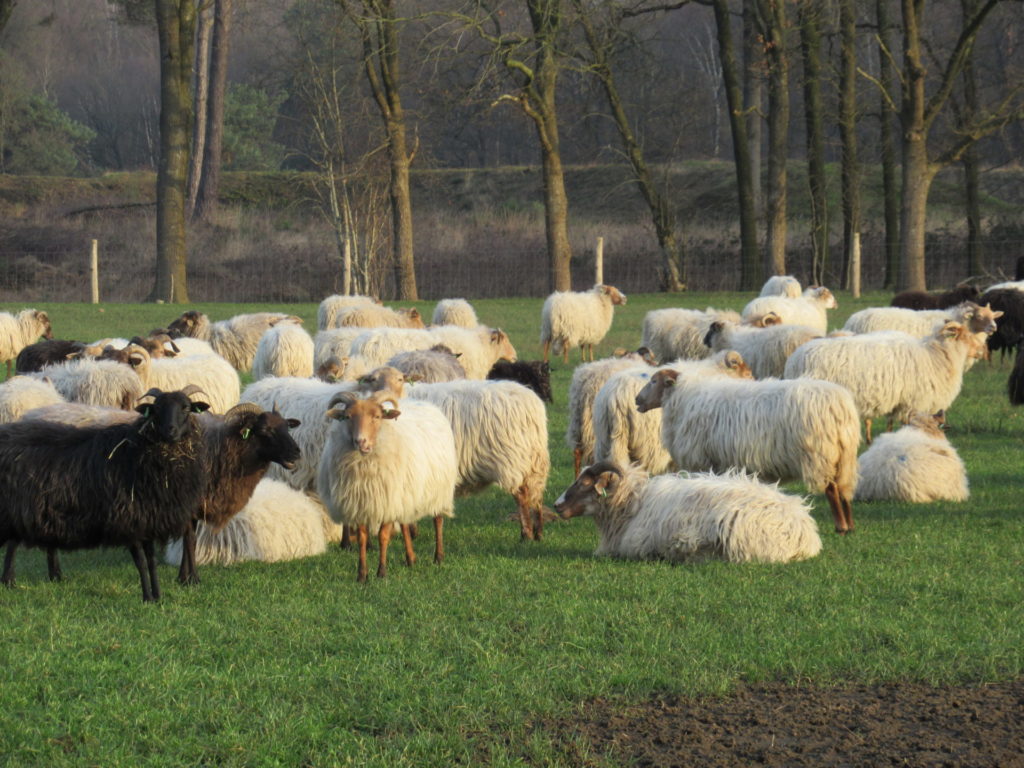
The sheep didn’t answer, but quietly kept munching grass and hay before starting their daily walk on the heath.
Walking on, I ran into this big guy (or gal). Whoa!
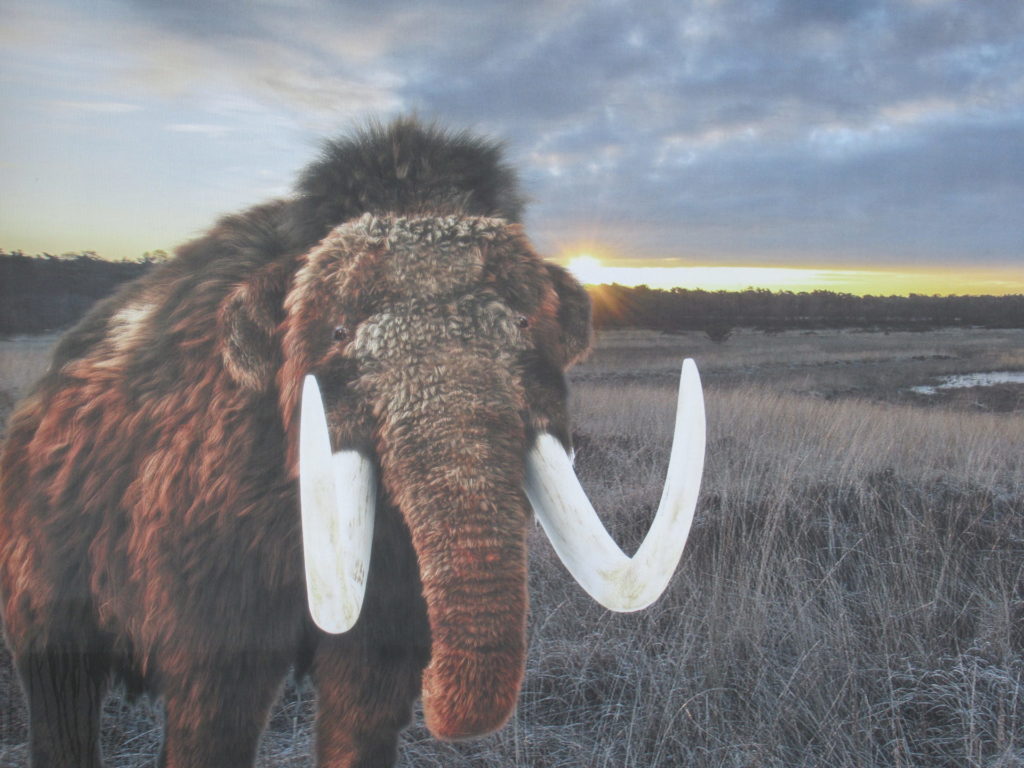
Fortunately it was just a print on a big banner on the outside wall of the sheep fold.
I’m not just including this photo here for fun, but also because this morning was about going back in time. Not quite as far back in time as this mammoth, but almost. Wikipedia tells me that the mammoth died out around 4,000 years ago. On this Saturday morning, we were going back to the funnel beaker culture, which started here around 3,400 years ago.
The morning began with a short talk about the people who became known for their funnel-neck pots, but also made pottery in other shapes. They were not the first inhabitants of this area, but they were the first farmers, and thousands of shards of their pots have been found around here. They are also the people who built the dolmens and tumuli that are still visible in our landscape today.
Well, I can’t tell you everything I’ve learnt, but I can tell you that it was fascinating.
Then it was time to roll up our sleeves and make a funnel beaker ourselves. The artist who gave the workshop had made two examples. This is one of them:

Unlike the original funnel beaker makers, we didn’t have to travel a long way to find the right kind of river clay for our pots. We were given a slab of a similar clay…
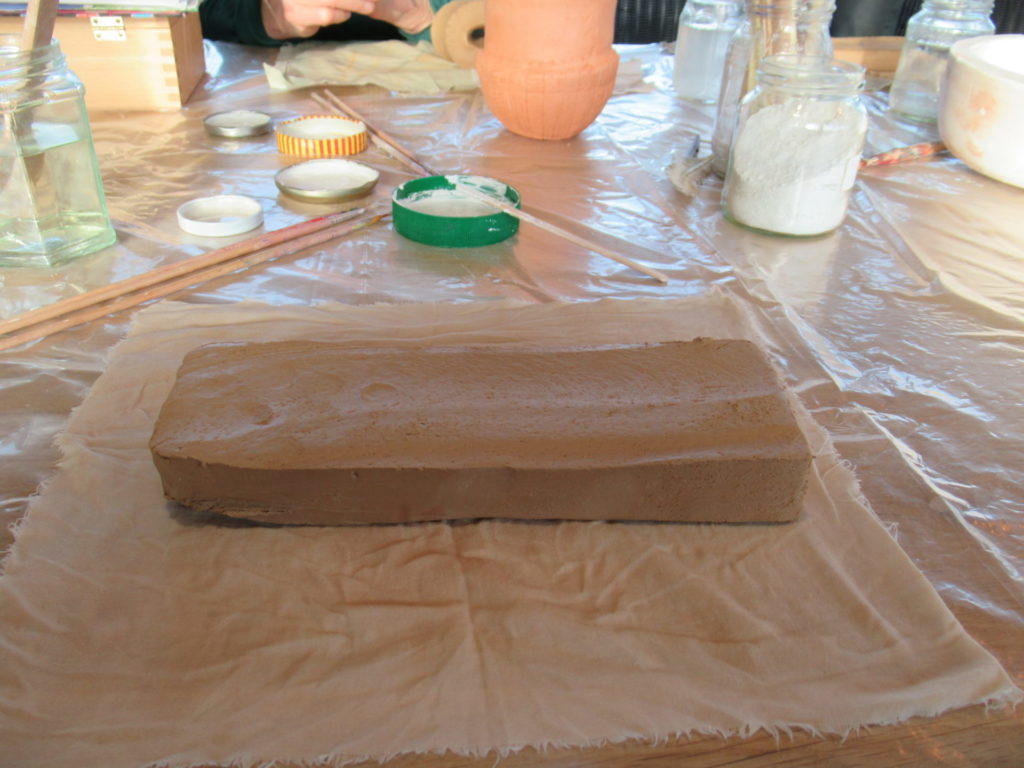
… and started by rolling it out.
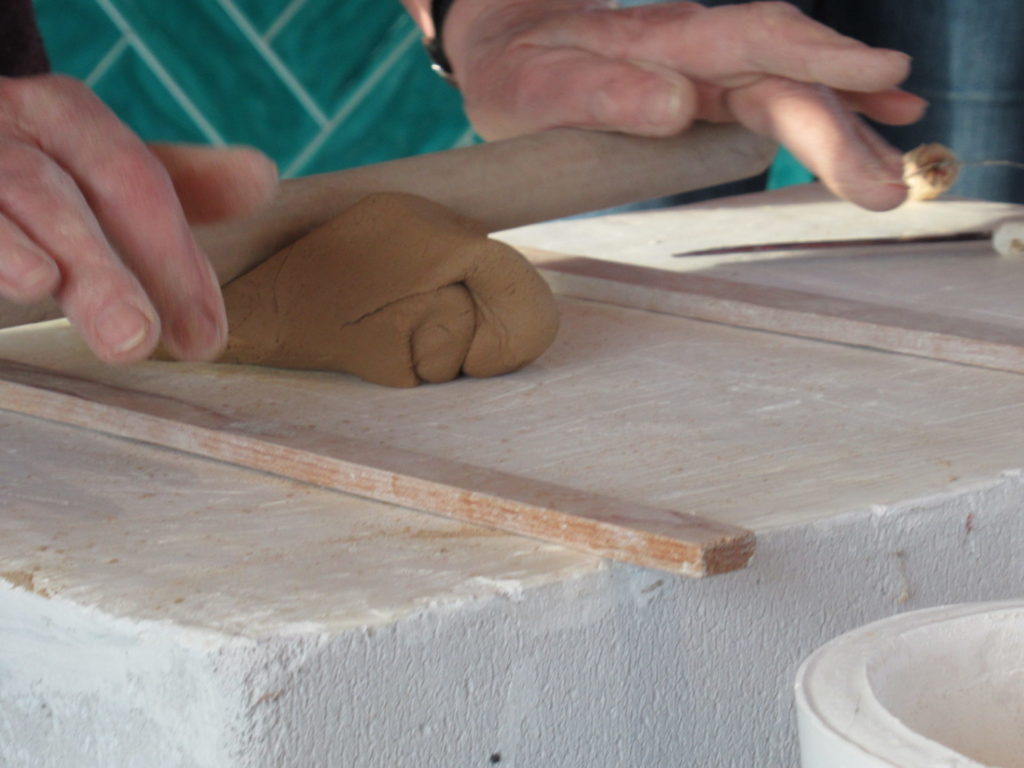
Originally the base would have been shaped by hand, and that’s what some of the more experienced participants also did. For those of us with little or no experience (like me) there were moulds to use.
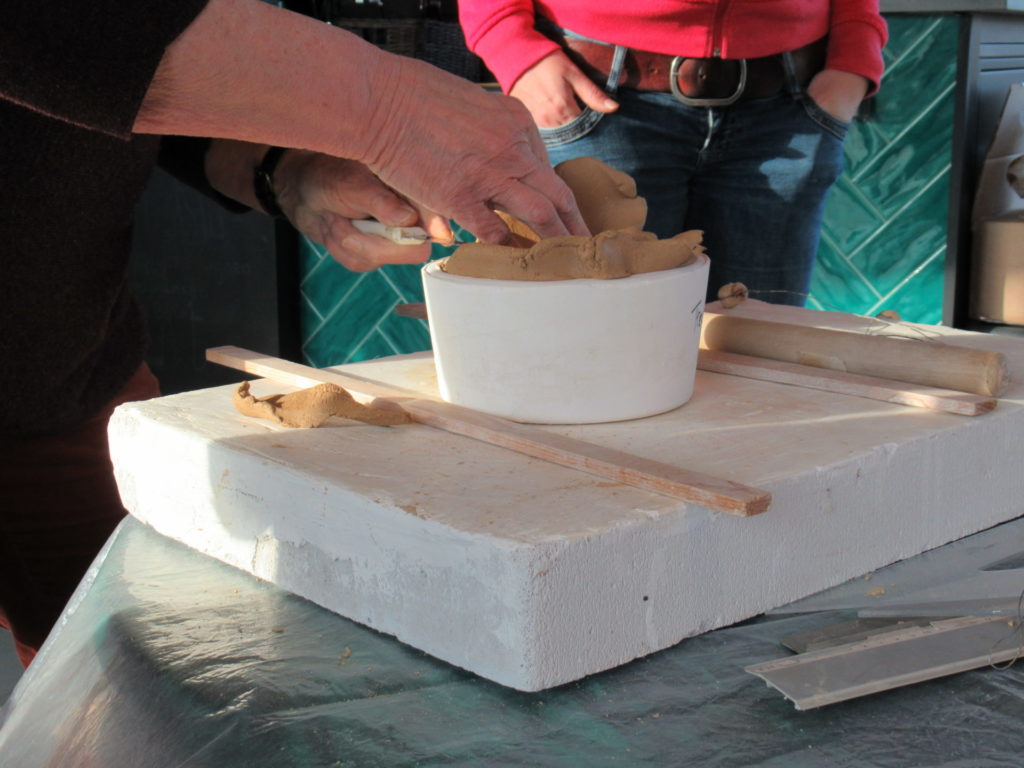
My neighbour at the table was more experienced and had shaped her beaker in no time.
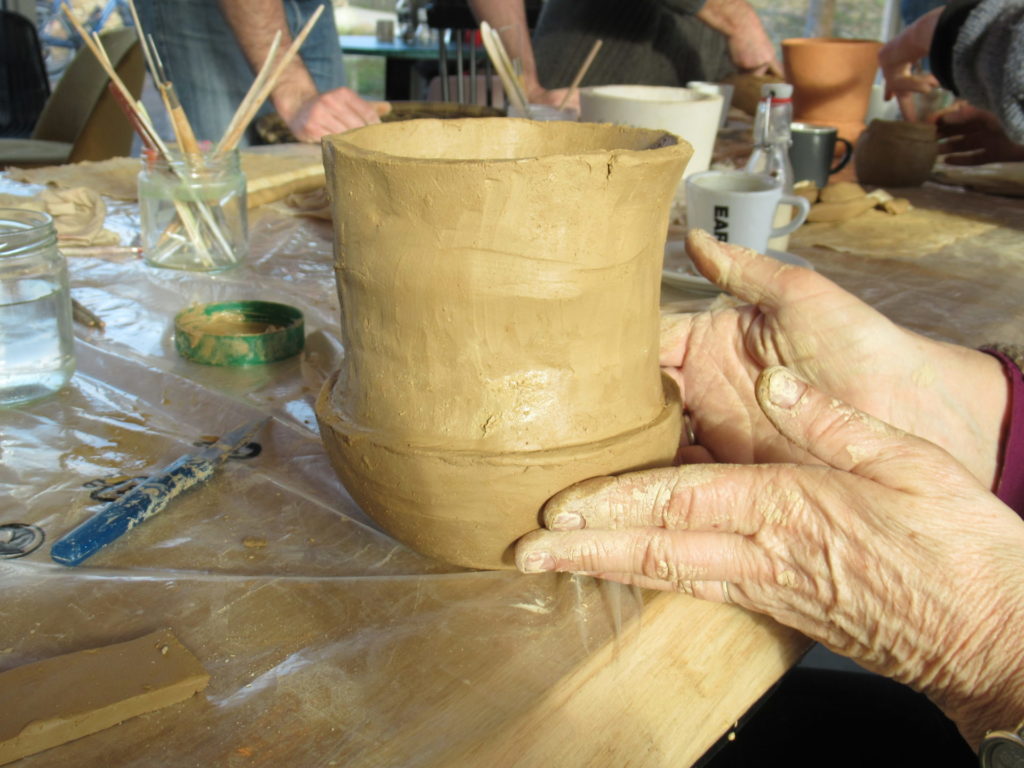
I used too much water to ‘glue’ the next layer onto the base and had to place the beginnings of my pot on a bench outside to dry a little before I could continue, next to those of two other beginners. Mine is on the right.
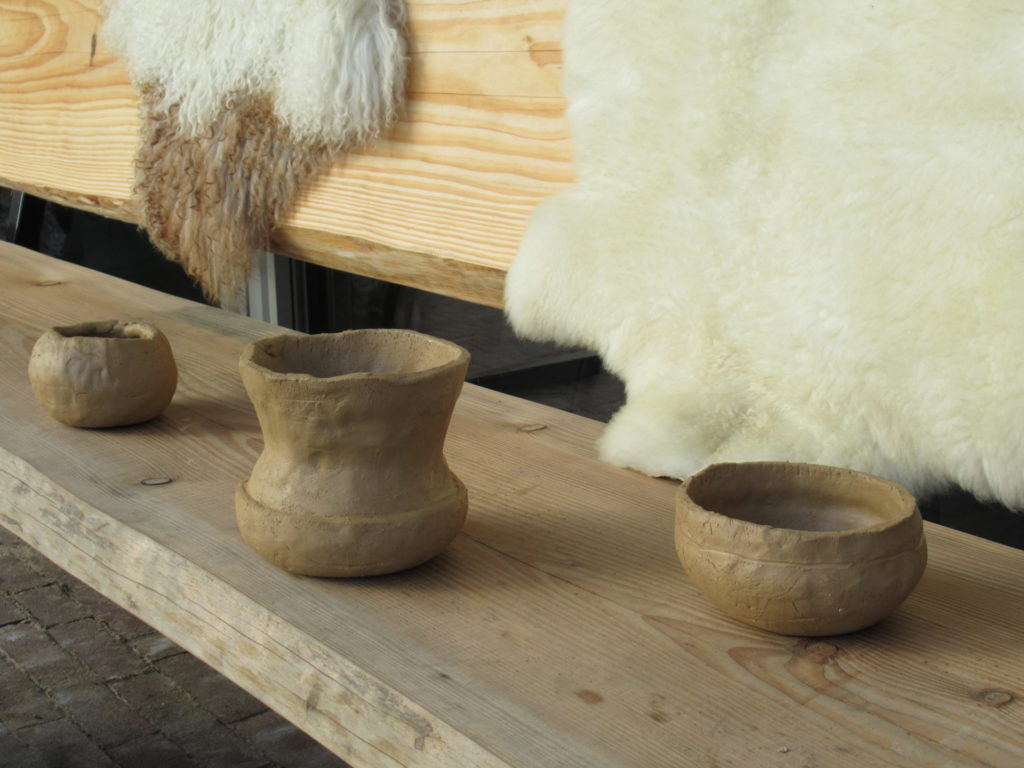
Several hours later we had all made something that looked more or less like a funnel beaker. Some of the pots were fairly small, like the ones that would originally have been used to store seeds. Others were a lot bigger, like the ones used to hold water or as cooking pots.
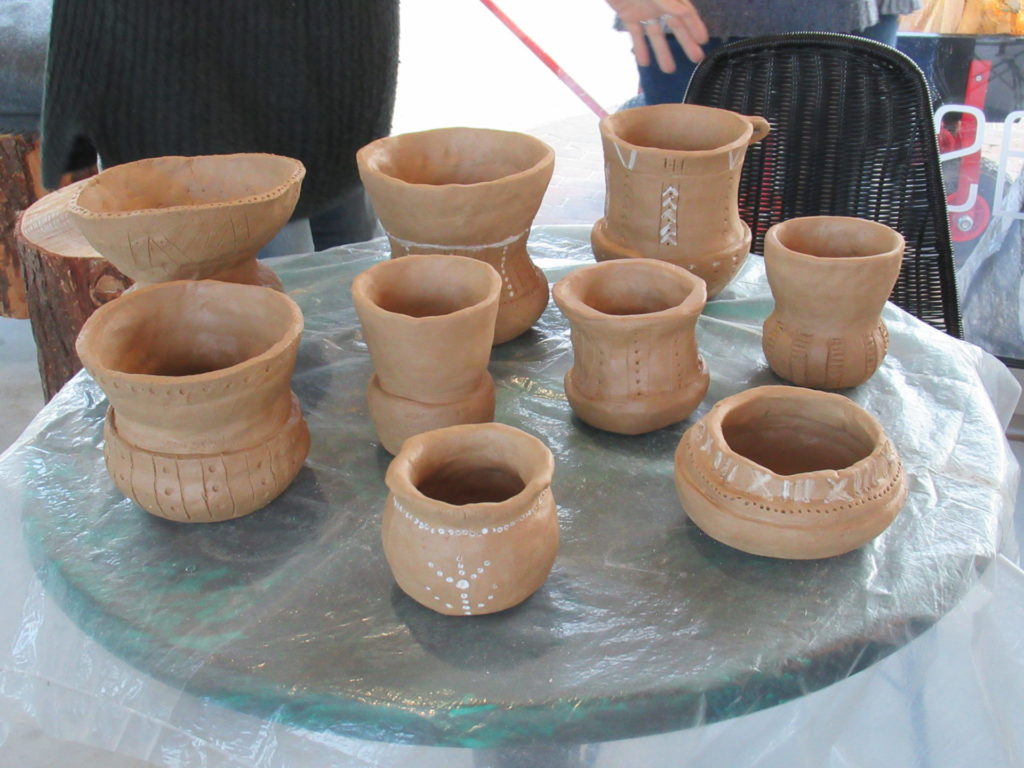
The pottery shards of the funnel beaker culture found around here are often richly decorated. In the past, people used feathers, pieces of wood or bone and their fingernails to make the decorations. I used a spatula for the lines and a stick for the dots on my pot.
It was while I was carefully pressing my stick into the soft clay to make dots, that I suddenly felt transported back a few thousand years. In my mind, I was sitting outside, in front of a wattle and daub dwelling, decorating my pot. There was a piercing wind, but dressed in animal skins, I didn’t feel the cold. I could hear sheep bleating and pigs grunting, and I could smell the sweet smell of the cows grazing nearby. I was looking forward to our meal of lentils and foraged greens. Life was hard and uncertain, but it also had its good moments.
Fast forward to the present, I finished my pot by adding a few details in white. Originally a substance made from ground bones and some kind of binder would have been used, but we used a modern paint of which I’ve forgotten the name.
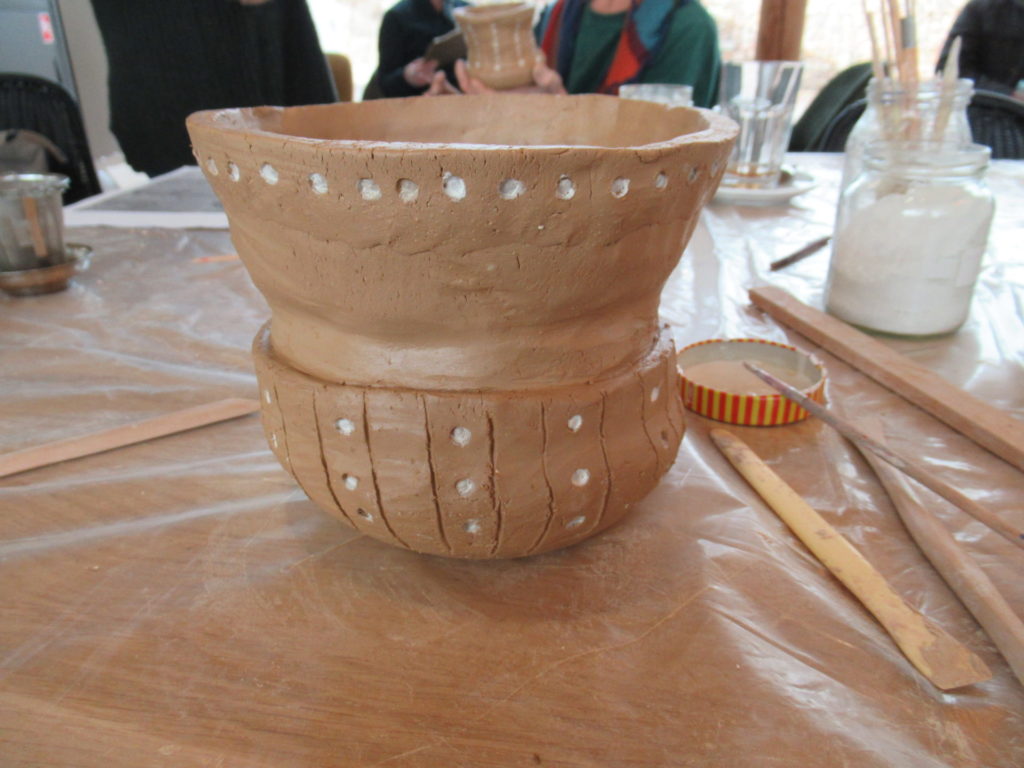
Now my funnel beaker is drying in the artist’s studio, waiting to be fired in her kiln. It should be a soft rosy colour when it comes out. I’m really looking forward to seeing how it’s turned out.
Links:
- The talk about the funnel beaker culture was held by someone from the Oermuseum, a small but interesting museum with archaeological finds and information about how people lived and worked in the north of the Netherlands from the last ice age to the iron age.
- The artist who kindly and expertly taught us how to make a funnel beaker was Elisa van den Berg.
In Love with Making
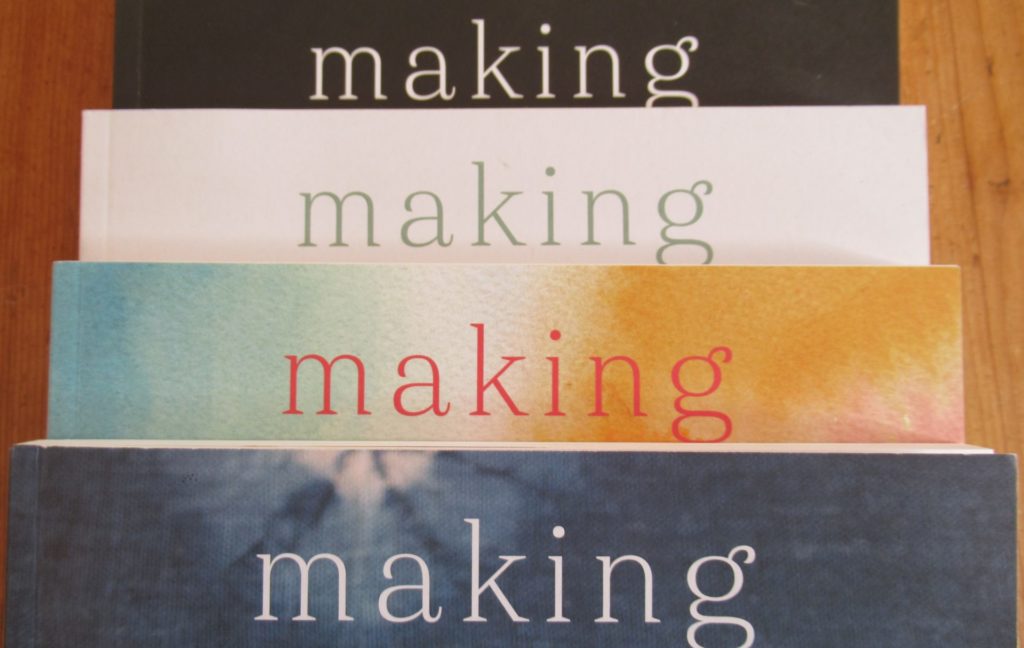
Why make things when we can buy them?
For my Mum it was necessary to make things because they weren’t available in shops or she couldn’t afford to buy them. For me and for my daughter’s generation it’s different. We don’t need to make things and it is, in fact, often less expensive to buy ready-made things than to buy the materials to make them ourselves. So, why still make things?
As always, I can really only speak for myself, but I think we all agree that a home-cooked meal tastes much better than any ready-made meal from the supermarket. There is nothing we can buy that comes close to a hand-knit pair of socks. And would you ever treasure a shop-bought bed covering as much as you do the quilt or the crocheted blanket your grandmother made?
It may sound cheesy, but for me, it’s all about love. Love of the materials, love of colours, love of the people I make things for, love of the process of making. That’s why Making appeals to me so much. Everything about this bi-annual magazine speaks of the love of making things.
In the US one issue costs $ 26,00 and it is around the same price in Euros in the Netherlands. That’s a steep price for a magazine, but… it was love at first sight. And what’s more, the first two issues were themed Flora and Fauna.
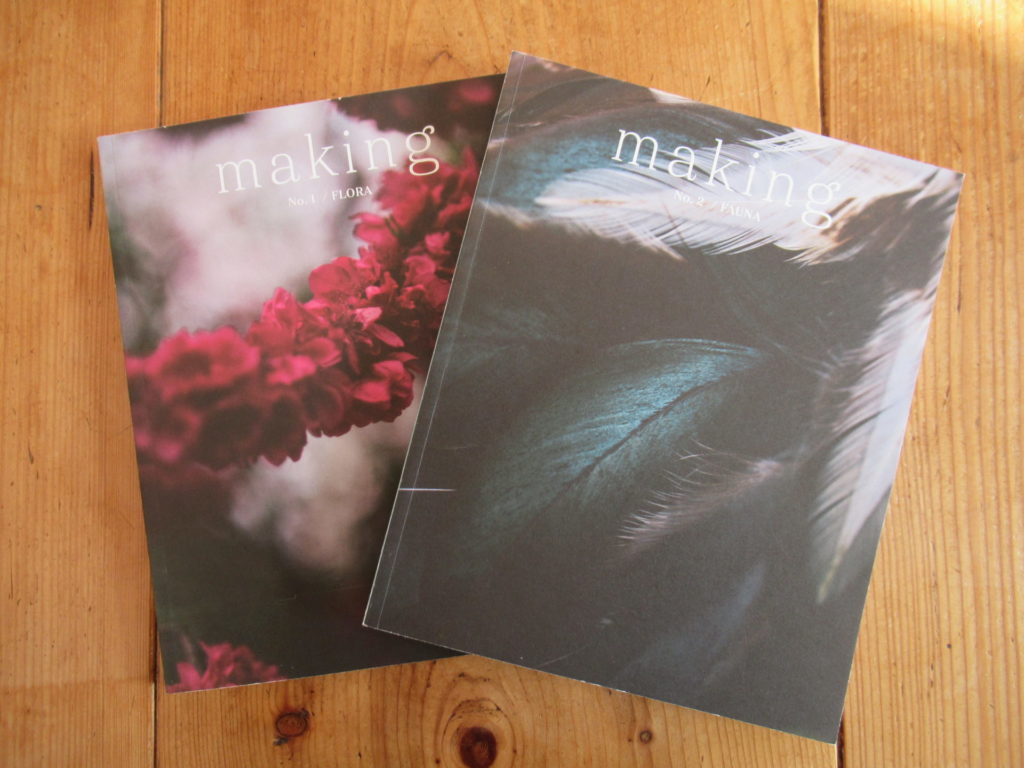
How could I resist?
The people at Making always work with themes. There are always two related themes following each other: Flora and Fauna, Dots and Lines, Color and Black & White, Desert and Forest. I love the whole idea, as well as the projects, the photographs, the stories, the styling and even the ads (there are just a few, they are only on the last few pages, and they are in keeping with the theme).
Knitting is only one of the crafts in Making. There is also weaving, sewing, embroidery, dyeing, felting, rug hooking and much more, as well as a recipe now and then and essays about all kinds of interesting subjects. Some of the projects are small and simple, others a little more complicated.
I brought the third issue, themed Dots, with me on a holiday to Germany a few years back.
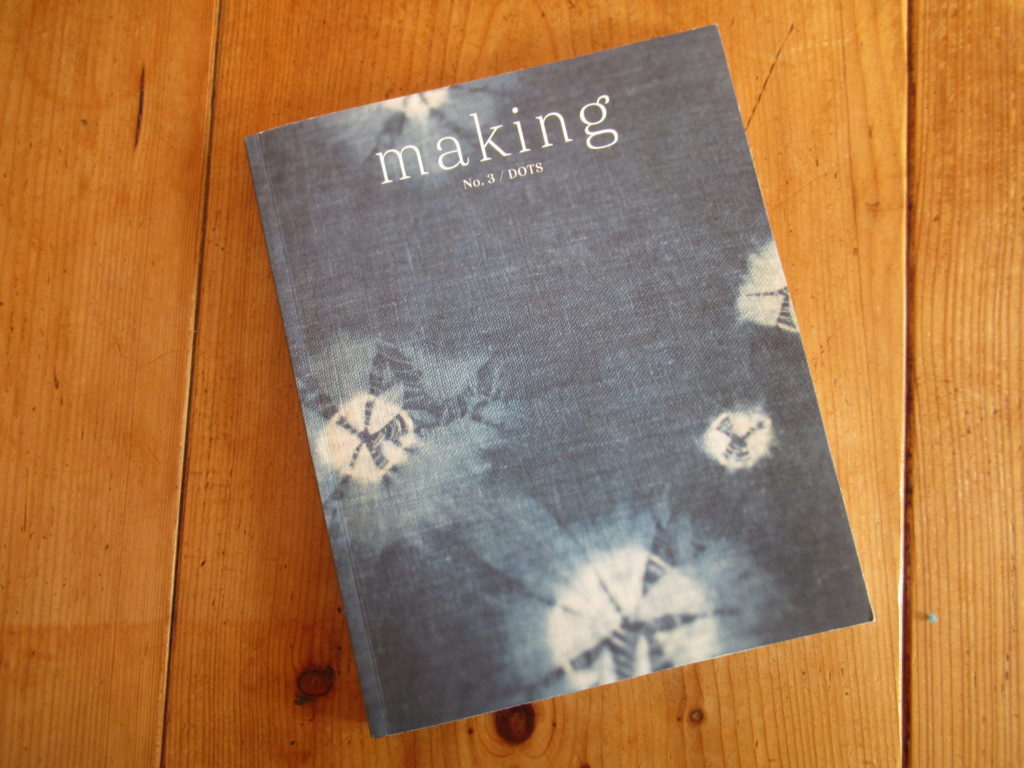
I enjoyed leafing through it when I woke up early in the morning. And I enjoyed studying the photographs and reading the essays in the evenings on the covered porch of our Ferienwohnung, after we’d come back from one of our long walks.
Everything in this Dots issue is in shades of indigo blue or undyed. It isn’t as if everything is covered in polka dots – the dots theme is much more subtle than that. In one of the knitting projects, the triangular Indigo Sea Shawl, the dots take the form of a row of eyelets along one side:
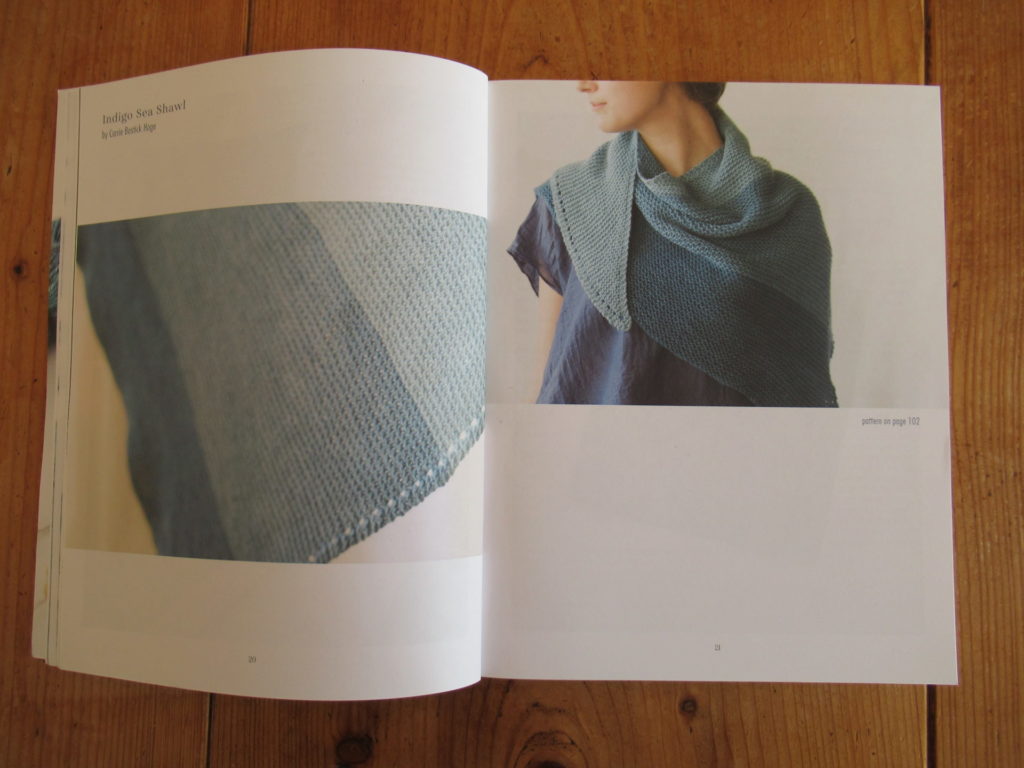
During the same holiday in Germany, I bought yarn for this shawl in a very special yarn shop in a former smithy, a few miles from our holiday home. The pattern specified three 50-gram skeins of a sport weight yarn. With a wingspan of just over a metre it was too small to my liking, so I bought four skeins.
I chose three shades of blue-green (what else?), and then added a grey one for a little contrast.
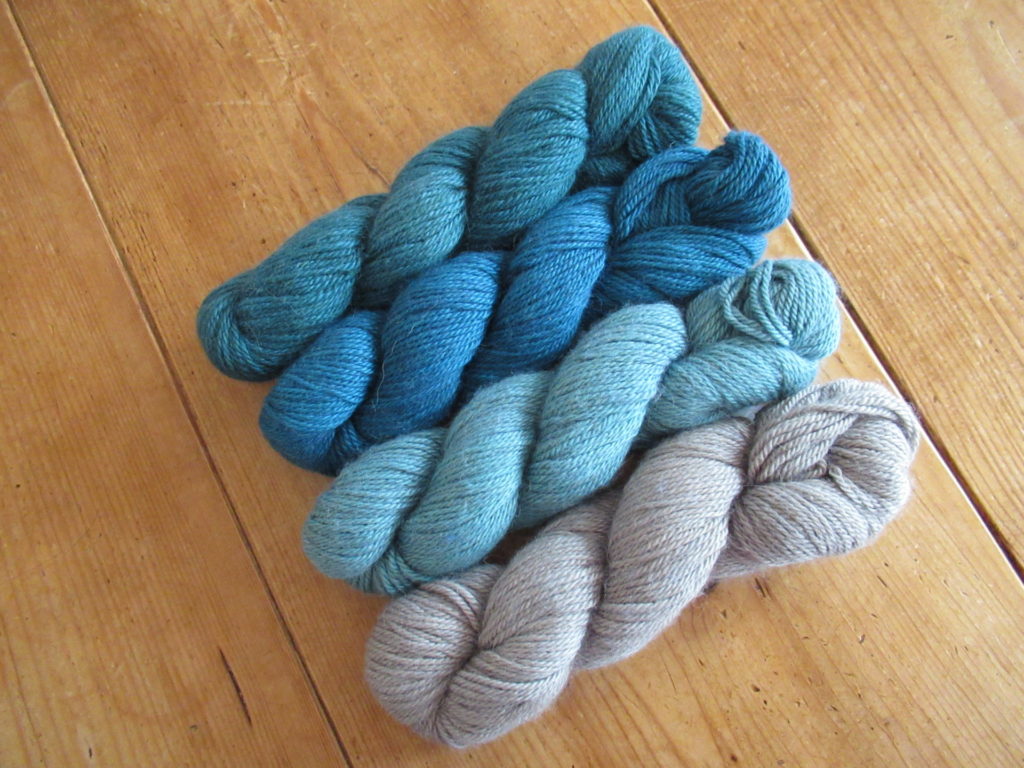
After we got home, I regretted the grey. (It is muddier than in the photo, with a hint of brown.) I didn’t love it and had the feeling that it sucked the colour out of the blue-green shades. I couldn’t go back to change it for a different colour, so I put it away until I knew what to do.
I dug out the yarn for the utterly simple Indigo Sea Shawl recently because I’m desperately in need of another in-between-projects project. Why?
Well, although I love making things, it isn’t always plain sailing. Just as in any important relationship, there are struggles and setbacks from time to time. Right now, I’m puzzling over a new design that isn’t working out as I at first envisioned it. I’m struggling to finish a UFO. And after weeks of waiting, the yarn I’ve ordered for a sweater for our daughter still hasn’t arrived.
So when I saw that Juffrouw Lanterfant (the yarn shop I wrote about last week) stocked the same yarn, I decided to replace the grey with another shade of blue. I photographed the skeins, wound the yarn into balls and took more photographs.
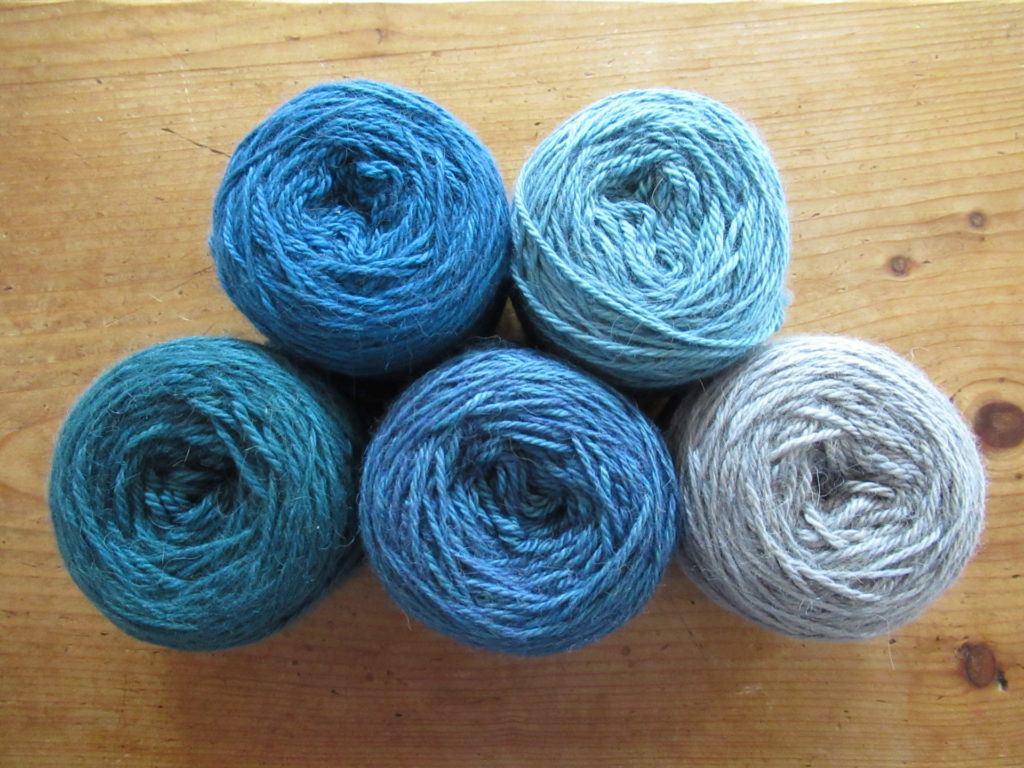
And then, looking at the photographs, I thought: hmmm, perhaps that grey isn’t so bad after all. I still don’t love it, but I don’t hate it anymore either. Maybe it will work in combination with the blues. Maybe it will even be a valuable addition.
So, what shall I do? Embrace a colour I’m not really in love with and give it a chance? Or tell it that I don’t see a future for us together and take it to my knitting group’s yarn swap in March?
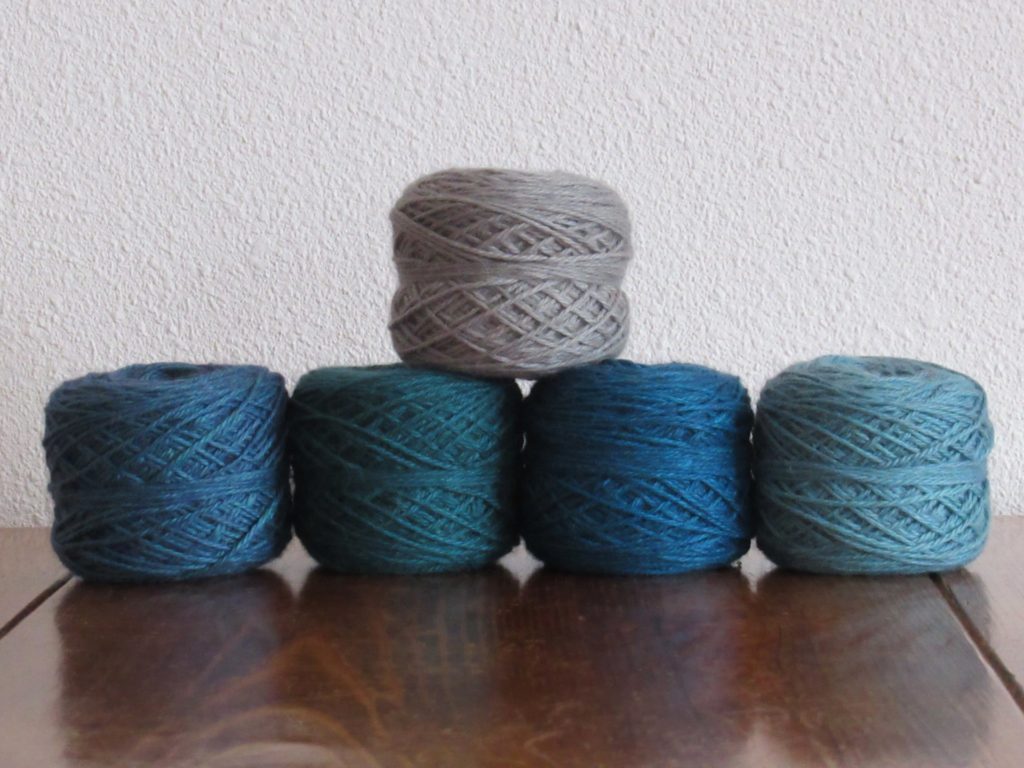
Unfortunately the Dots issue is now out of print. The other issues are still available from some yarn shops and on the Making website.
Miss Lazy Daisy
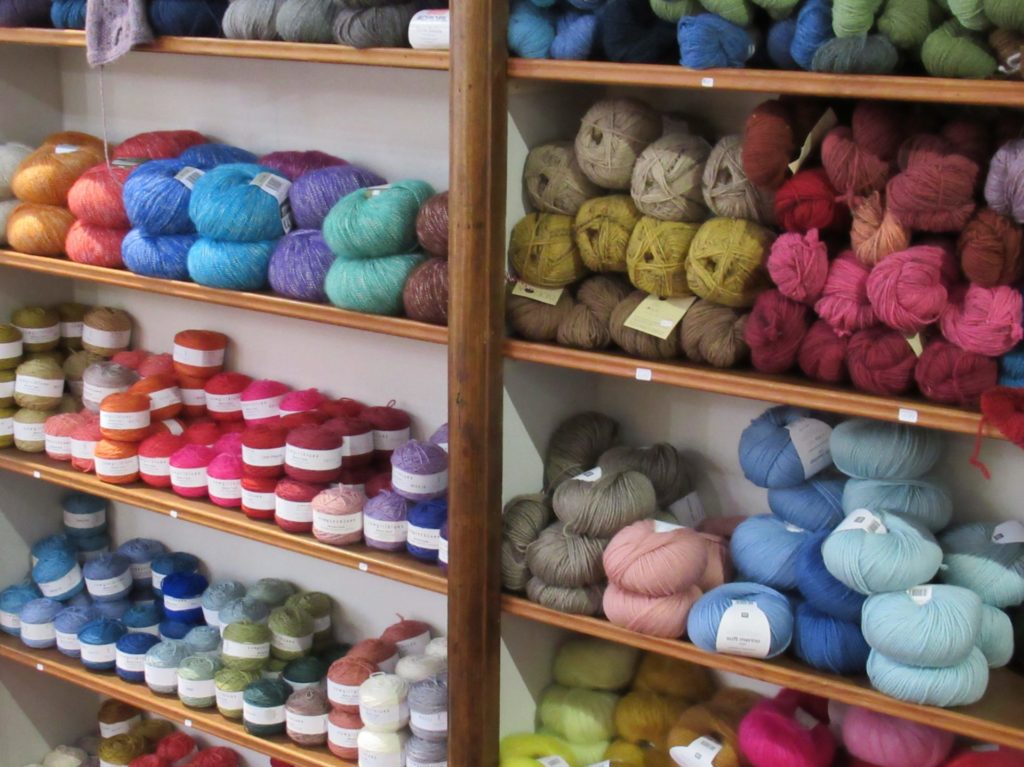
The route to the meeting I was going to attend in the city of Groningen ran right past a yarn shop. Because it isn’t every day that I visit Groningen, I packed my camera and took an earlier train to have some time to browse around and take pictures.
After a short walk from the railway station, I stood in front of Juffrouw Lanterfant (which translates into something like Miss Lazy Daisy). It is a corner shop with an old, tall and narrow door and other lovely old details.
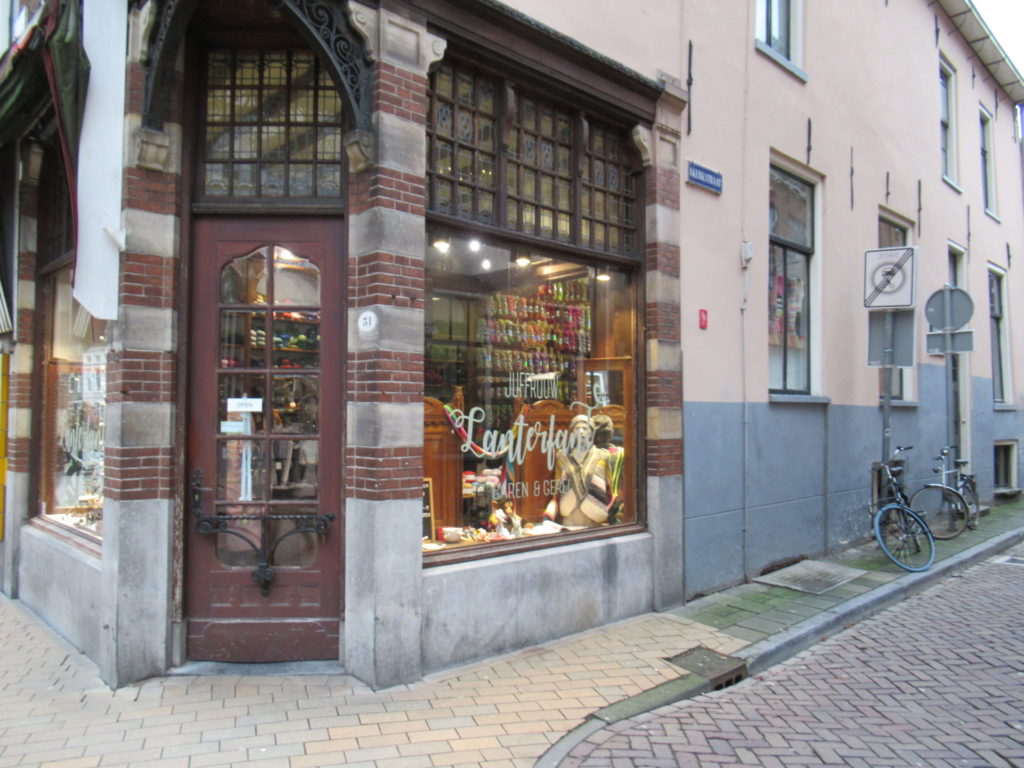
As soon as I entered, I was dazzled by the wall of brightly coloured skeins of yarn. I’m not entirely sure, but I think these are from Hedgehog Fibres:
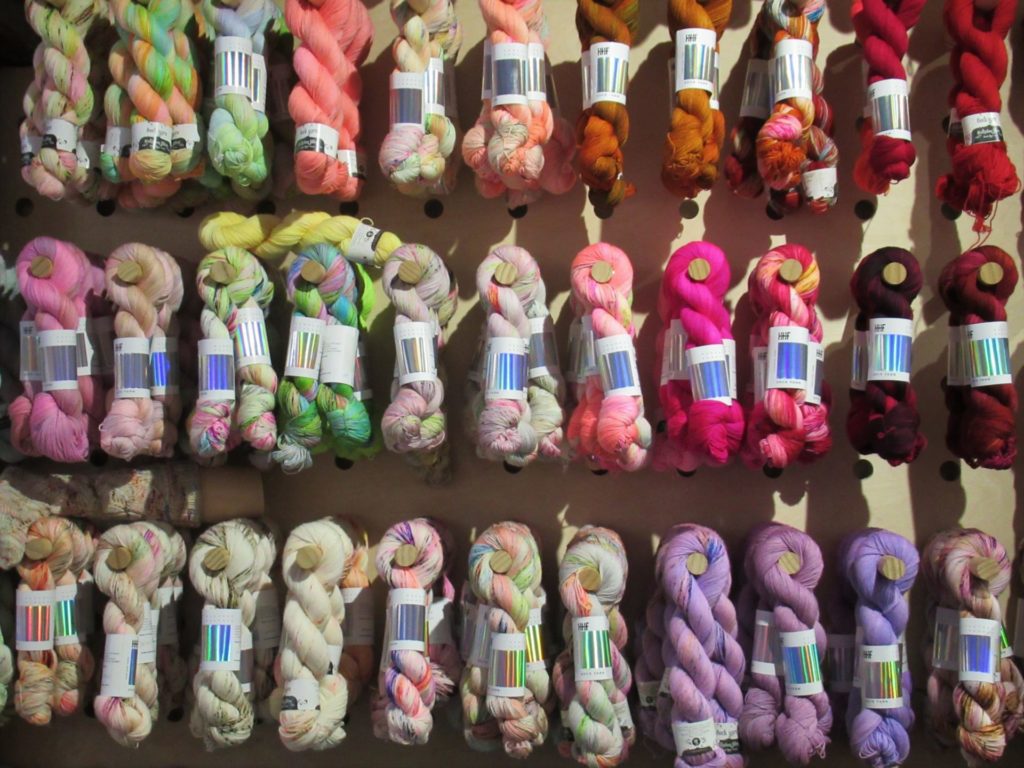
Just the thing for a Stephen West design. I have met Stephen several times and know first-hand that he is a very friendly person as well as an incredibly prolific designer. Although we have very different tastes, I think what he is doing is really, really interesting and highly original.
On a coat rack there were several shop samples of shawls, loops, cardigans and sweaters. The short-sleeved top with the attractive all-over pattern and lovely neckline is ‘Sanctuary’ from Pompom Quarterly #29.
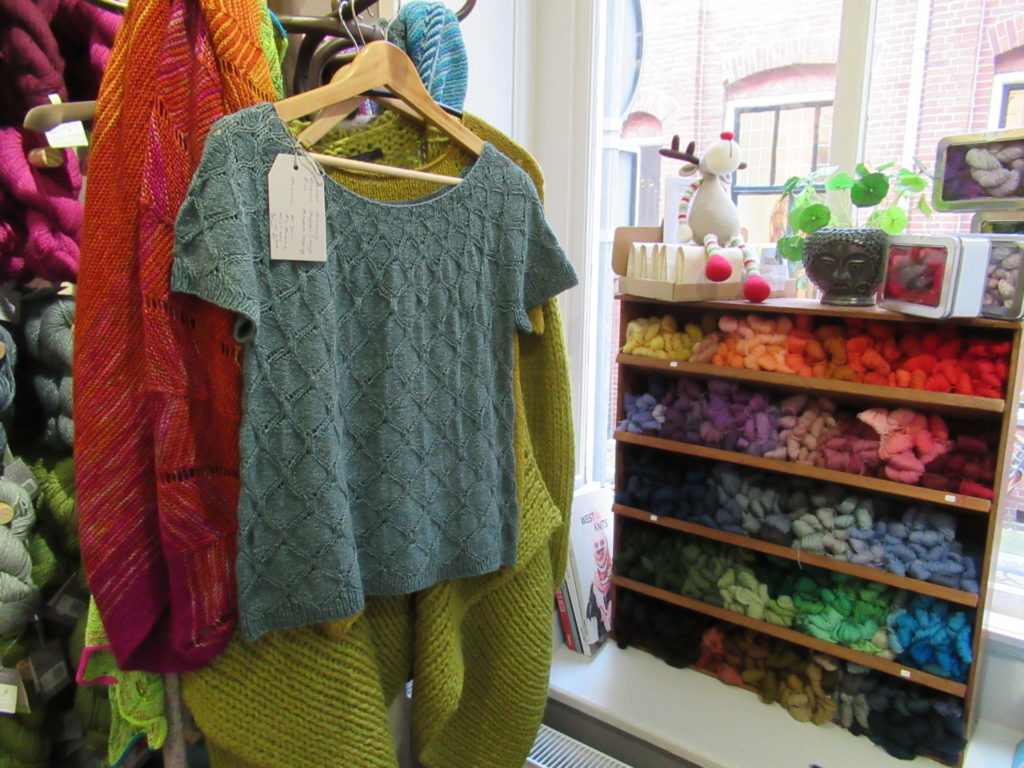
And, oh, that beautiful rainbow of colours in the small cupboard to the right of it! That must be Appletons crewel wool.
And what do I spy on the top shelf?
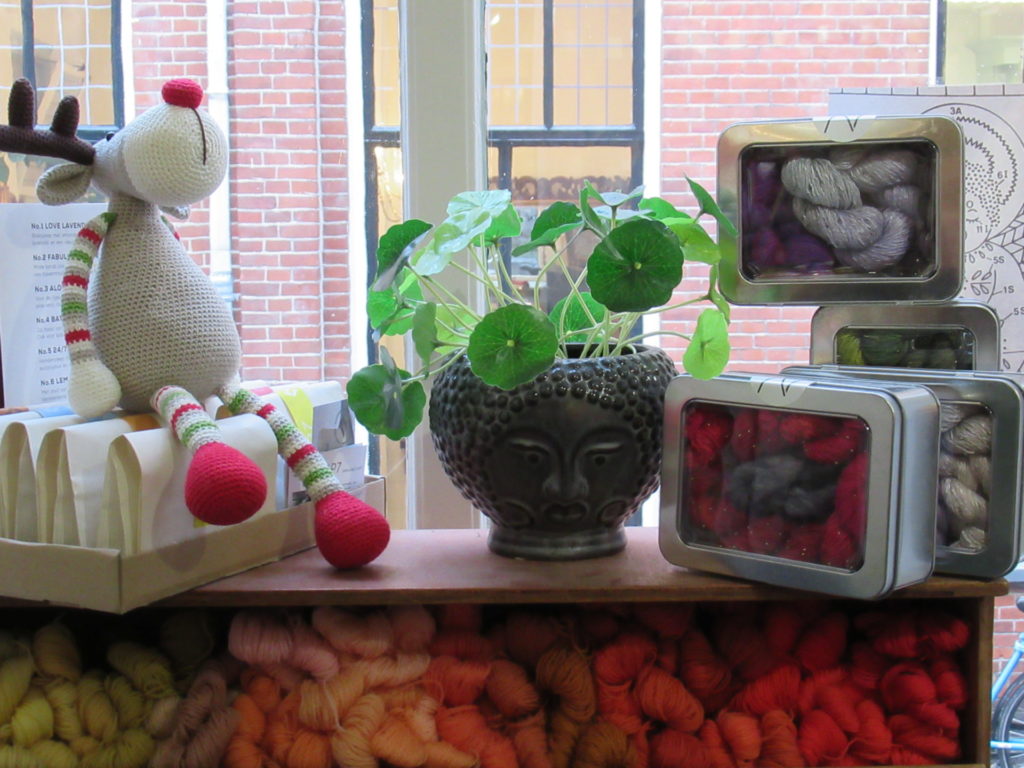
Several gift boxes filled with ArtYarns’ luxurious fibres embellished with beads or sequins. I once splashed out on one single skein of those, a silvery yarn with beads AND sequins. ArtYarns are a bit too blingy for an entire shawl to my taste, but in combination with other, quieter yarns – yum!
At the other end of the spectrum, the shop also stocks Icelandic Létt Lopi. A rustic, really woolly, sheepy yarn.
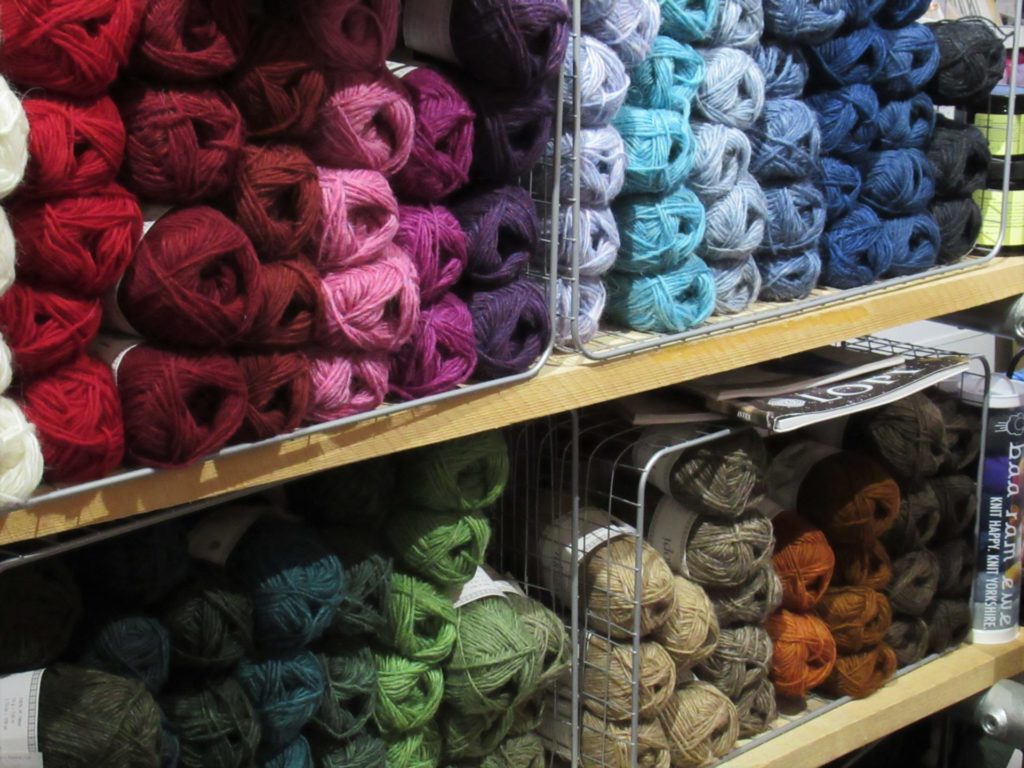
The shop lady was knitting a humongous shawl from it, in black, grey and white with fluorescent pink accents. She said it would be about 4 metres long when finished. Here it is, laid out on the reading table:
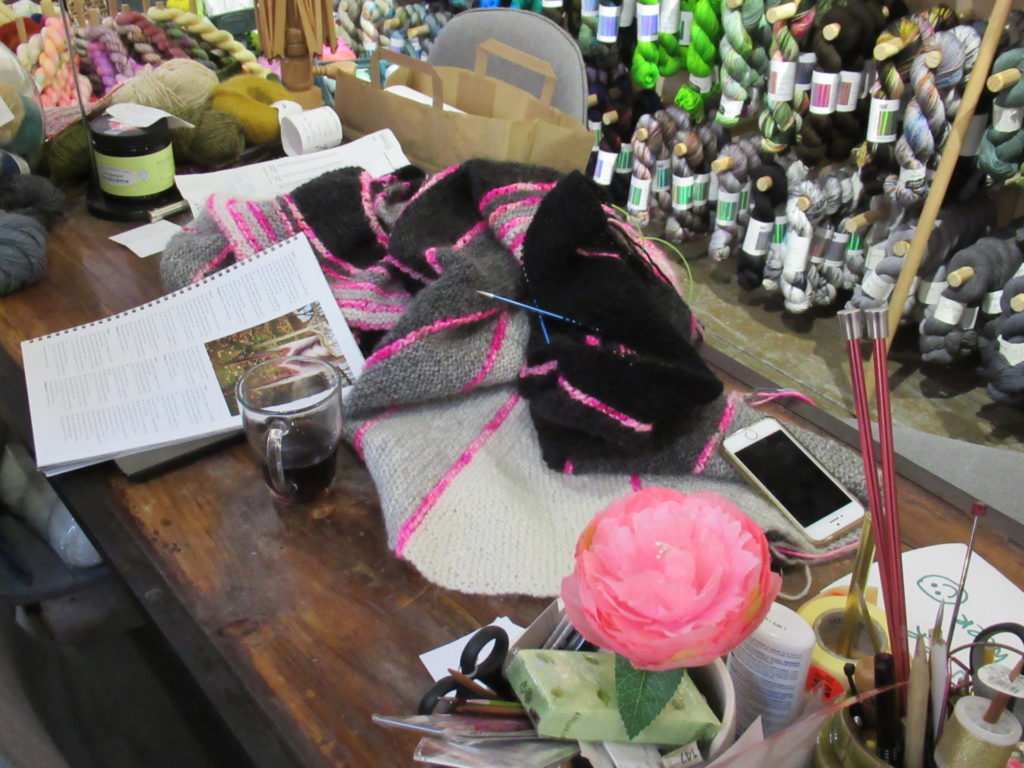
I love it when a yarn shop has a big table like this, even though (or perhaps especially if) it is rather messy. Nowadays, yarn shops aren’t just about buying yarn. They are also great places to find inspiration, leaf through new knitting books and meet other makers.
Having said that, I did buy something – one beautiful skein of yarn to complement several others I once bought in Germany:
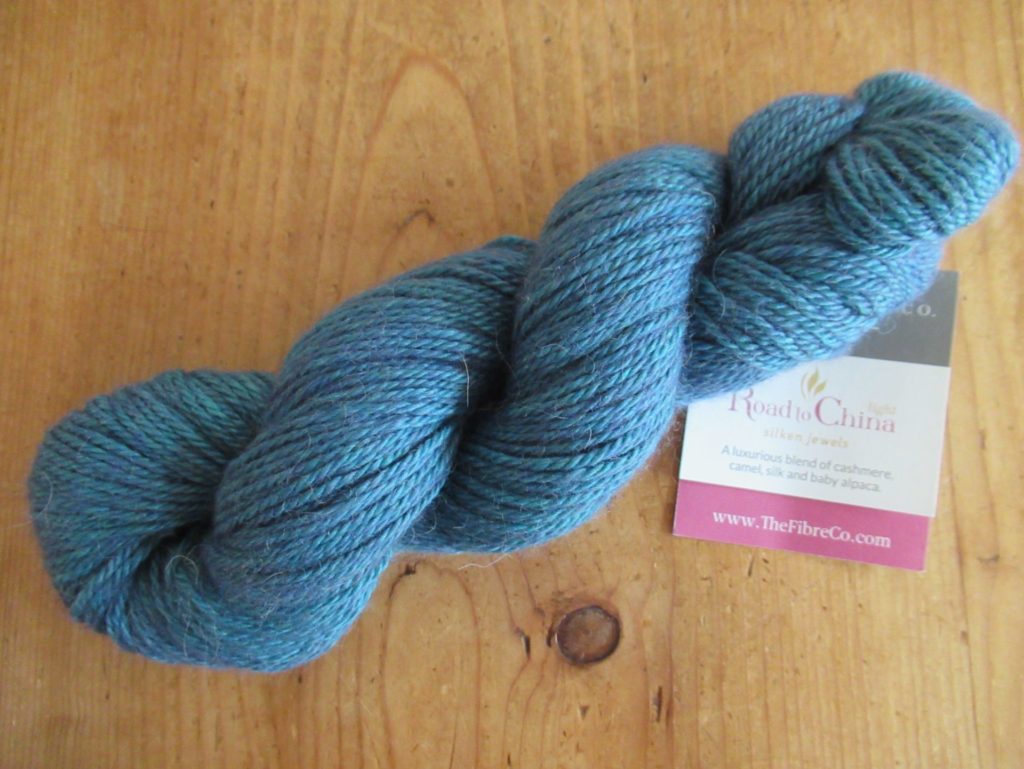
If you’re ever in the area, do pop into Juffrouw Lanterfant. Their address and most (but not all) of the yarns they stock are on their website.
This blog post isn’t sponsored in any way. I sometimes write about yarn shops because I love chatting about the materials I choose and use, and also because I think it may be of interest to other knitters. I feel a bit silly repeating this every time, so I have now altered my ‘About’ page to explain once and for all that I don’t have a hidden agenda.
